
Suunto has just announced the Suunto Race S, a smaller and lighter version of the Suunto Race they announced last fall. Except, it’s got more features, better accuracy, and is substantially cheaper. Unlike some of their competitors, it appears Suunto is actually listening to what their customers want. Well, mostly anyway.
The new Suunto Race S includes some big-ticket features people have been asking for, such as a Suunto Climb Guidance (a ClimbPro-like feature), better heart rate sensor accuracy, more watch face customization, and better UI responsiveness. Plus, a boatload of other items. In many ways, we start to see Suunto being able to focus on some of the smaller tweaks that people want, as opposed to being stuck on playing catch-up on big-ticket items. Not to say there still aren’t some much-needed omissions, but Suunto is clearly starting to find their groove here.
Before we get into it, note that Suunto provided a media loaner Suunto Race S watch to test. As usual, I’ll get that back to them here shortly. I’ll go out and pick up my own to continue testing the new features once they arrive. If you found this review useful, you can use the links at the bottom, or consider becoming a DCR Supporter, which makes the site ad-free, while also getting access to a mostly weekly video series behind the scenes of the DCR Cave. And of course, it makes you awesome.
With that, let’s get into the new bits!
What’s New:
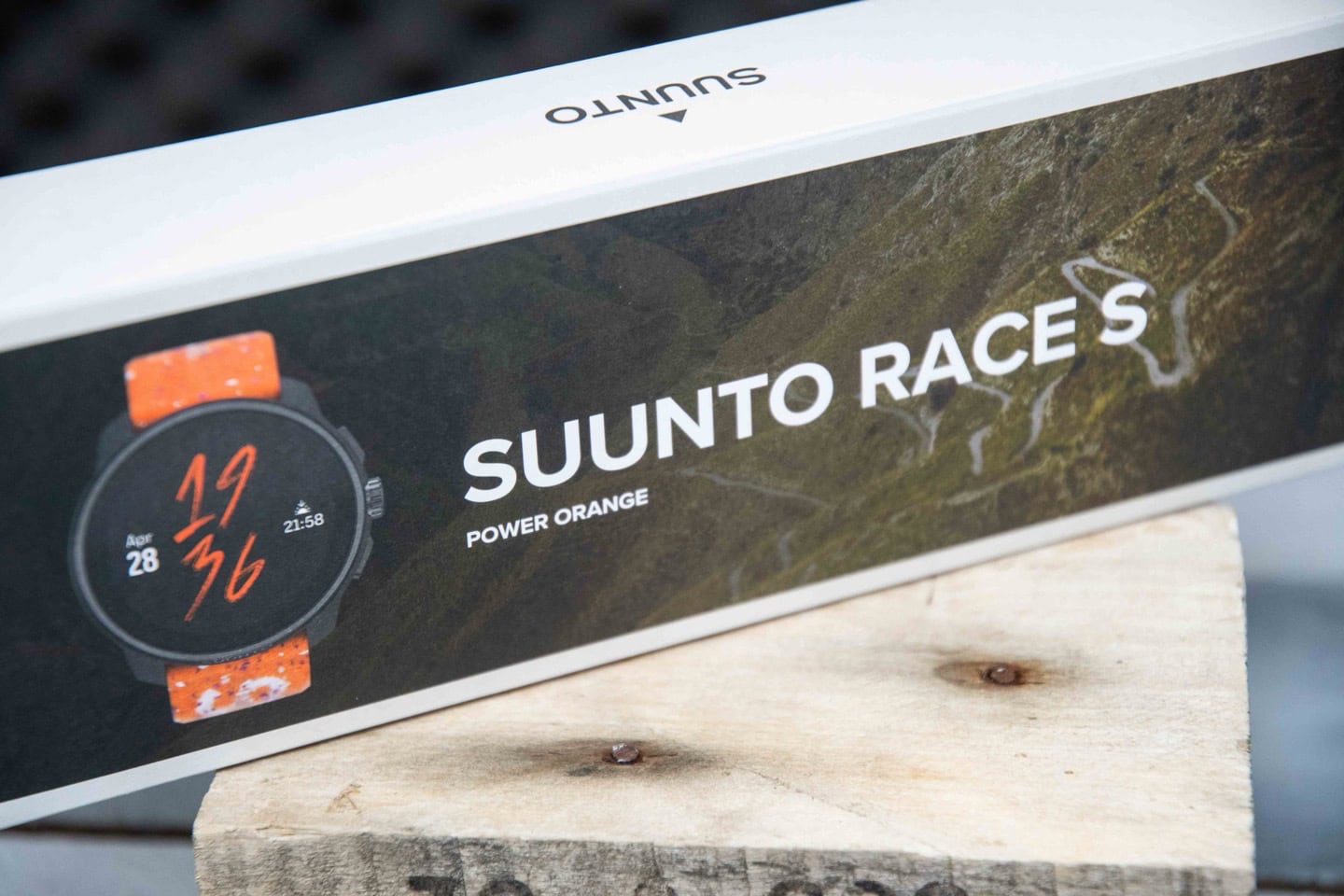
The Suunto Race S is obviously new hardware, namely in that it’s smaller hardware. But, it’s also got some updated internals too – such as the new optical heart rate sensor. And then, on the software side, there’s a slate of updated features. All of these features are going to the existing Suunto Race (as well as Suunto Vertical and Suunto 9 Peak Pro). Thus, all those continue to get updated from a software standpoint.
Here’s what’s new (as compared to the existing/larger Suunto Race):
– Suunto Race S is a 45mm case size with a 1.32” AMOLED touchscreen
– New optical HR sensor design
– Manufactured in Finland (see notes below)
– Added Suunto Climb Guidance (a ClimbPro-like feature)
– Added three new watch faces
– Added ability to customize watch faces, coloring, and complications (from the watch)
– Added colorful emojis (as opposed to black/white stenciled emojis)
– Increased from 300 emojis to ~1,000 emojis
– Increased performance/responsiveness of the user interface (doesn’t suck anymore)
– Added sport-mode-specific display settings (e.g., brightness/etc…)
– Added new paused screen (lets you see workout data screens when paused)
– Increased map zoom level up to 20KM (from 2KM)
– Reduced turn-by-turn notifications to just the bottom of the screen (versus full-screen takeover)
– Added more than half a dozen Suunto Apps as part of the June 2024 update (including Moxy sensor support)
– Adding menstrual cycling tracking in the Suunto App (manual logging/tracking at this point)
– Improved step counter to reduce misdetection (e.g. reducing teeth brushing steps)
– Added Vietnamese language support
– Increased map storage to 32GB (from 16GB for the stainless steel Race)
– 28% lighter weight than the Suunto Race (60g vs 83g)
– 14% thinner than the Suunto Race (11.4mm for S vs 13.3mm)
– Has 50m waterproofing, instead of 100m on Suunto Race
– Maintains 100% carbon offset inclusion
– Maintains dual-frequency/multiband GNSS
– Maintains same 22mm band/strap design
– Glass is Gorilla Glass (versus sapphire crystal on Suunto Race)
– Stainless steel bezel
– Priced at $349/349EUR
In terms of manufacturing, Suunto is bringing back manufacturing to Finland for the Suunto Race S. With the Suunto Race, that manufacturing was done in China. The Suunto Race S though will eventually be manufactured in two different places, depending on where shipments are going. For the Americas, Europe, and likely South Africa distribution, it’ll be units from Finland. Whereas for Asia, it’ll be units made in China. Suunto noted that there may be temporary edge cases where units come from one area versus the other, but on the whole, that’s the plan. That said, to begin, manufacturing is only initially in Finland. Down the road it’ll be started/ramped up in China. [Update Oct 2024: Suunto has decided to shift all manufacturing to China for the Suunto Race S, for the time being. This is following initial batches being made in Finland, but also following organizational shifts that resulted in layoffs and cost-cutting. It’s no secret Suunto and Polar have been struggling financially for some time, and this is one of the steps the company is making to try and become more viable.]
Here’s a quick chart comparison between the Suunto Race & Suunto Race S, from a specs standpoint:
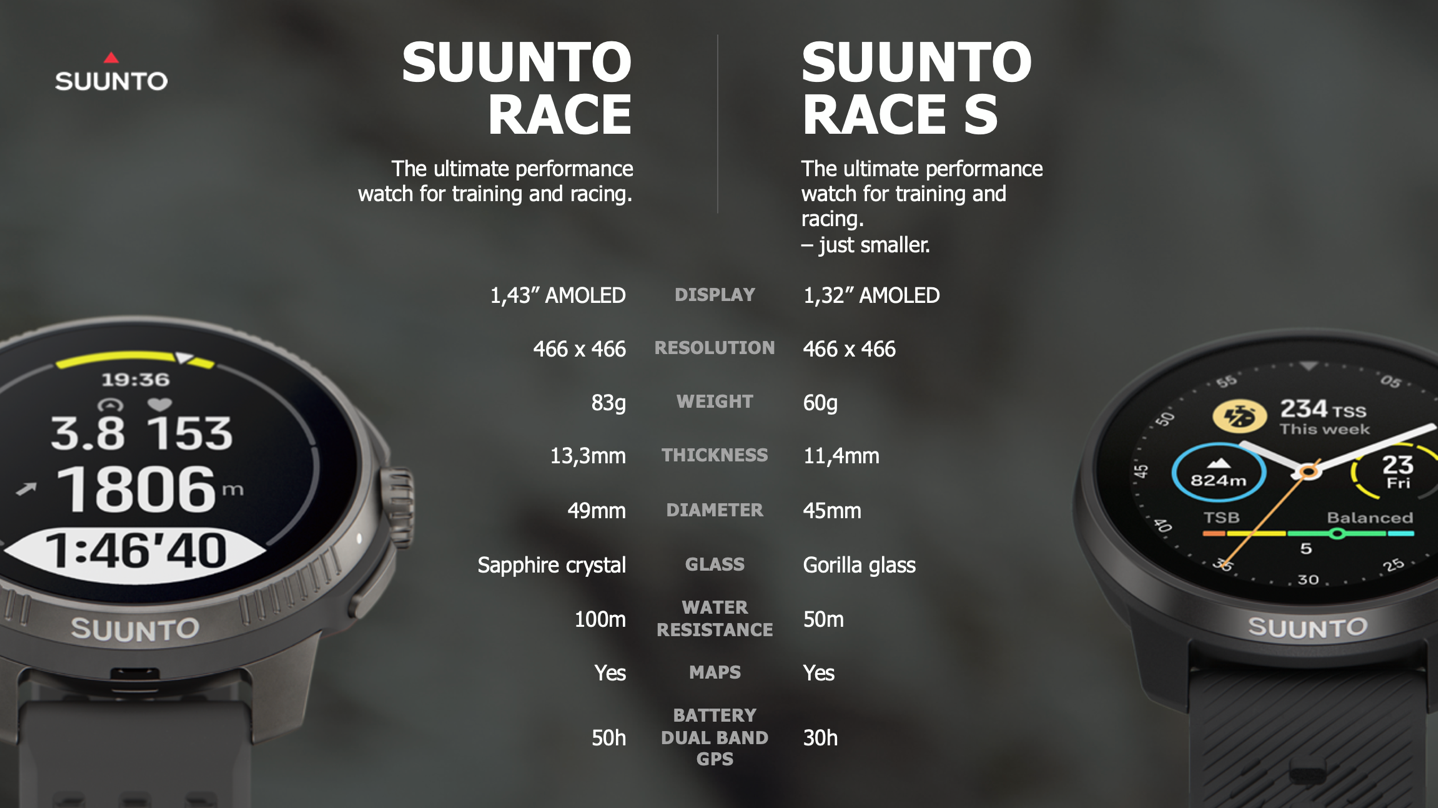
Here’s the official battery chart for the Suunto Race S:
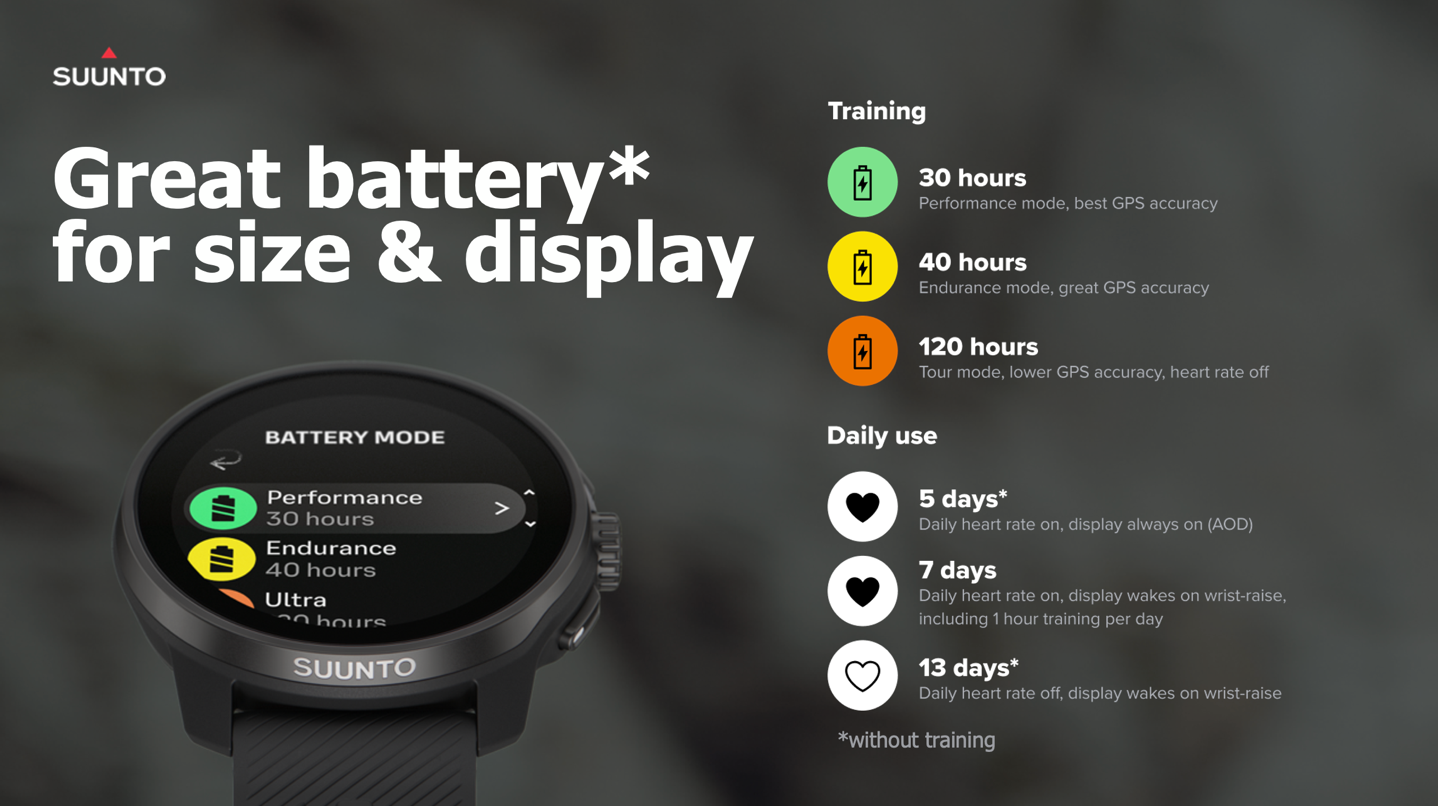
I will say, that these battery life values for the Daily Use section seem very optimistic based on my testing. I’m seeing about 3-4 days for always-on display (albeit with roughly an hour training per day), and about 5ish days battery life with AOD off (with an hour or so per day GPS training). The GPS battery rates have been spot-on.
Got all that? Good, let’s get cooking.
The Basics:

In this section I’ll focus on the day-to-day usage of the watch from a usability, widgets, activity/sleep tracking standpoint, as well as other non-sports focused areas. In the next sections I’ll cover sports/training features, then navigation/mapping features. Very little of this has changed from the previous Suunto Race unit launched less than a year ago, but for those bits that are new, I’ll dive into the differences.
The Suunto Race has both buttons, as well as a Digital Crown. The Digital Crown is used for navigating up/down lists, as well as zoom in/out on maps. This is in addition to the two other buttons above/below it, and the touchscreen itself.
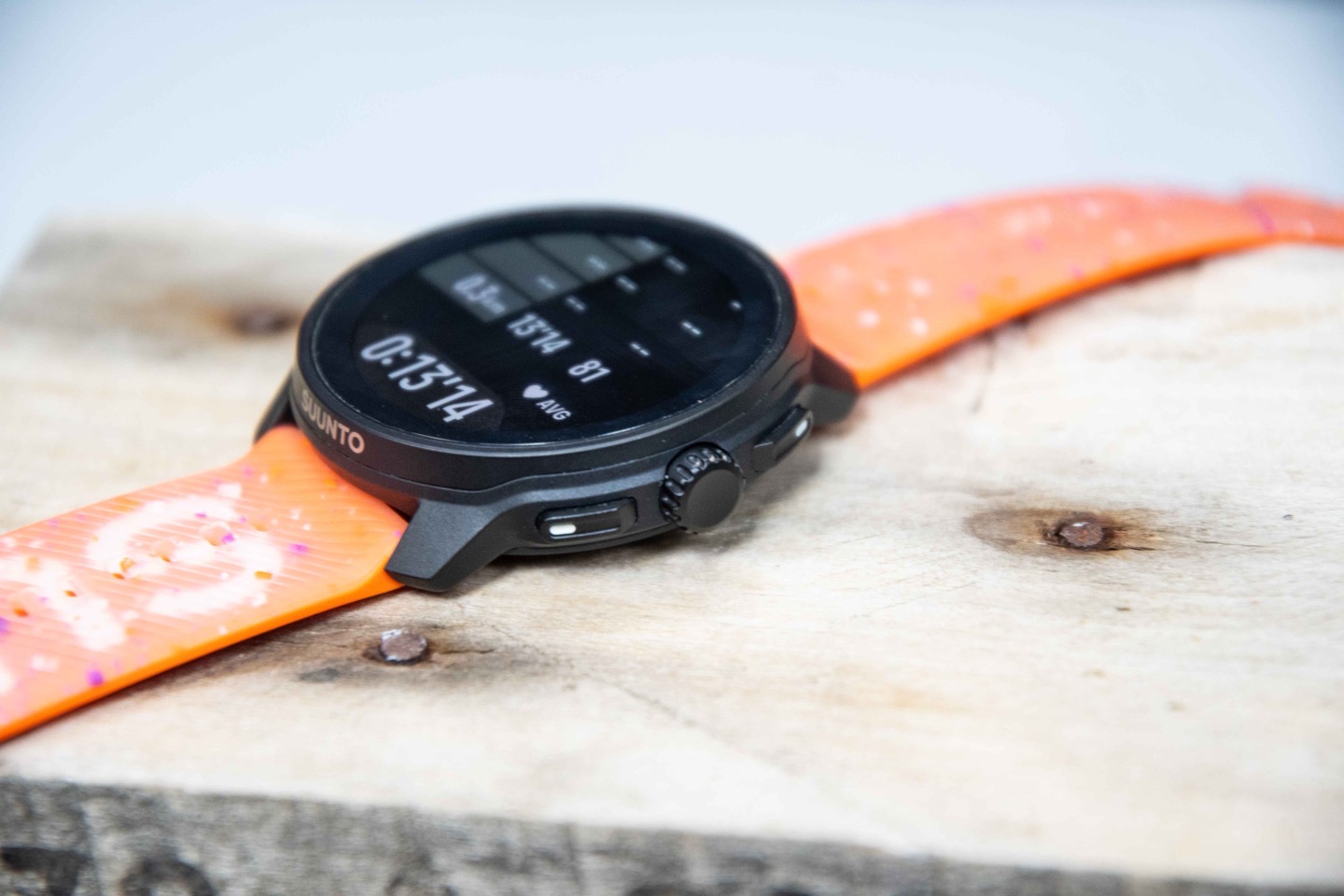
From a usability standpoint, the Digital Crown works fine, though, those that know my reviews over the years know that I don’t really find the Digital Crown great (on any watch, Apple included) for anything except zooming in/out on maps. In general, I find digital crowns finicky to use, especially during sport activities, compared to just pressing buttons. But, that’s mostly a personal preference.
Meanwhile, the 1,000 nit AMOLED screen is brilliant to see, both in bright sunny conditions and darker conditions. I spent most of my time over the last week+ in Greece, on a very sunny island. I never had any issues seeing the screen in any conditions during mid-summer-sun, or at night.
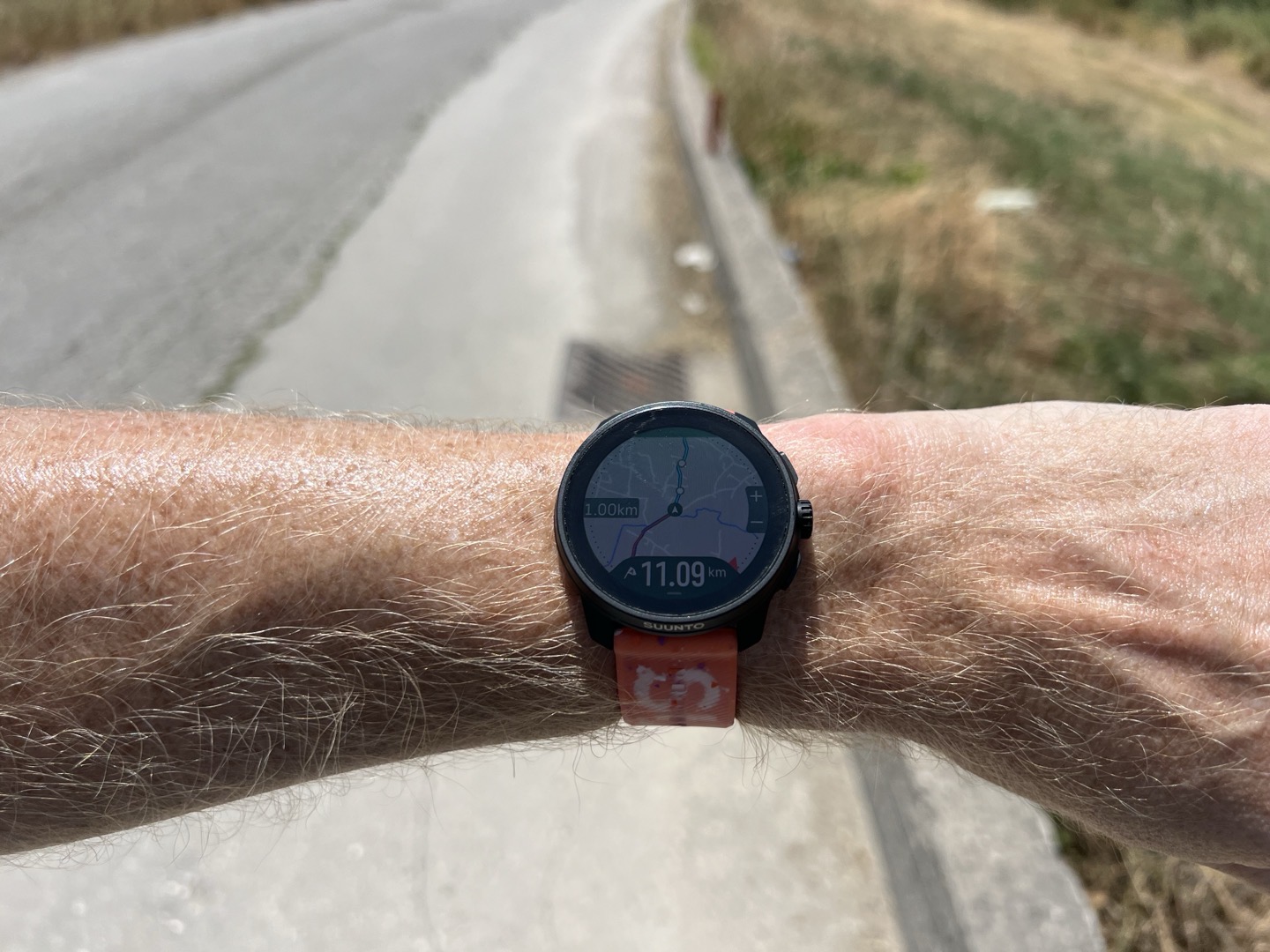
In the case of the Suunto Race S, as with most AMOLED displays, there are essentially two modes: Always-on, or Gesture-based. Always-on means the screen is always-on, but will dim when you put your wrist down. Whereas Gesture-based means that the screen turns off entirely when you put your wrist down. This is obviously done to save battery, with Suunto saying that in gesture-based mode Suunto claims 7 days of battery life, versus always-on claims of about 5 days of battery life. As noted earlier on, I’m not quite getting these numbers, but rather closer to 3-4 days in always-on, and 4-5 days in gesture-based. In this case, I had the “Display Only” option, which should save more battery.
Now, one new bit here with the Suunto Race S is the new watch face customization. Sure, the Suunto Race S got three new watch faces, but what matters here is the ability to quickly and easily customize the watch faces (including complications and coloring) right from the wrist. Simply double-tap the screen and it lets you tweak the various complications:
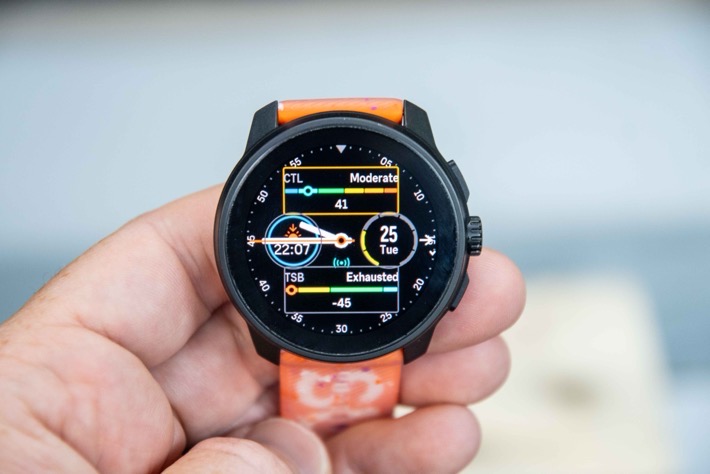
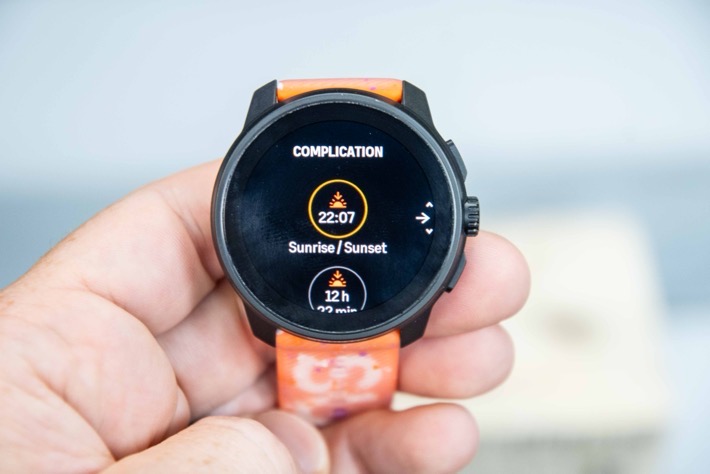
My only complaint here is that nearly every shower I took, resulted in it activating the watch face complication configuration. This wasn’t a huge deal, roughly akin to how my Apple Watch seems to always be swapping watch faces due to rubbing against clothing/etc. It’s slightly annoying, but not a deal breaker.
Now looking at some of the daily stats, each morning when you wake-up, you’ll get a morning report of your sleep details from last night. This is something Suunto has had for a year or two, but is now improved with the Suunto Race and carried through to the Suunto Race S in that the screen will stay there for at least an hour or so, until you dismiss it. Previously, it’d disappear the moment you rubbed your eyes open, meaning you virtually never saw it.
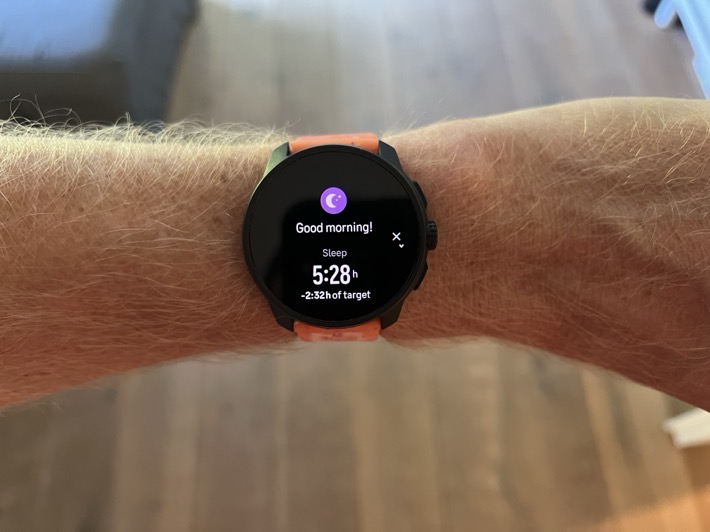
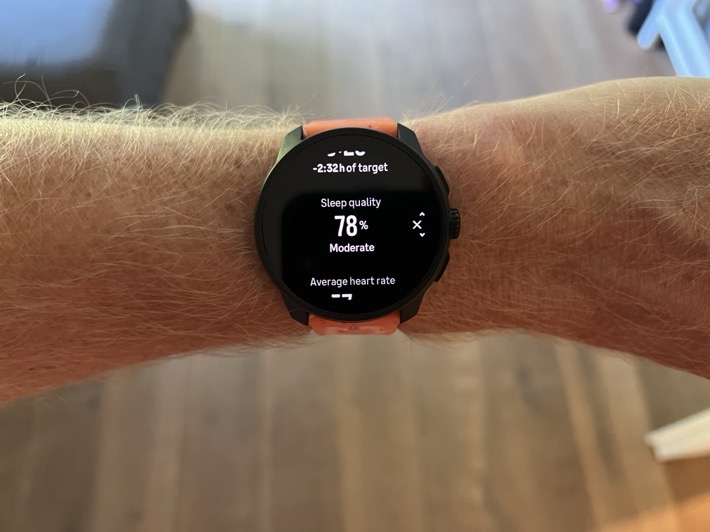
In addition to the morning report, you can dive into your exact sleep stats as well in the sleep details widgets (obviously a different day below, versus above):
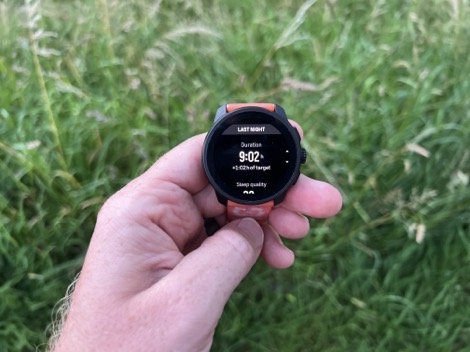
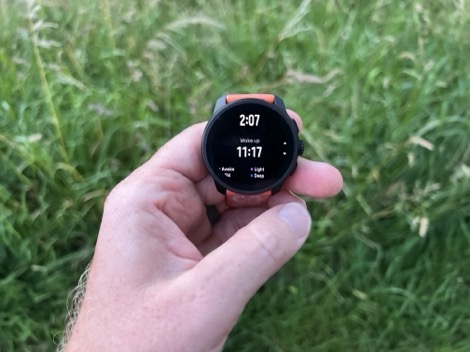

In terms of the accuracy of sleep data, I’ve found the times I went to sleep/woke-up spot-on, as well as handling cases of briefly waking up early morning (e.g. 5-7AM briefly for a few minutes), which is always good to see. As for sleep stages/phase accuracy, it’s not an area I judge, because the comparative tools to try and do that simply aren’t that accurate – only in the 80% range (and we’d never judge heart rate accuracy on something only 80% accurate). Thus, I just take the general position that most of the sleep stage/phase data is iffy at best from all companies. Do note that Suunto will track naps, though, I haven’t taken any naps during this testing period. I’ll probably get right on that later today, after all these reviews go out. I did however find that the SpO2 readings at night (blood oxygen levels), were basically garbage.
Further, the Suunto Race S tracks your Heart Rate Variability, or HRV. Suunto rolled this out last year to the Suunto Race (and other units), and it monitors your HRV values throughout your sleep, and shows you the average. In comparing Suunto’s values to that of Garmin, Polar, Whoop, and Oura, all of them have been within +/- 2ms for the entire time, each time. Thus, the differences tended to come more from how each unit classified awake-time within that. You’ll see HRV status in a variety of places, but most notably in the ‘Recovery HRV’ widget down below in the widgets roll. Here this shows your current HRV ranges (which take 14 nights of initial sleep data to first populate), followed by where you currently stand.
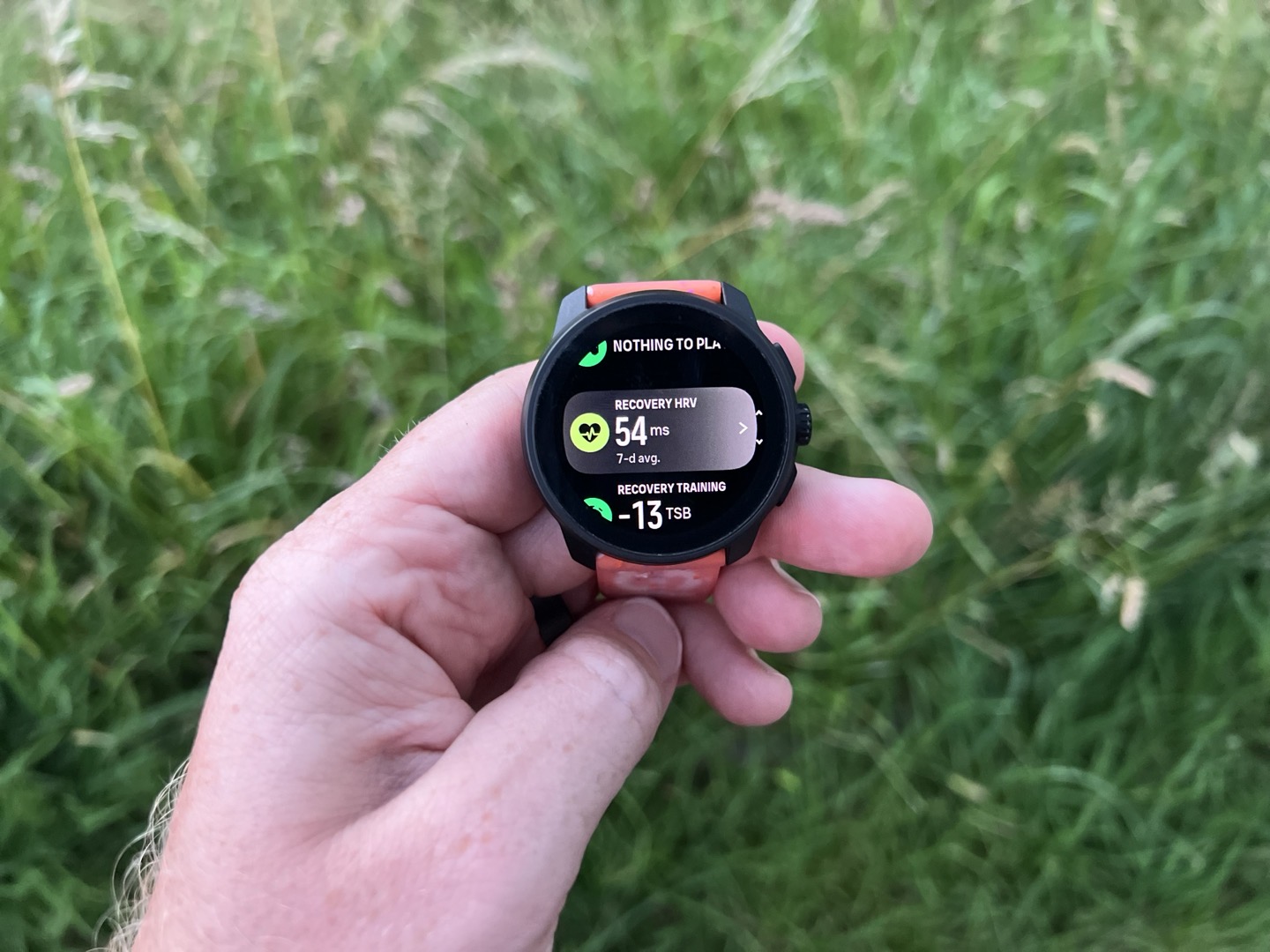
Now, this is just one of the various widgets that you’ll see when you scroll down from the watch face. Other widgets include the stopwatch, notifications, heart rate, resources (basically your energy for the day), sleep, sunrise/sunset, and more. You can see your training-related status here, as well as other stuff, like weather.
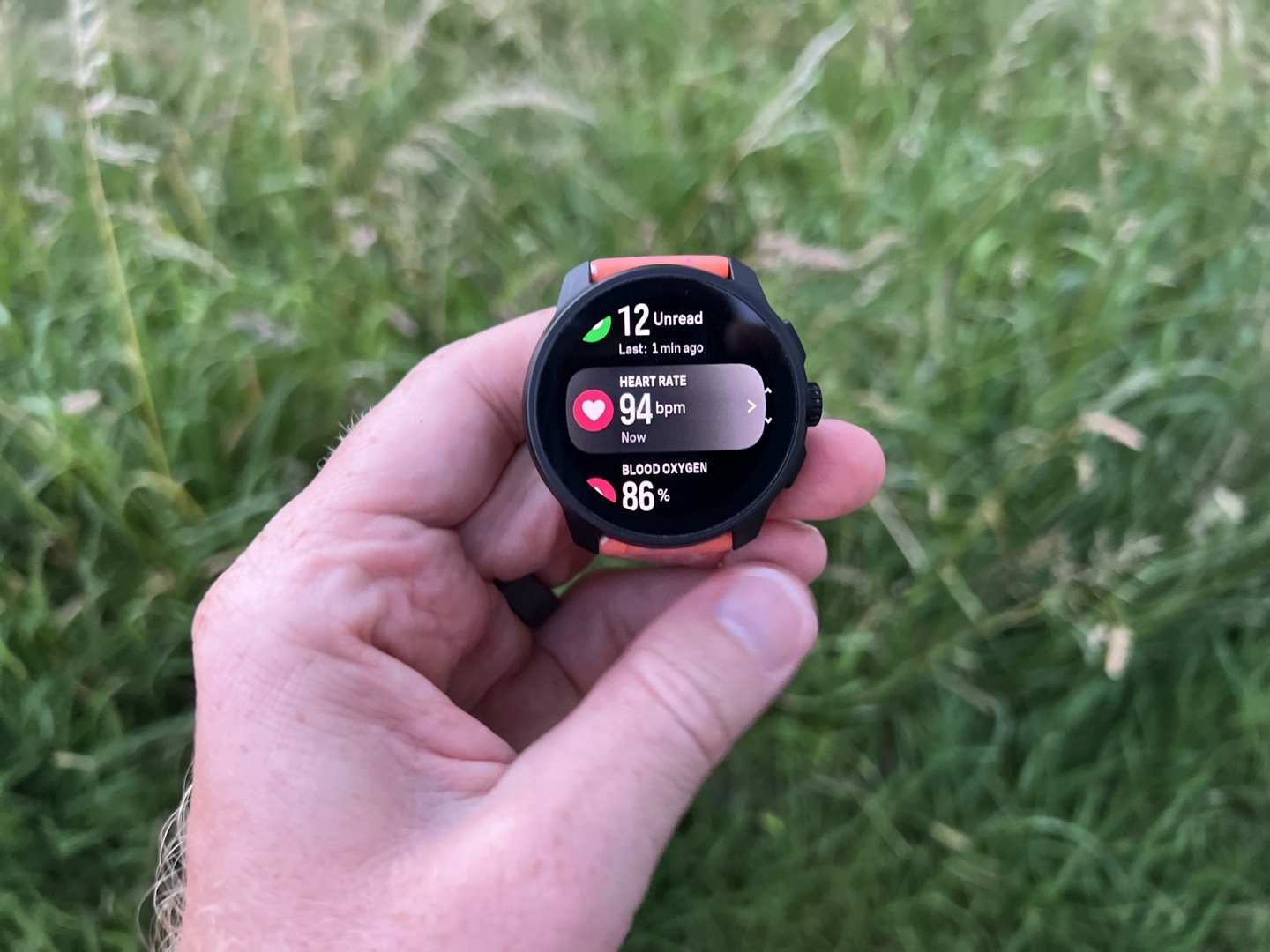
Now, all of these stats are visible in the Suunto App on your phone. You can see it first at the high-level for everything in the last 7 days, and then if you open up that day you see a bit of a ‘feed’ for your day, showing your sleep, activity, workout, etc stats:
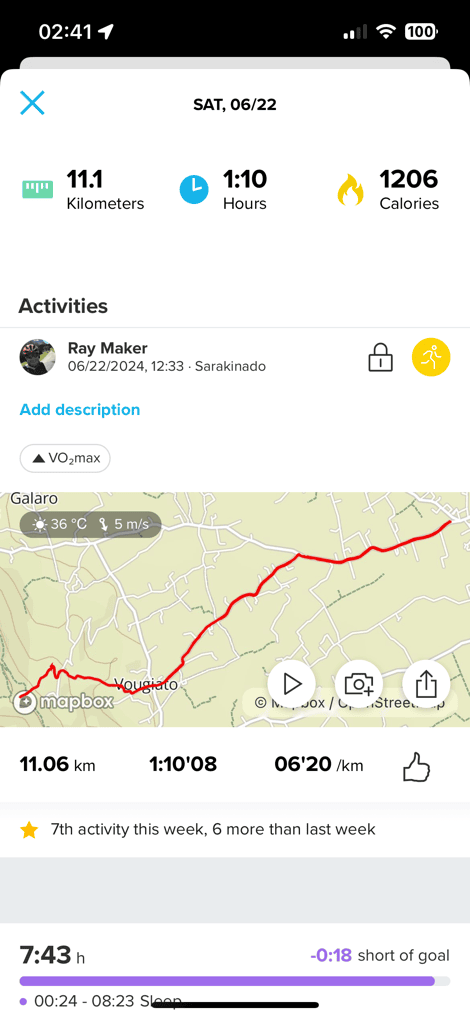
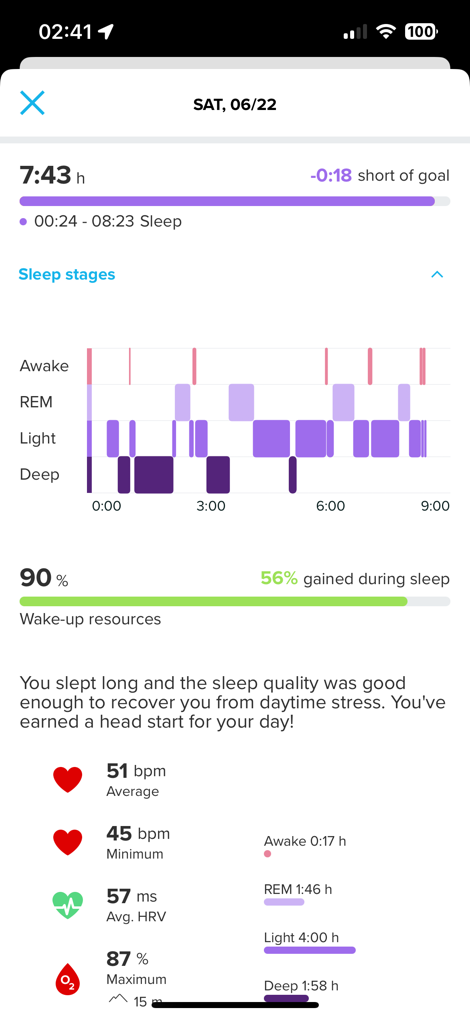
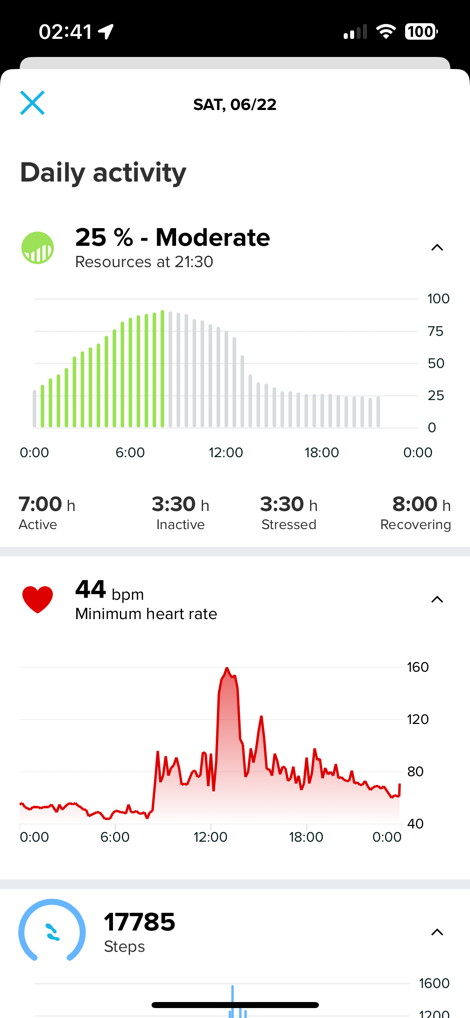
And these stats are also available for training volume/etc too – but more on that later.
Next is smartphone notifications. The Suunto Race S greatly expands the number of emoji here, from ~300 to ~1,000. And even more importantly, they now have color in all of them (versus black and white Commodore 64-style emoji previously):
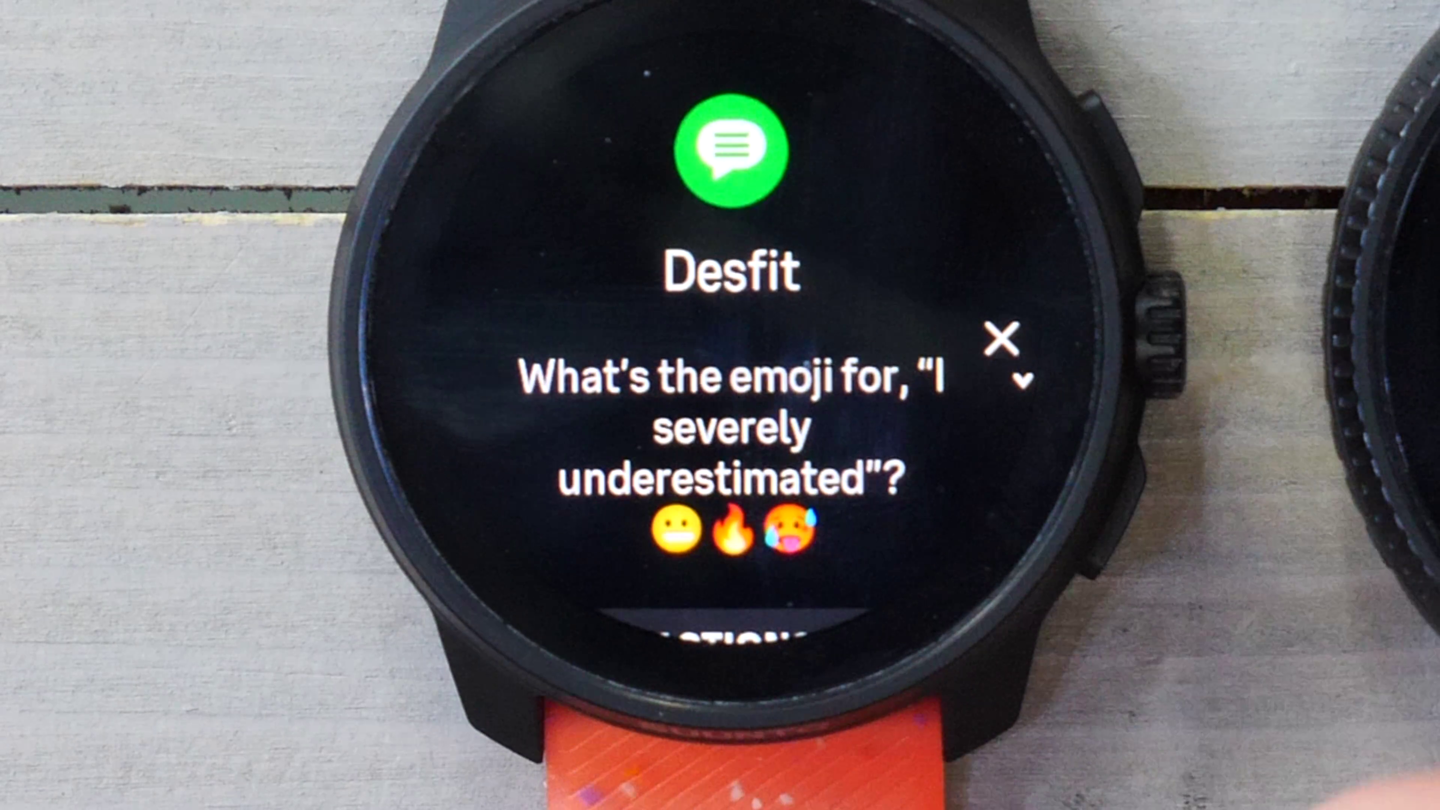
Also of note is that the Suunto Race S carries forward the flashlight via display of the past. This isn’t a dedicated flashlight like on the Garmin watches, but rather, uses the screen instead. You can also create a hotkey for this (to hold down the upper right button for two seconds). I found it perfectly functional for finding my way around hotel rooms at night. It’s not as bright as the Garmin ones, but again, it does the trick.
Lastly, it should be noted the bands are swappable. It comes with a 22mm standard band attachment, so you can easily swap it out for other Suunto bands, or any number of a gazillion other 22mm watch bands on Amazon. Your choice. Also, Suunto has a variety of bands they’re selling the unit with. The one seen in this review is the lower right orange/purple one.

The stock bands are pretty comfortable, so all is well there. And of course, given they’re designed for sport-usage, let’s shift into the next category.
Sports Usage:
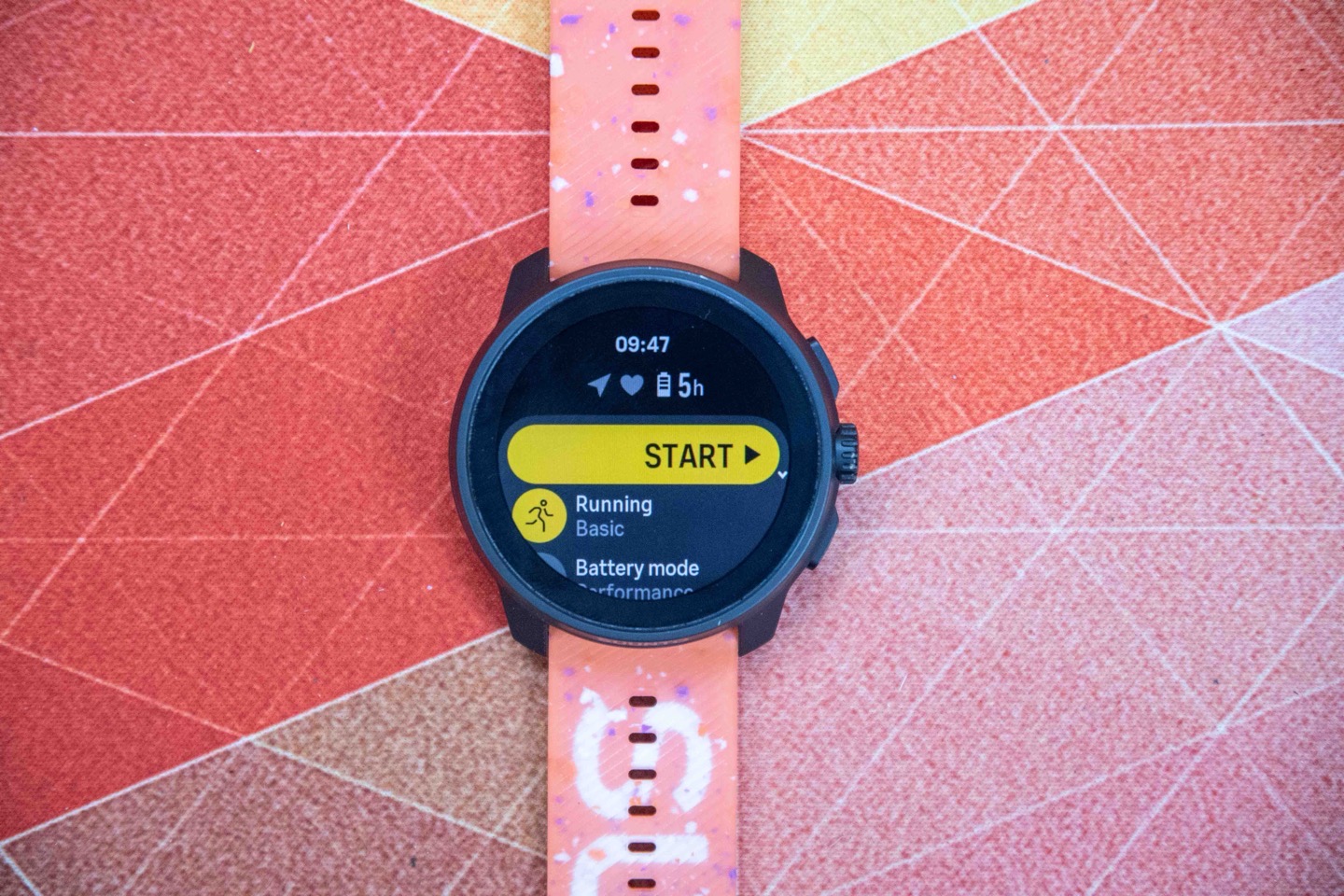
Of course, the entire purpose of buying a Suunto watch is for doing workouts or sporting activities. Or at least, I hope that’s why you’d buy this watch.
The Suunto Race S has all the same sports as the existing Suunto Race, which is to say, everything. All of these, in turn, have varying levels of sport-specific data and customization of things like data fields. In general, Suunto sport modes tend to be more about calorie burn and categorization of your activities, rather than having unique data metrics for each and every sport type. Obviously, the big-name sport types like running/swimming/cycling have unique per-sport metrics, but when you get to some of the less-popular ones, it’s more about general data fields. Suunto has been expanding this a bit though with some of their Suunto Apps, which are little apps that can run on the watch, and are sometimes a bit more specific in terms of data they track.
To begin, you’ll tap the upper right button to open up the most recently used sport mode, from there you can select the sport mode and change it to something else. Once you tap a sport mode, you’ll be brought to this page here, which shows GPS status, sensor connectivity status, battery life estimates, and more.
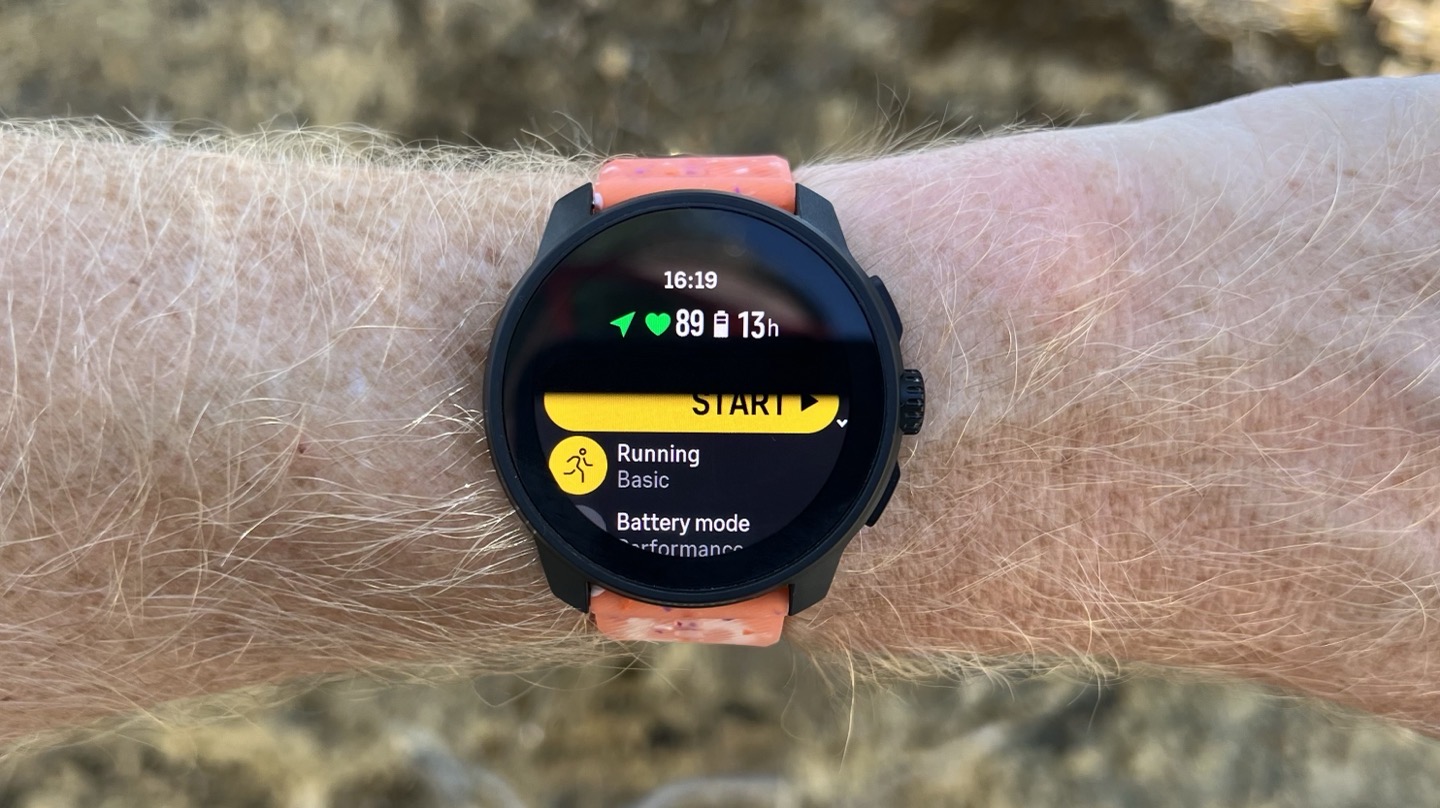
From here you can change your battery mode (which can offer longer battery life, but usually at the reduction of some other feature or data update rate), as well as add things like a route. You’ll also see the ability to choose the map style (light or dark), and most notably, SuuntoPlus Apps. SuuntoPlus apps are both Suunto-developed and 3rd party apps that you can load onto the watch. This comes in two basic flavors: Apps and Guides. Apps are all-encompassing, while Guides tend to be for things like structured workouts.
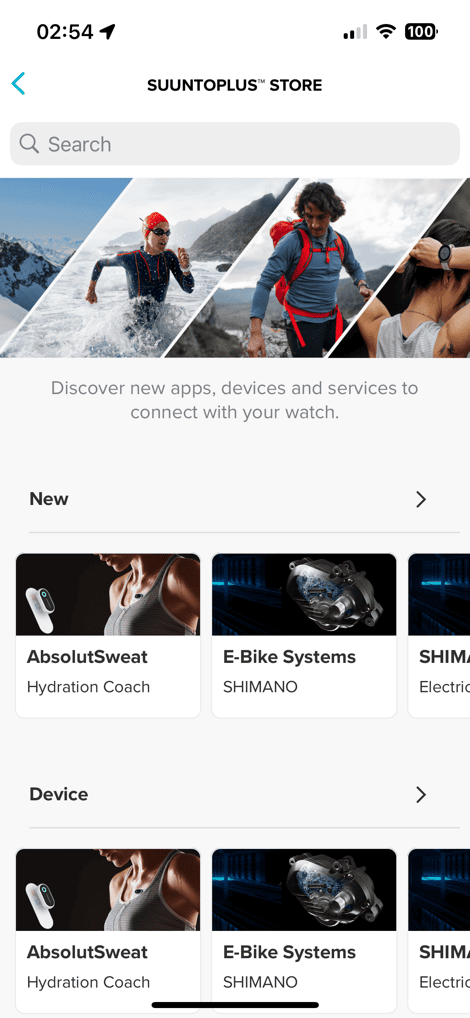

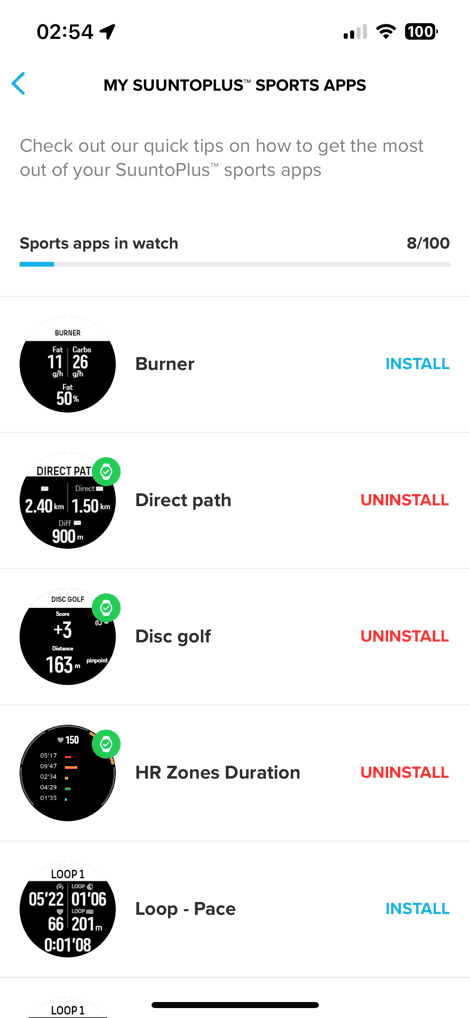
With the Suunto Race S, Suunto pre-loads certain Suunto Apps tied to certain sport profiles. For example, a tennis-focused app developed by Suunto when you launch the Tennis sport profile. With today’s announcement of the Suunto Race S, there’s even more new Suunto Apps being announced, which of course go to more than just the Suunto Race S, but all the other recent watches as well.
That said, as I’ve complained for years, Suunto is also using them as a bit of a crutch. Many of these SuuntoPlus Apps that are developed by Suunto should really be built-in features of the watch. And the reason that matters, is that you can only add in 2 apps per sport profile at a time, or 1 app and 1 guide (they do at least remember them each time now). Thus while Suunto as a company has many of the sport features Garmin does, you can’t actually use many of them concurrently together, because of the limits Suunto has in place – thus making it much less useful.
Suunto really needs to pick at least a few of these per quarter, and ‘upgrade’ them to built-in features. Undoubtedly they have the data on which ones are most popular (especially over longer periods of time), so this shouldn’t be a big ask.
That said, Suunto did build-in a structured workout builder into their app, making it easy to get structured workouts on there. These still take up the slot of a ‘Suunto Guide’, but you can run them concurrently with an app, so it’s less of an annoyance there. You can create multiple steps and then send it to the watch (even to a specific date). Further, they also support TrainingPeaks structured workouts, as well as workouts from numerous other connected platforms.
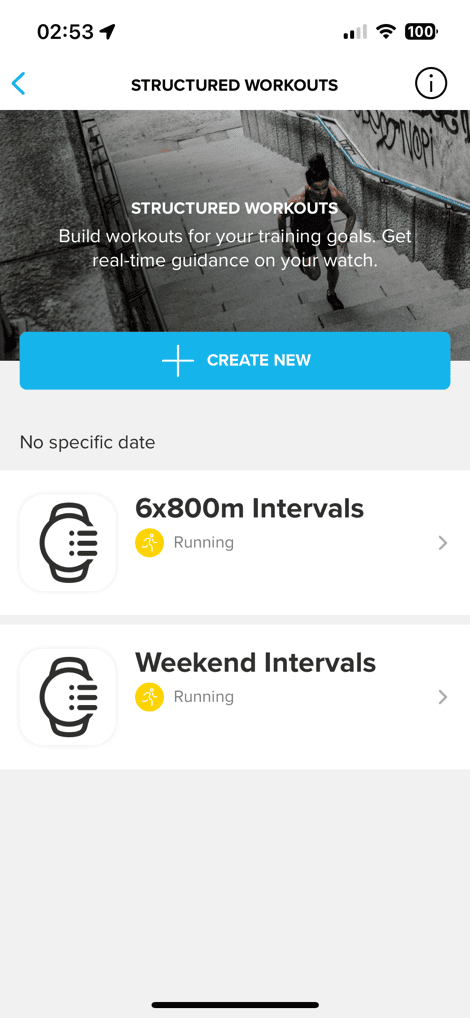
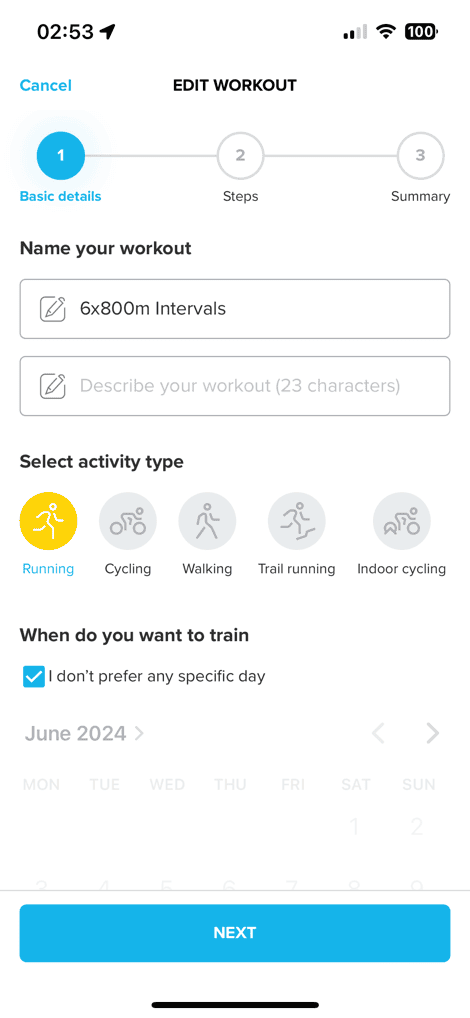
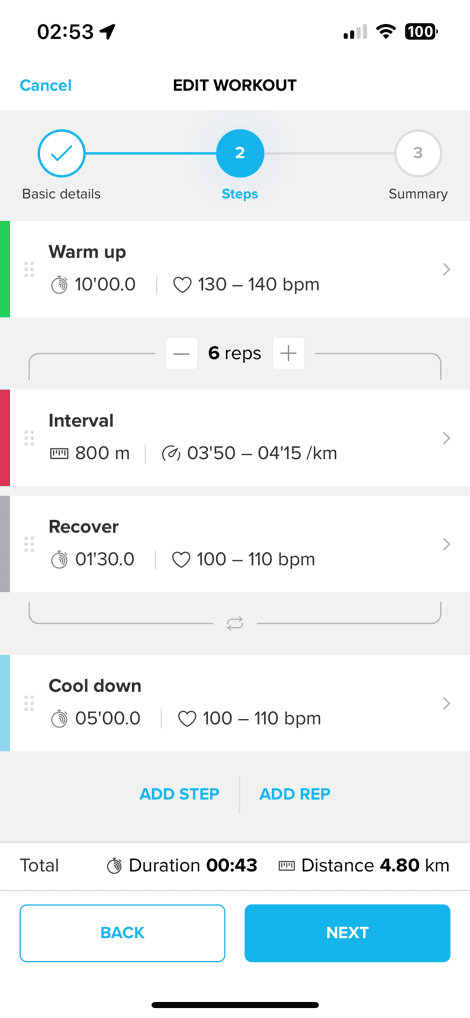
In my case, I created a series of 800m repeats, and then executed it on the Suunto Race S. This was easy to create via the app, and even easier to follow on the watch. I simply ran when it told me to run, and dropped dead when it said I was done running.
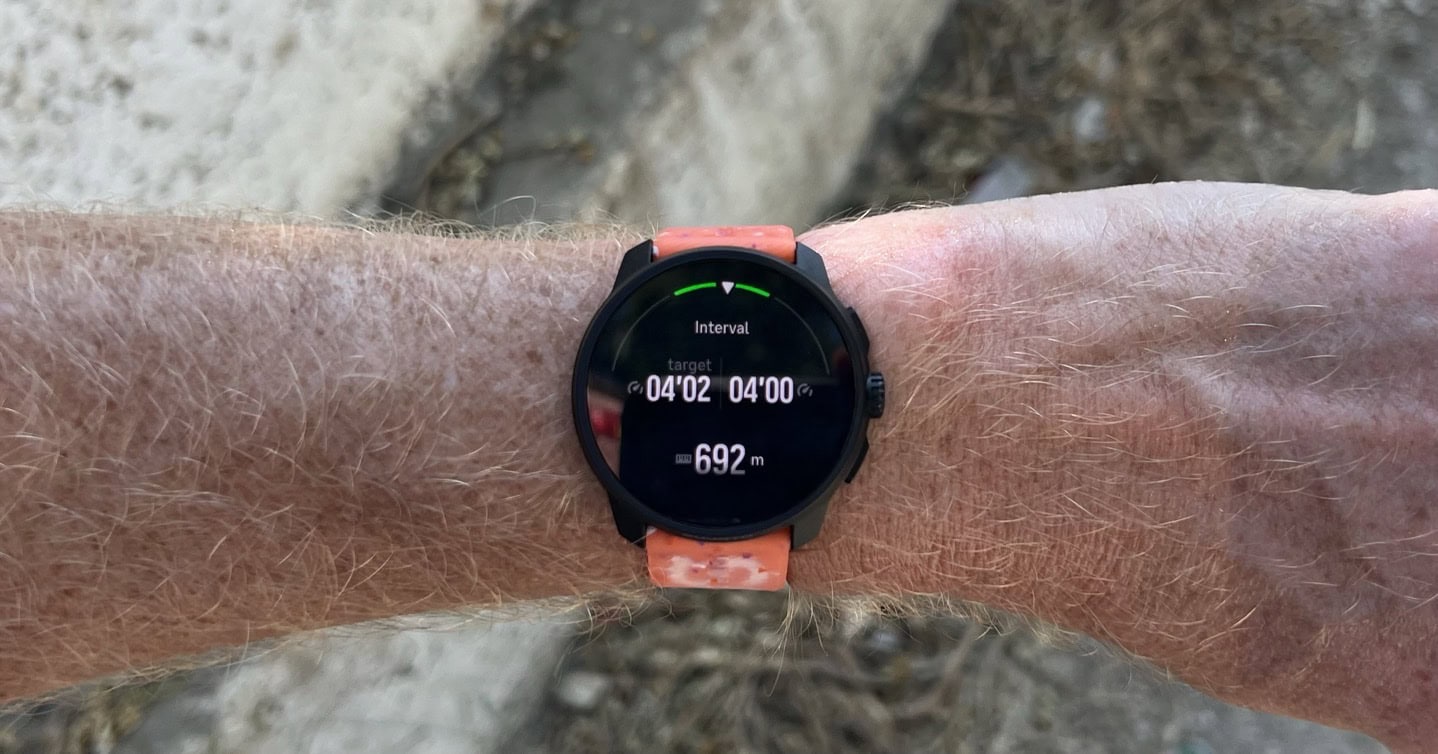
As for changing your data pages/fields, you’ll do that via the Suunto App on your smartphone. You can customize these per sport profile, with variants for whether or not you’ve got a cycling power meter connected, or other sensors (and running power is built-in, so that happens automatically with no external sensors). That said, what’s rather annoying here is that you can’t edit existing (default) sport profiles. You have to start over and re-create, even if you want to change a single data field…which, is (and long has been) bizarre – resulting in duplicate sport modes. I’m not sure why this is still the case.
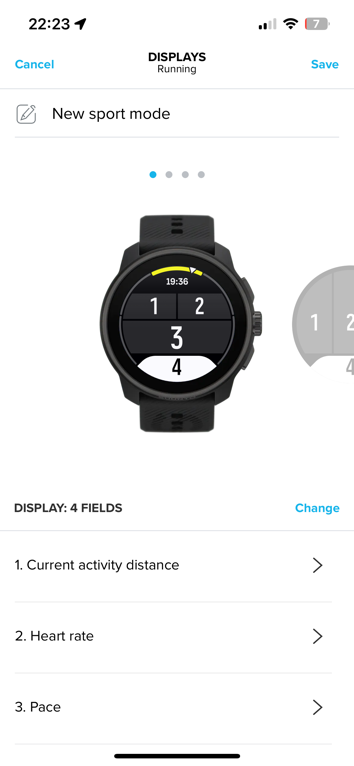

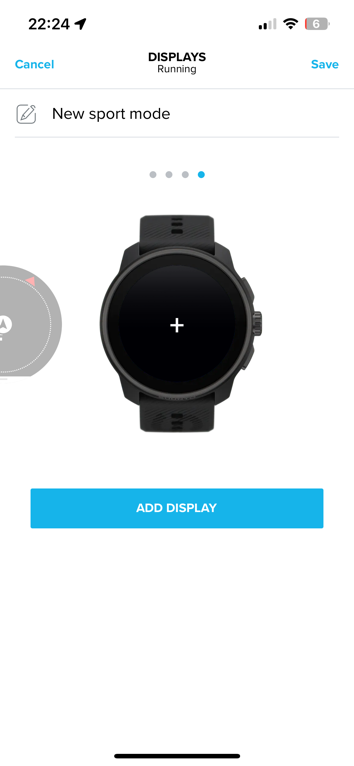
Finally, before we start actually running, we’ve gotta talk about sensors/accessories. The Suunto Race S can connect to Bluetooth Smart sensors including heart rate sensors, cycling power meters, cycling cadence/speed sensors, and running footpads. However, it will only connect to a single sensor of each type, it cannot save more than one sensor type. Further, it doesn’t even show you the name of the sensor it connected to (it will at least show you the power meter crank length option though, if applicable).
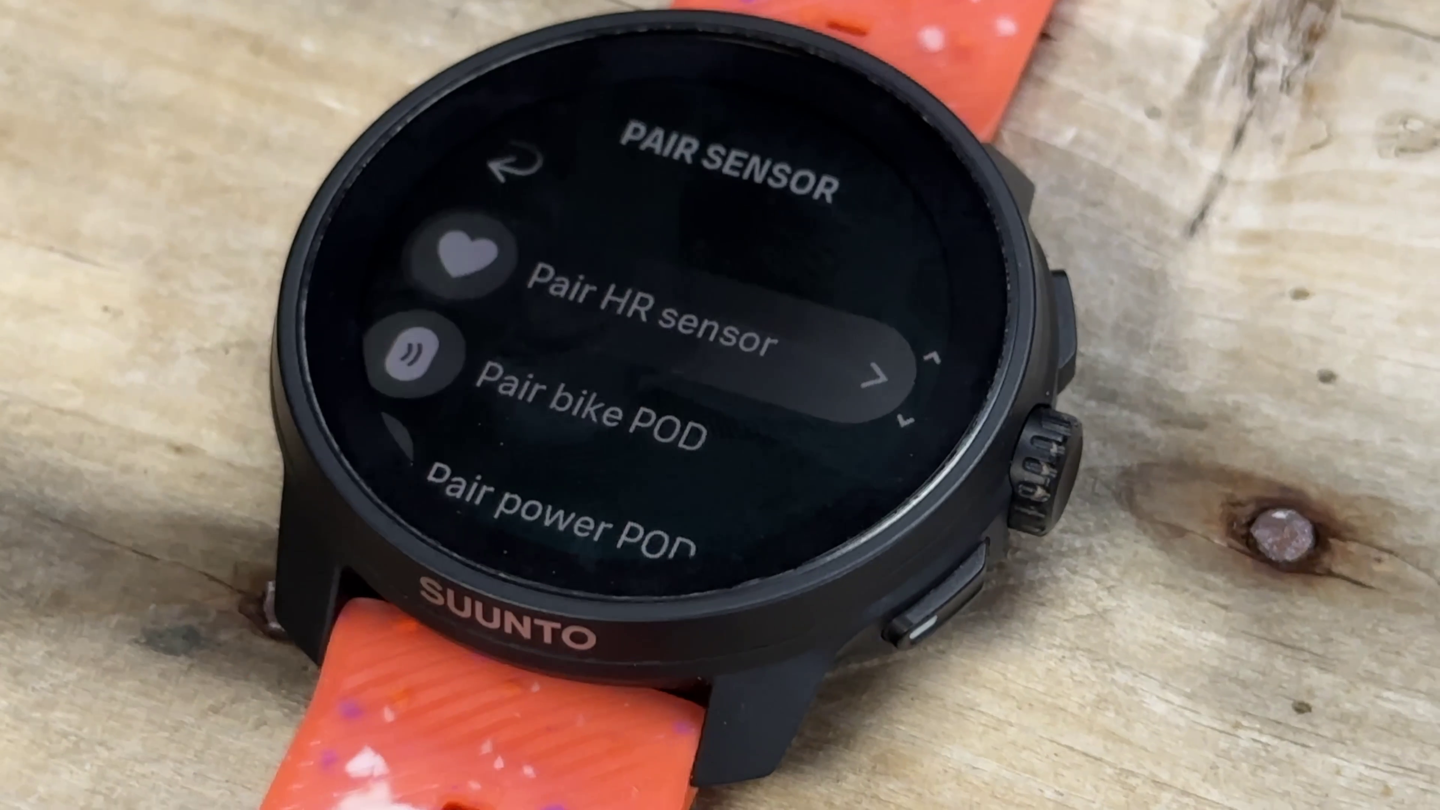
Look, I’ve said it before in my Suunto Race review, and I’ll say it again in this Suunto Race S review– this just isn’t good enough in 2024. It wasn’t good enough in 2018 either. Or even 2012. Every other watch supports saving multiple sensors of the same type, which is particularly important for cyclists. Especially those cyclists with home trainers or indoor bikes that want to connect to those, else, you’re constantly having to re-pair sensors (without ever knowing if you’ve paired to your bike, or perhaps your buddy’s bike). Suunto really needs to have this be a focus area for the winter, ahead of next season. I’m not sure why this can keeps getting kicked down the road.
Likewise, Suunto also doesn’t have any broadcast heart rate feature, to transmit the optical HR sensor to apps like Zwift, Peloton, etc… Again, in 2024, with many people using that function for indoor training, it seems like an obvious gap. Especially now that Suunto has fixed the accuracy issues with the new optical HR sensor found in the Suunto Race S.
Ok, with everything all set, let’s get this workout underway. After tapping start, you’ll see your data pages as configured:
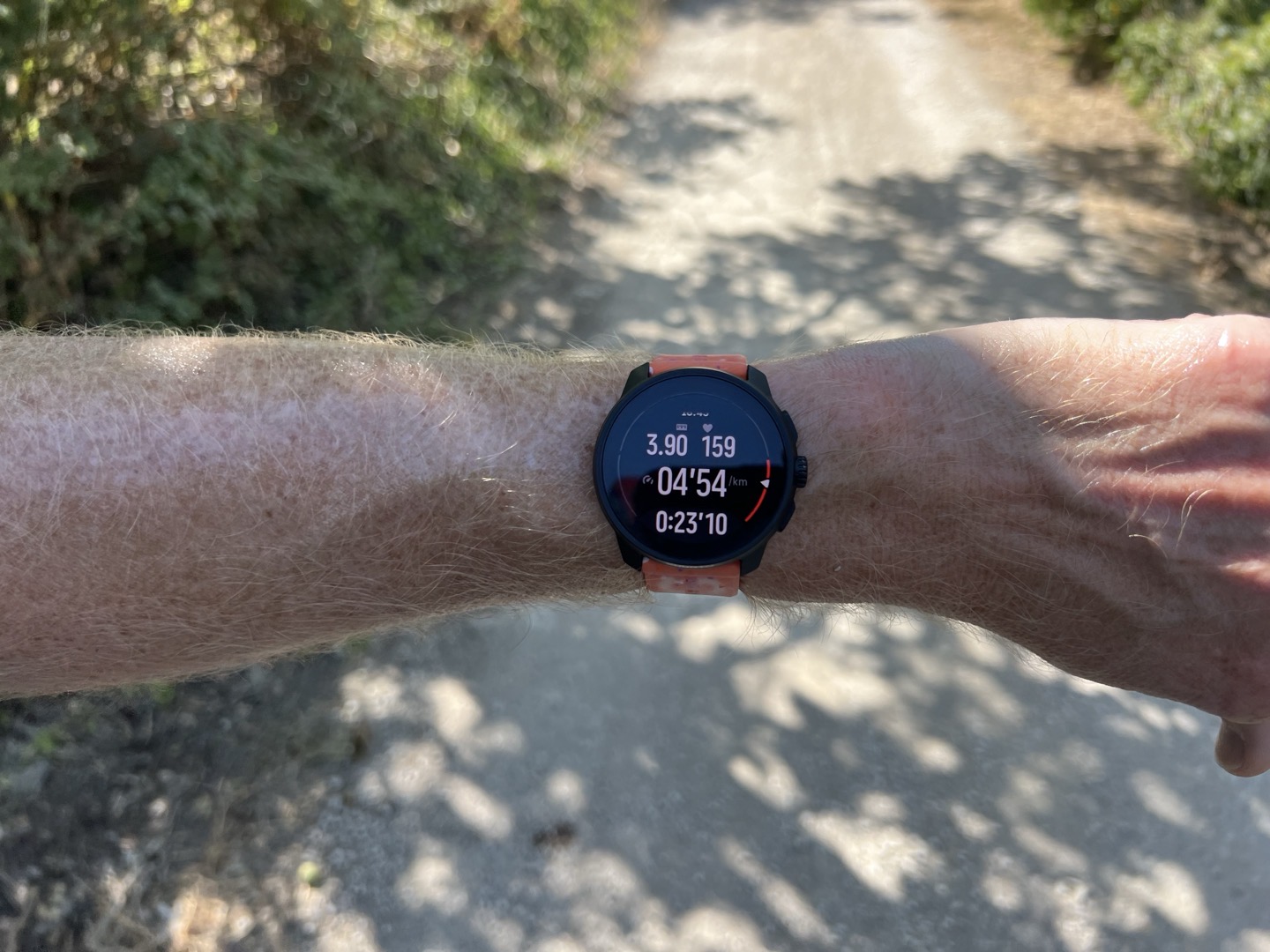
I had no issues with data pages, crashes, or anything of the sort during any of my runs/rides/swims/etc… Everything worked exactly as I expected. Likewise, I had no issues viewing the data pages of the AMOLED display during bright sunny workouts, or evening sunset workouts. Again, AMOLED displays of 2024 are very solid compared to AMOLED or LCD screens of just a few years ago. Visibility is simply not an issue anymore.
Oh, and that new ‘pause’ screen? Here ya go. It allows you to iterate through your data fields/pages like normal, even when paused:
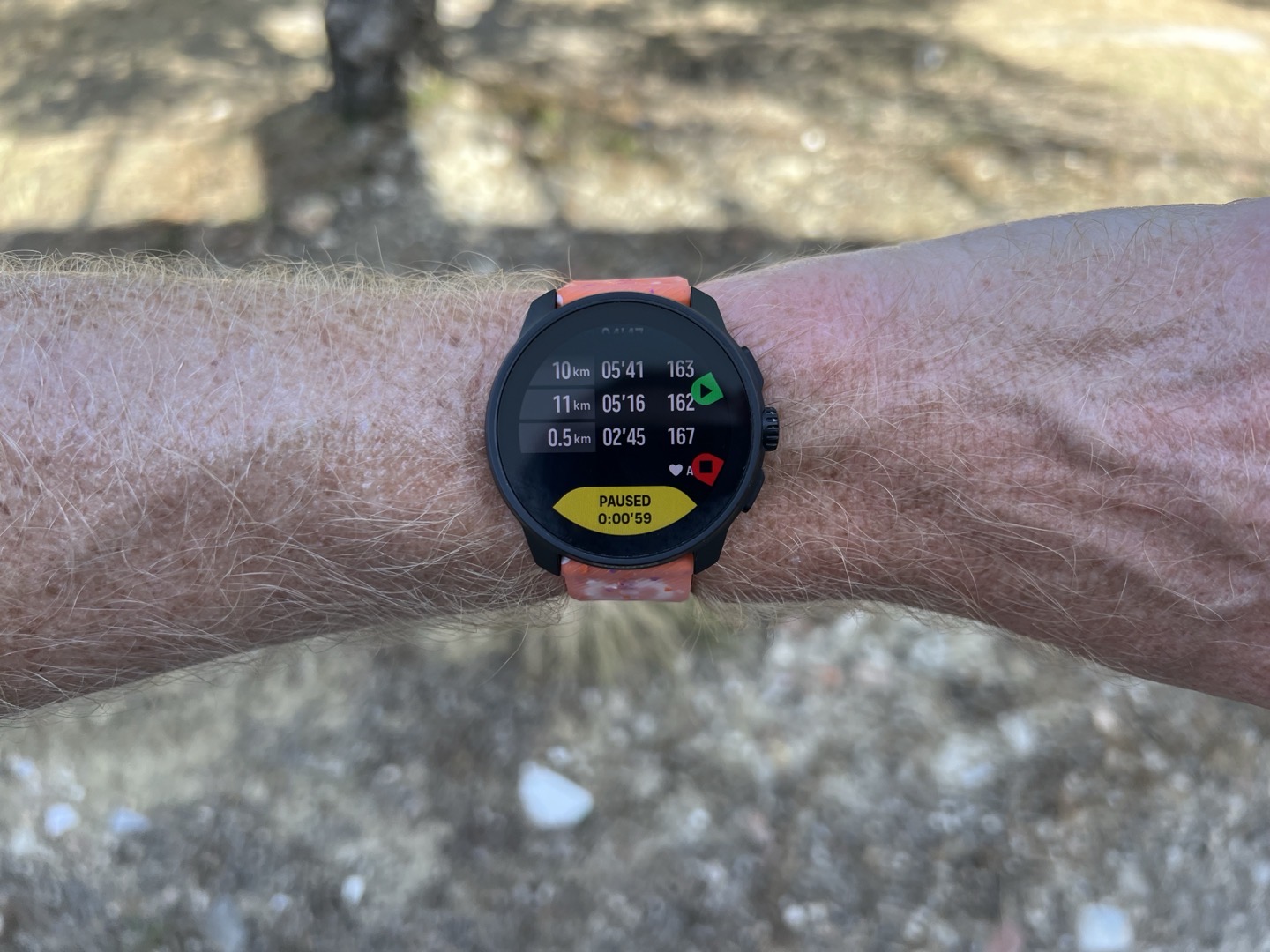
Once done, you’ll save the workout and see a complete summary of your workout data.
And, of course, all of this data is visible on the Suunto App as well. If you have connected platforms like Strava or TrainingPeaks, those will show up a few seconds later once synced to the Suunto App.
In that same vein, you’ll see training load and recovery stats within the watch, as well as app platform. On the watch itself, you’ll see the TrainingPeaks metrics of TSB (Training Stress Balance), TSS (Training Stress Score), and CTL (Chronic Training Load), down in the widgets.
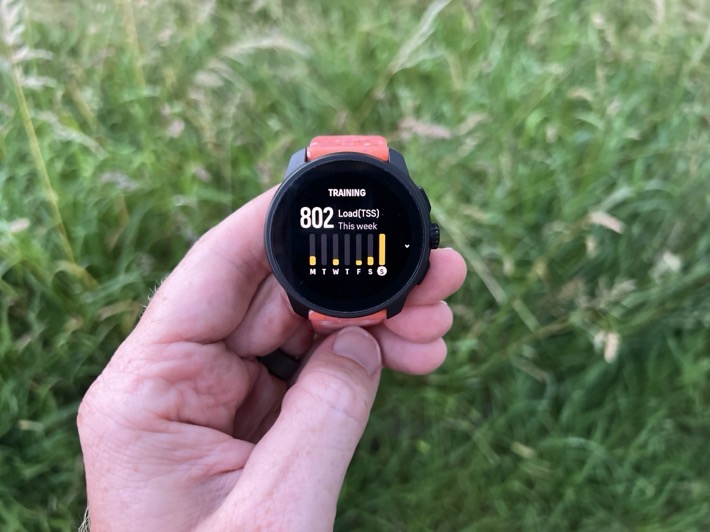
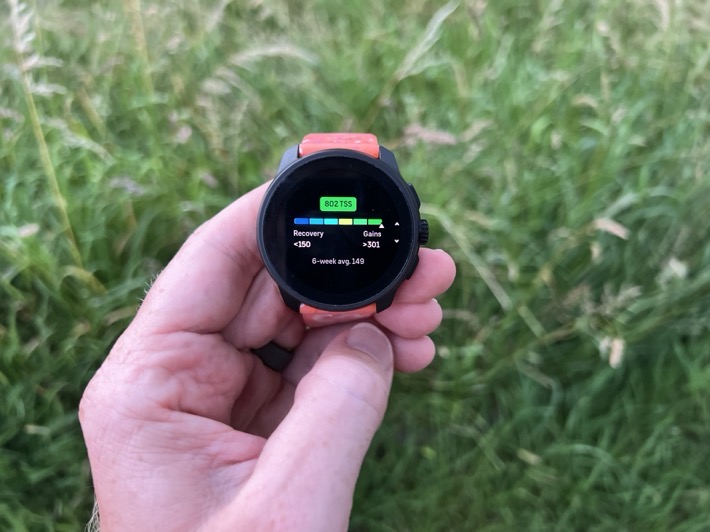
But these are also shown on the Suunto App, on the main homepage, and you can dig into them in more depth if you want to here too.
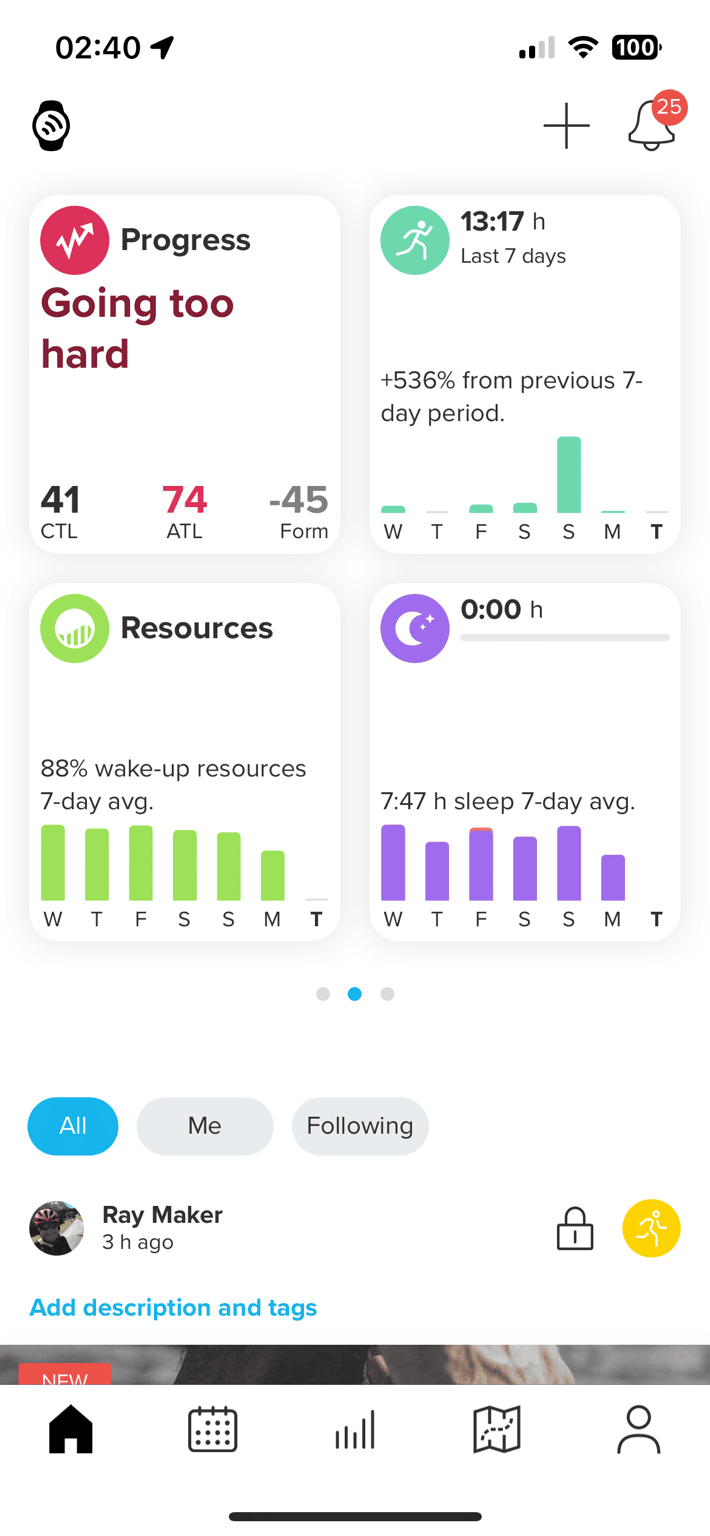
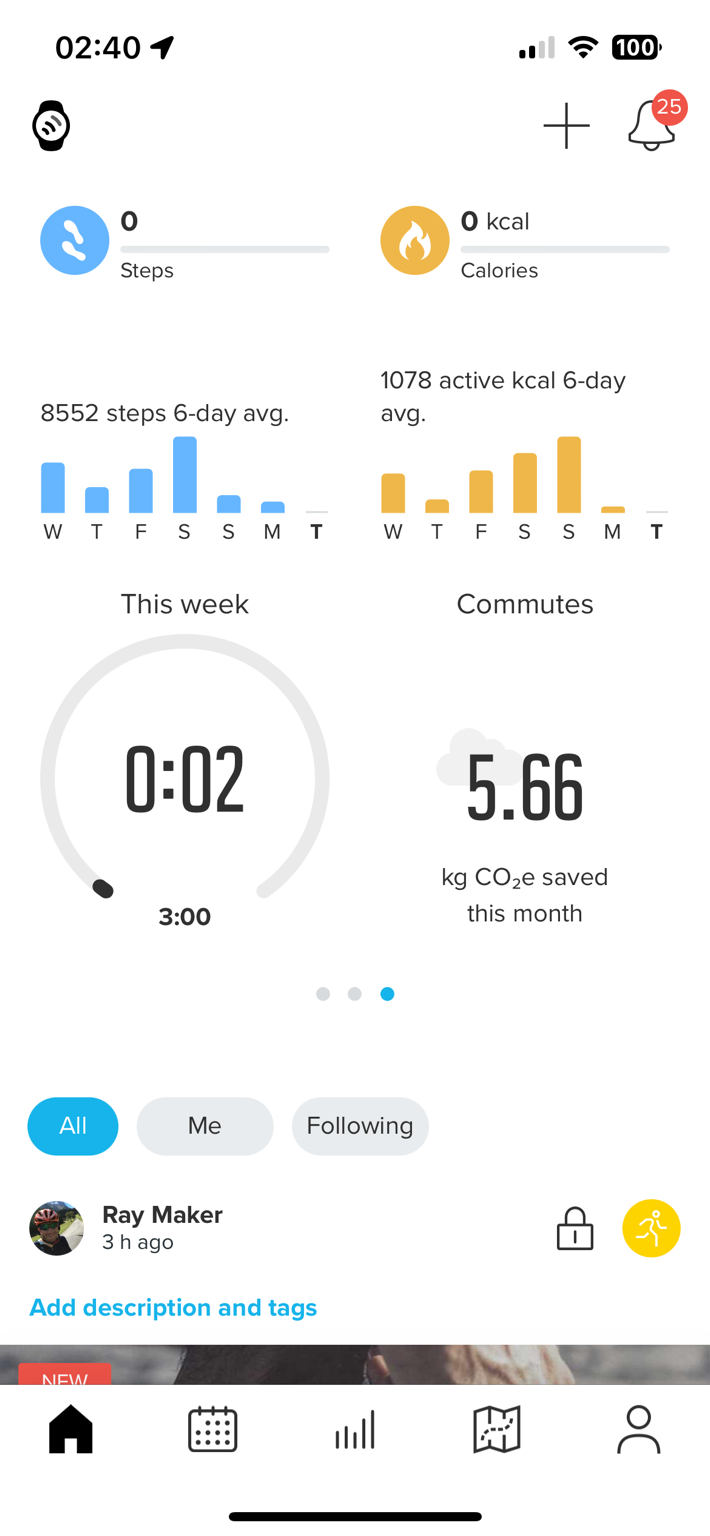
Suunto has licensed these from TrainingPeaks, so that in theory they should match your TrainingPeaks account, assuming the data you have matches what’s in your TP account.
Mapping & Navigation:
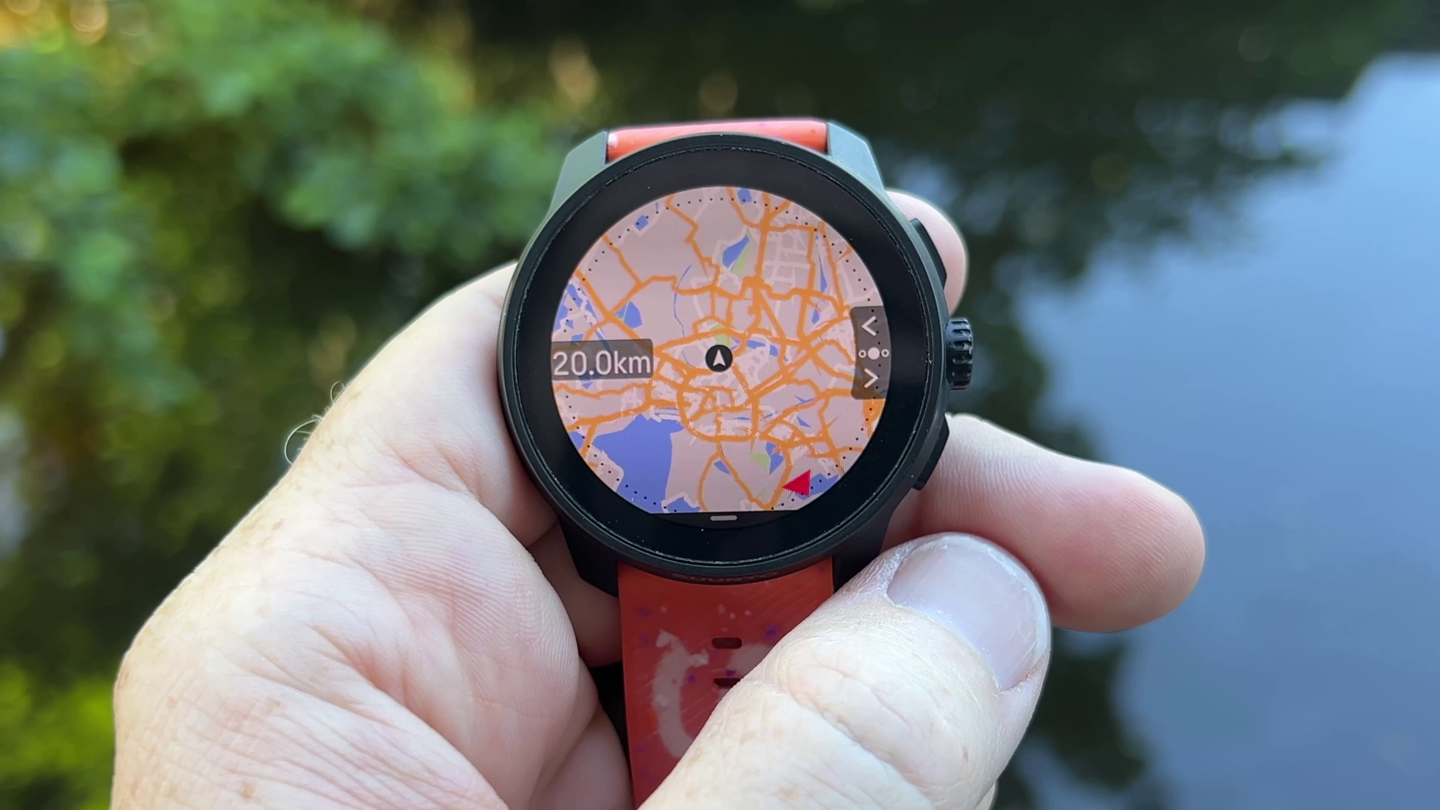
The Suunto Race S contains the same maps and navigation features of the Suunto Race, except now adding in Suunto’s new ‘Climb Guidance’ feature, as well as increased map zoom levels, and minor tweaks to turn-by-turn prompts so that they don’t overtake the screen.
The Suunto Race S has 32GB of storage, which is notable because the base edition of the Suunto Race (stainless steel) only had 16GB. Practically speaking, both is plenty for the maps that Suunto uses, as they are much smaller than Garmin maps since they lack street names/POI/etc… To get maps onto the watch, you’ll need WiFi connectivity, and the Suunto App on your phone, allowing you to select and save WiFi networks.
Next, you’ll choose which maps/regions you want. Suunto’s region picker allows you to get fairly granular on the exact area you want. This is great in that you can download smaller map regions if you’ve got limited connectivity right before an adventure (whereas Polar and Garmin have massive multi-GB map sizes). It also means you’d have to try really darn hard to fill up the 32GB of storage (or about 28GB of usable space). On the downside, if you’re traveling in a foreign country, you might not know the correct/exact region name for the area(s) you’re in, since those don’t usually align to provinces or cities. It will show you your nearby maps though, which helps get the right ones, once you’ve arrived:
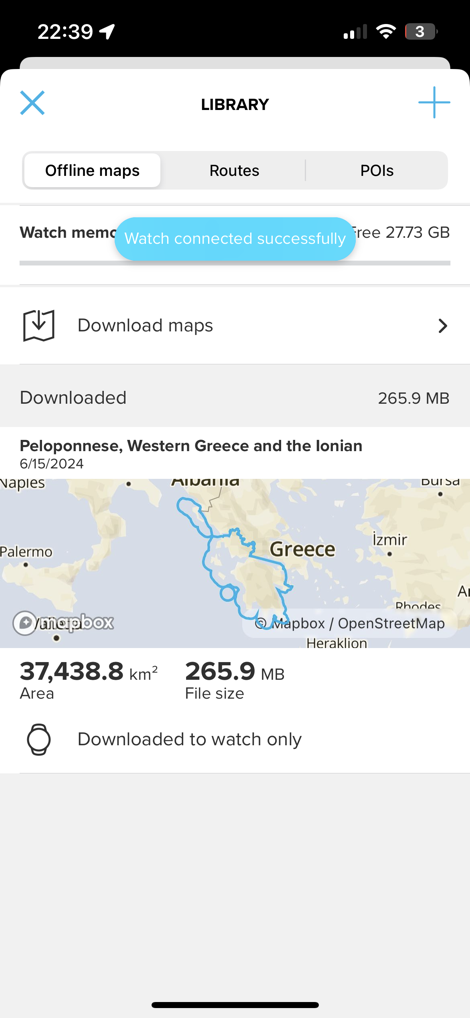
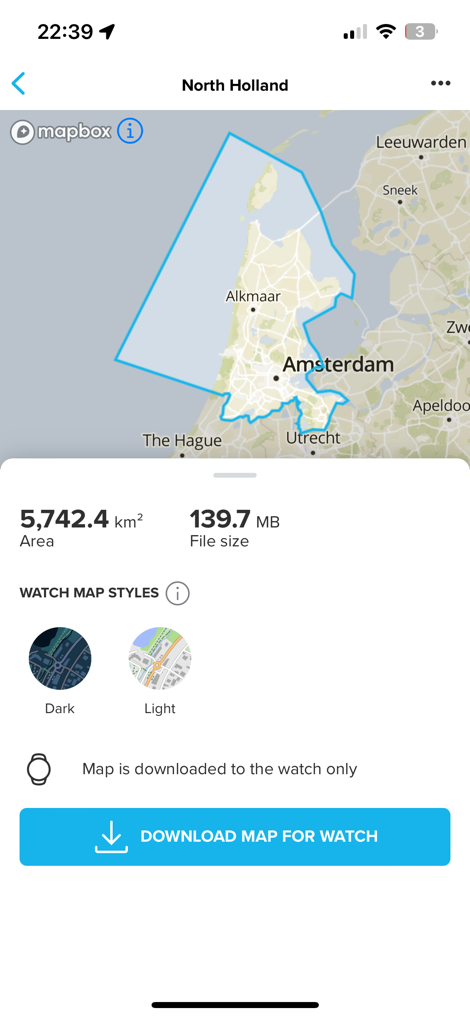
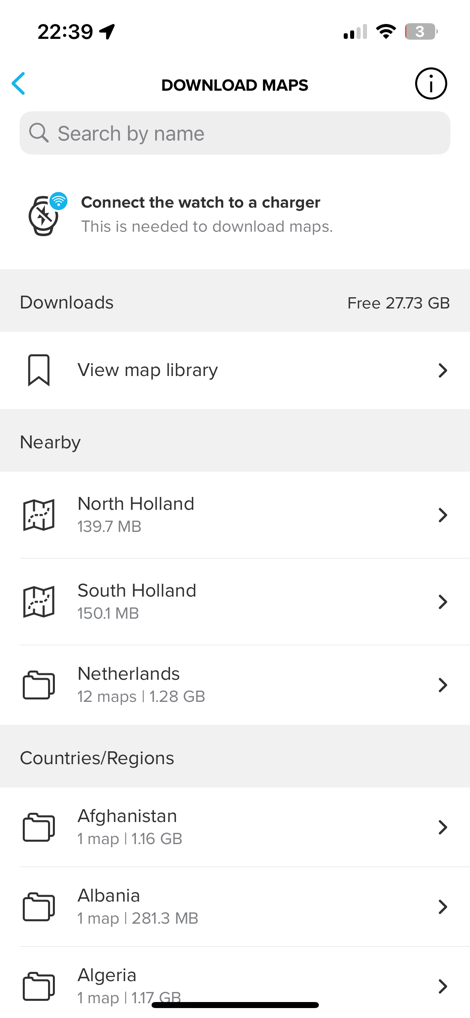
Downloading maps uses the aforementioned WiFi, once placed on the charger. You’ll see it connect to WiFi and download any maps in the queue. This is kinda nice in that if you know you’re going on a trip, you can choose a bunch of regions, then put your watch on the charger to top-up. Suunto’s map download process doesn’t tend to be fast though, so give yourself some time.
Once maps are loaded, they’ll be on your device till you delete them. First though, let me quickly give an overview of the ’state of maps’ in relation to various devices in the market today:
Breadcrumb trail only: This is when you don’t have a background map, but just follow a little trail on a blank screen. This is essentially Suunto’s older devices, and Polar’s older devices. No maps, just a line.
Non-routable Maps: This is when you have a map displayed behind your route, which shows terrain/trails/lakes/water/mountains/etc… Depending on the company, it may or may not show name terrain labels too. However, this isn’t routable, so it doesn’t actually *know* if you’re on the ‘Deer Lake Trail’ – it just knows you’re on the breadcrumb track. If you stray too far from the trail, it’ll give you an off-course warning, but it cannot smartly re-route you back. It just tells you via compass how to find the trail again. This is what the Suunto Race/Vertical are, and all COROS watches, and the Polar Vantage V3/Grit X2 Pro.
Routable Maps: This is the ‘highest’ level, and is when the watch can actually route on the trails by itself, if needed. It knows you’re on Deer Lake Trail, and the next trail coming up is Big Bear Trail. And it knows if you miss that turn, whether or not you need to turn-around, or can catch-up later on. This is what most of the higher-end Garmin devices are (any devices with mapping, like the Fenix/Epix series, or higher-end Forerunners).
Now, practically speaking – I’ve routed with all three types for years, and generally speaking, you’ll get to your destination just fine. However, having maps (either routable or non-routable) is a massive boost in confidence, mostly when you need to make a decision at a fork in the trail. With breadcrumb routing and slight trail junctions, it’s often just a bit of a guess or trial/error. But with maps, you can usually see terrain features (like a stream or hill) that make it easy to confirm.
With the Suunto Race S, it has the non-routable maps, albeit lacks place/location labels. Still, this is more than enough in most cases. The only scenario that you really want routable is when you go off-course permanently. In that case, you want a new route, and the Suunto Race S can’t do that for you. You’ll be on your own there, whereas a Garmin with routable maps can give you a new/updated route. But that happens super rarely to me.
With all that background, let’s look at some routing. I did a run the other day, for which I created a route on Strava first, and then it synced to the Suunto App. From there, it synced to the Suunto Race S. However, notably, on the Suunto App, you’ll see the new climb information shown along the bottom. At right is another route I created to show more variation in the climbs, and how the climb metrics are displayed (you’ll see the one at right has 4 steeper climbs, versus my Greek Mountains route has one steeper climb.
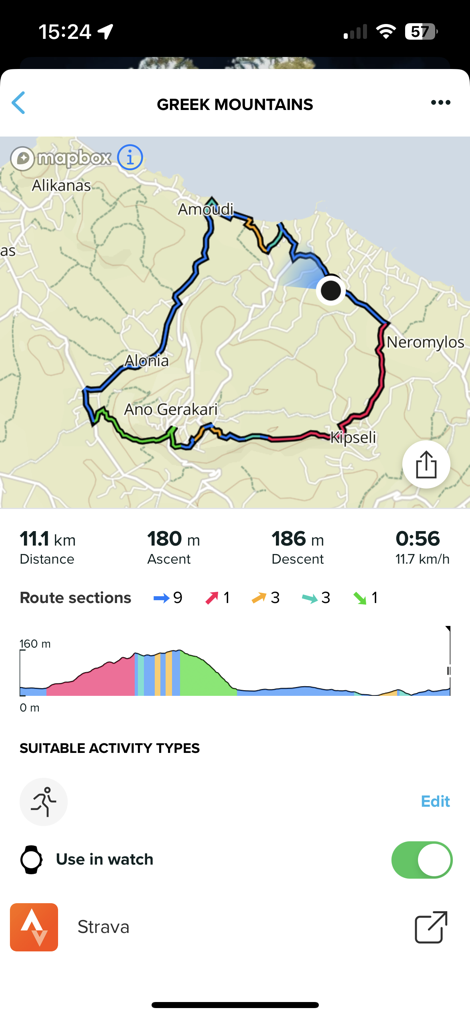
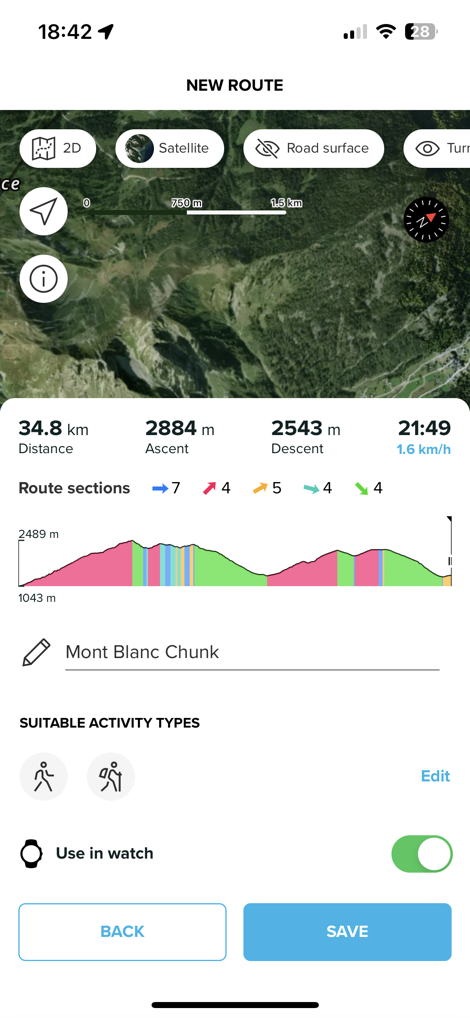
Once you’re ready to start, you’ll select the route from your route listing. You can see a quick overview of the route stats, but you can’t see the details of upcoming climbs like you can with Garmin ClimbPro. Still, this is Suunto’s first foray into climbing metrics, so it’s a good starting point.
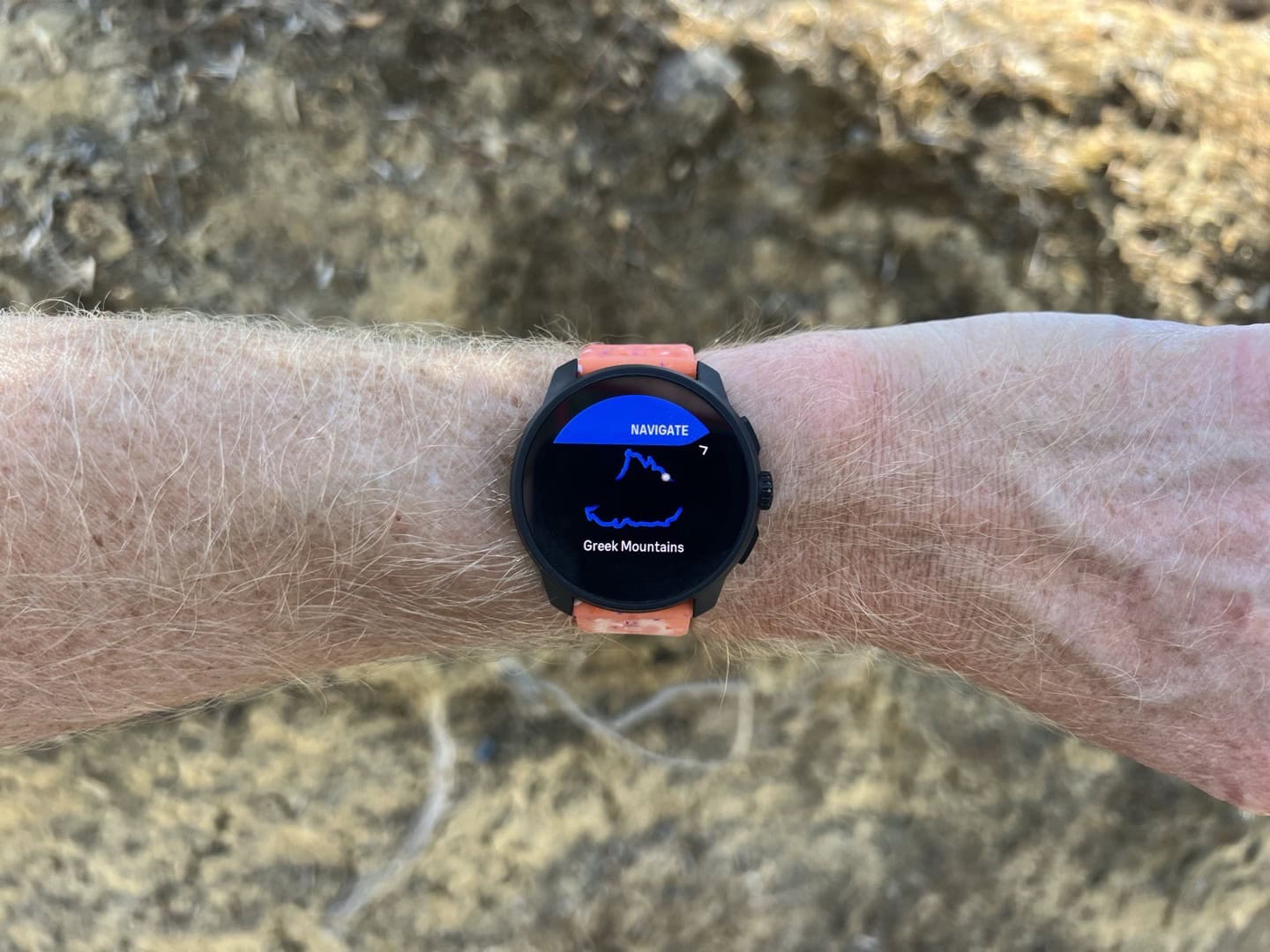
Next, once your route has started, you’ll see the route atop the map. You can zoom in, pan around, etc… This is where the new 20KM zoom limit comes in (versus 2KM previously), and is handy when you need to get a much wider picture of the area around you. For hiking, 20KM probably won’t be used much. But when cycling, 20KM is only 35-40 minutes of quick riding. Note the terrain topo map shown, though you won’t see street names/etc:
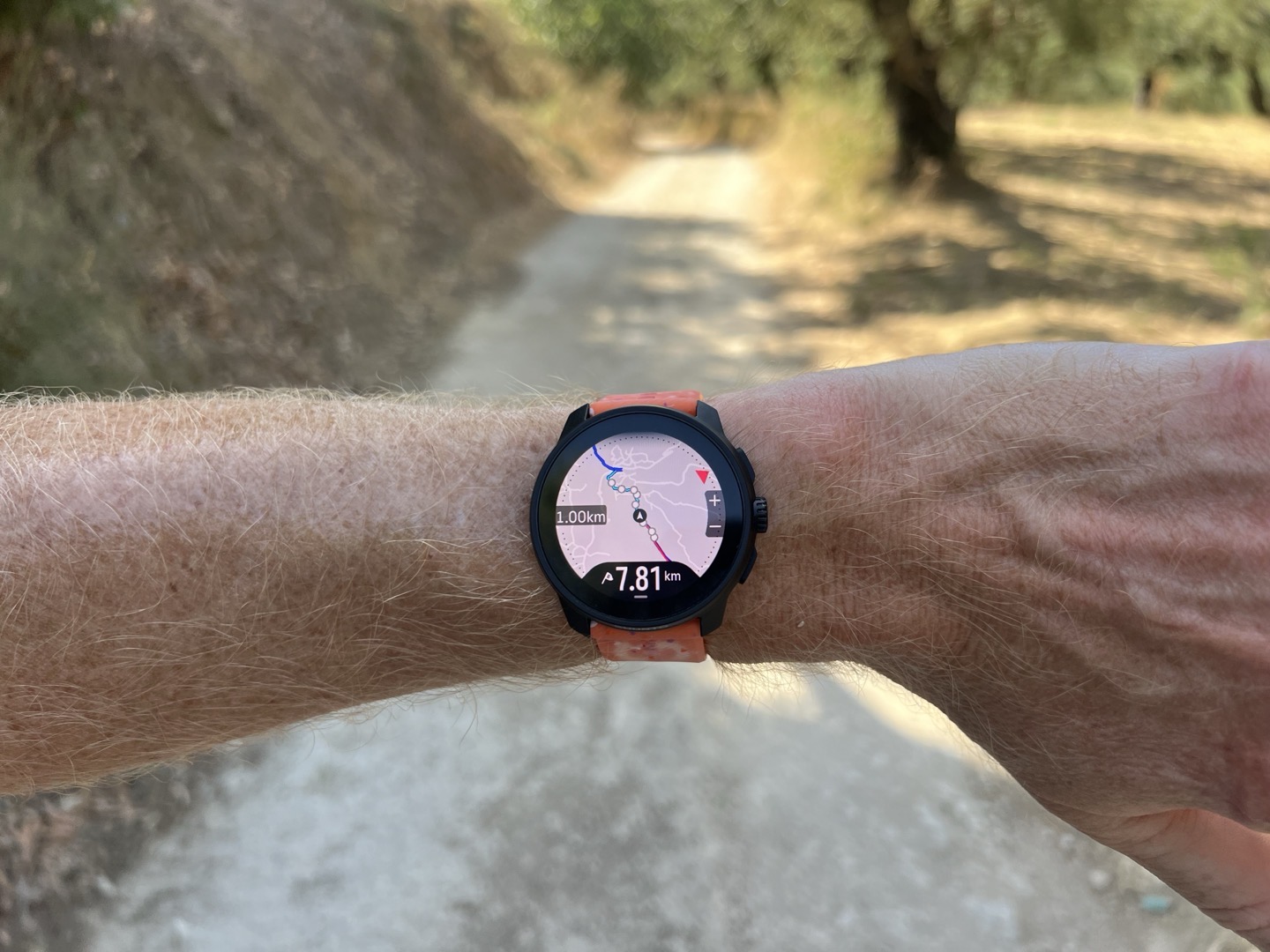
As you approach a turn, you’ll get a turn notification prompt, which no longer takes up the entire page like before. Instead, it’s just a banner along the bottom, allowing you to continue seeing your data pages. Next, as you approach a climb, it’ll briefly show an upcoming climb warning, with the climb number (e.g. Climb 1 of 4).
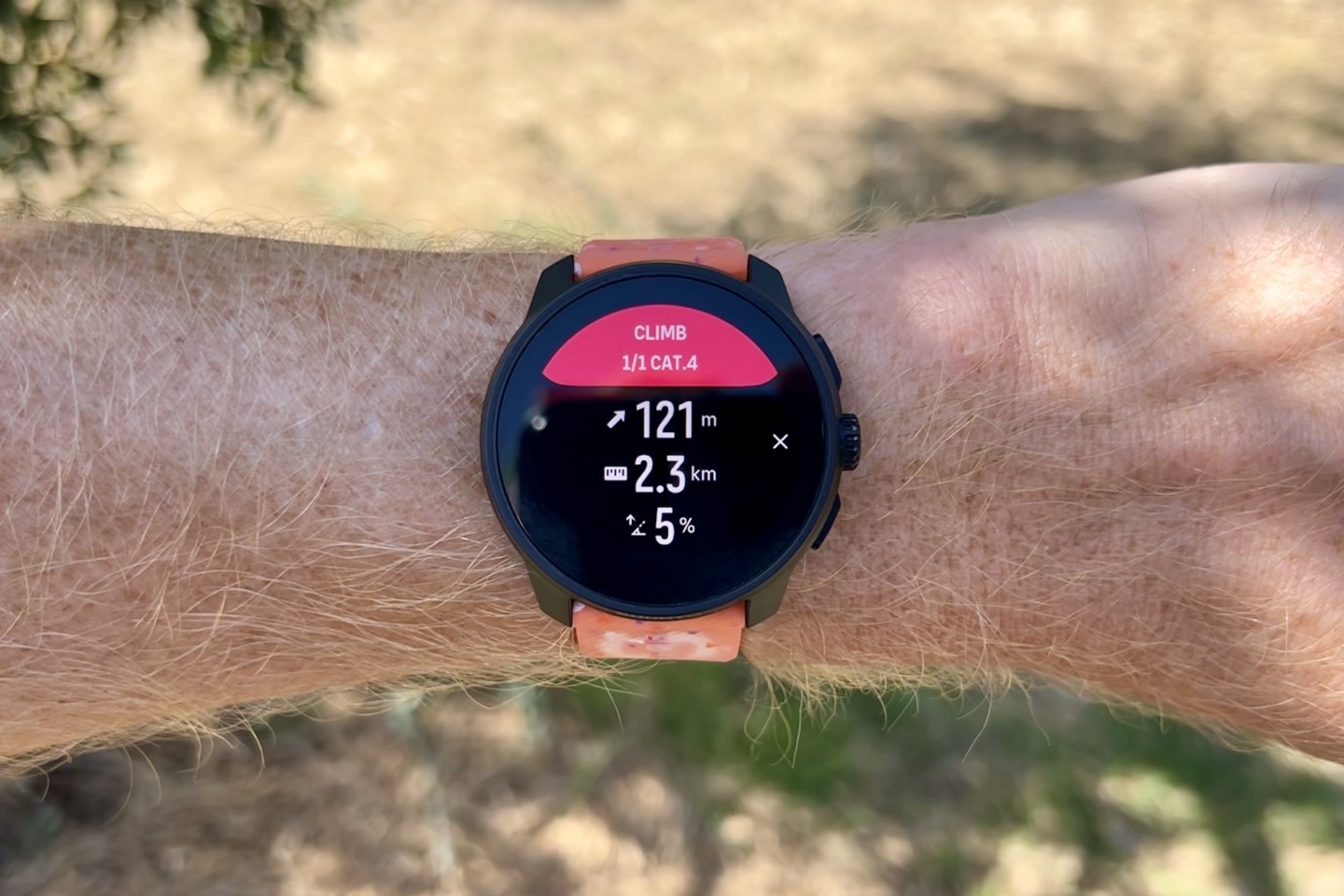
Instead, it’ll trigger the climb page to start showing up, you’ll need to press the tiny little +/- at the top right (which can be hard to see in certain lighting conditions). When you tap that +/- button, it’ll show you the new climbing page, showing your place on that specific climb, and the gradient stats:
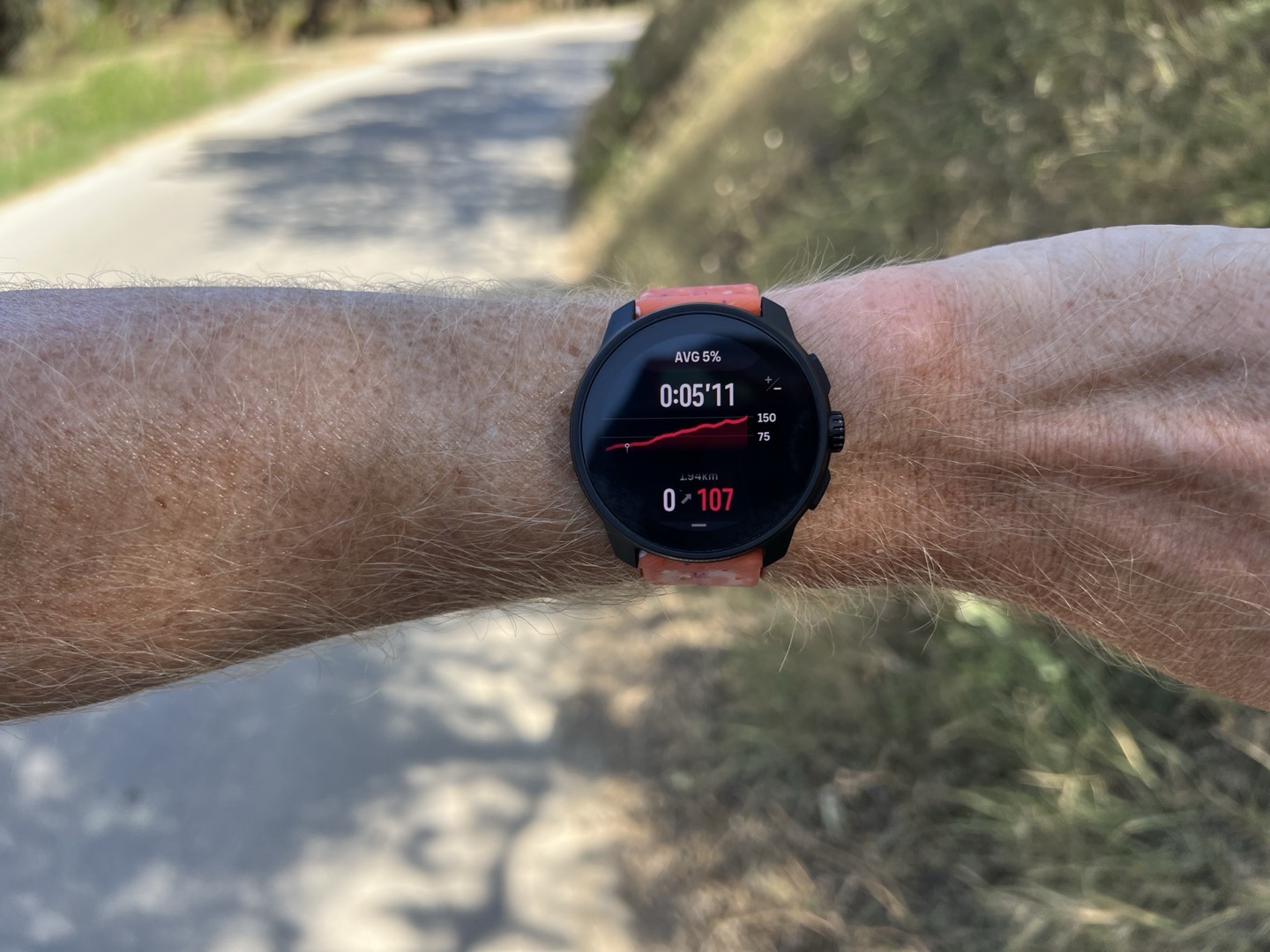
Again, I appreciate what Suunto has started to do here. It’s a good start. But, I’m looking for a bit more…flair…in my climbing metrics. The above 2.5KM climb had plenty of variability in it, from 2-5% sustained, to shorter 10-14% chunks. Plenty of pain to go around. Yet looking at the above, you’d think it was pretty much same-same all the way up.
Compare that to the below, side-by-side, shot from Garmin’s ClimbPro, showing more clearly the variations of what’s coming:
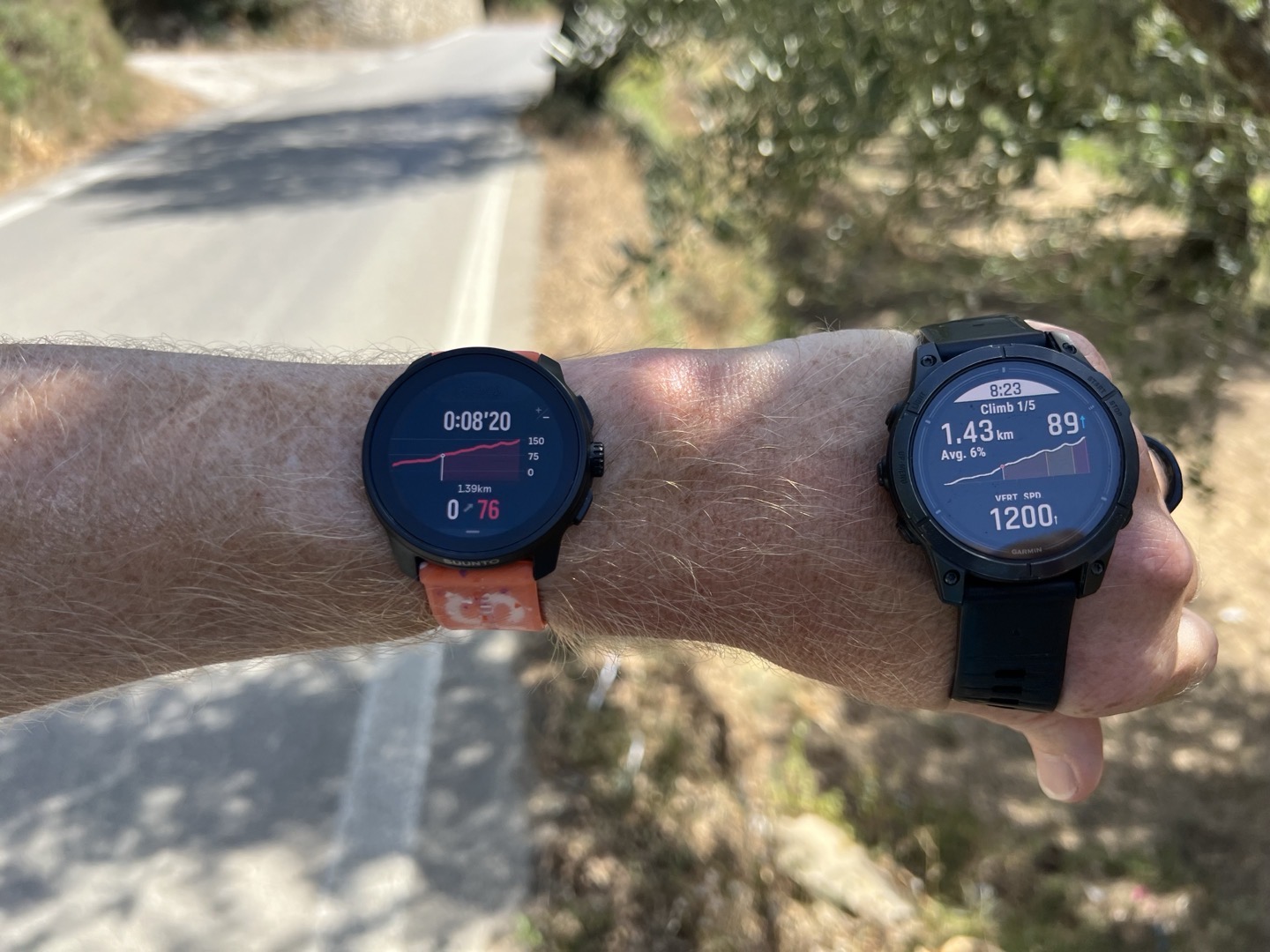
The good news is, this is something that Suunto can easily update in the future. I didn’t find any of my climbs to show anything more than a single color. So while knowing how much distance/ascent is remaining to the top is a critical metric, the color-coordinated visualizations of the grade is what seals the deal on usefulness. In any case, I had no issues with these popping up during my workouts, nor any issues with navigation.
In terms of GPS battery life burn/usage, both without and without navigation, I found that having navigation enabled did have an impact to the battery (as expected). In these cases, I was rarely on the map page actively, but on other pages instead. Albeit, some of the impact might have also been the heat. On days I was using navigation, it was quite hot (90°F/32°C). Versus the non-navigation days ended up being cooler (about 80°F/27°C). Just how the cookie crumbled. Still, here’s some random stats:
Navigation Enabled: Recorded battery burn rates with an estimation of 17-19 hours across my tests
Navigation Disabled: Recorded battery burn rates with an estimation of 27-29 hours across my tests
The 30 hours is spot-on with Suunto’s battery claims. These were measured using the DCR Analyzer, which enumerates out the recorded battery life values from Suunto’s watches (as well as Garmin/Wahoo/Hammerhead/Stages/others), and then determines the trend to estimate battery life:
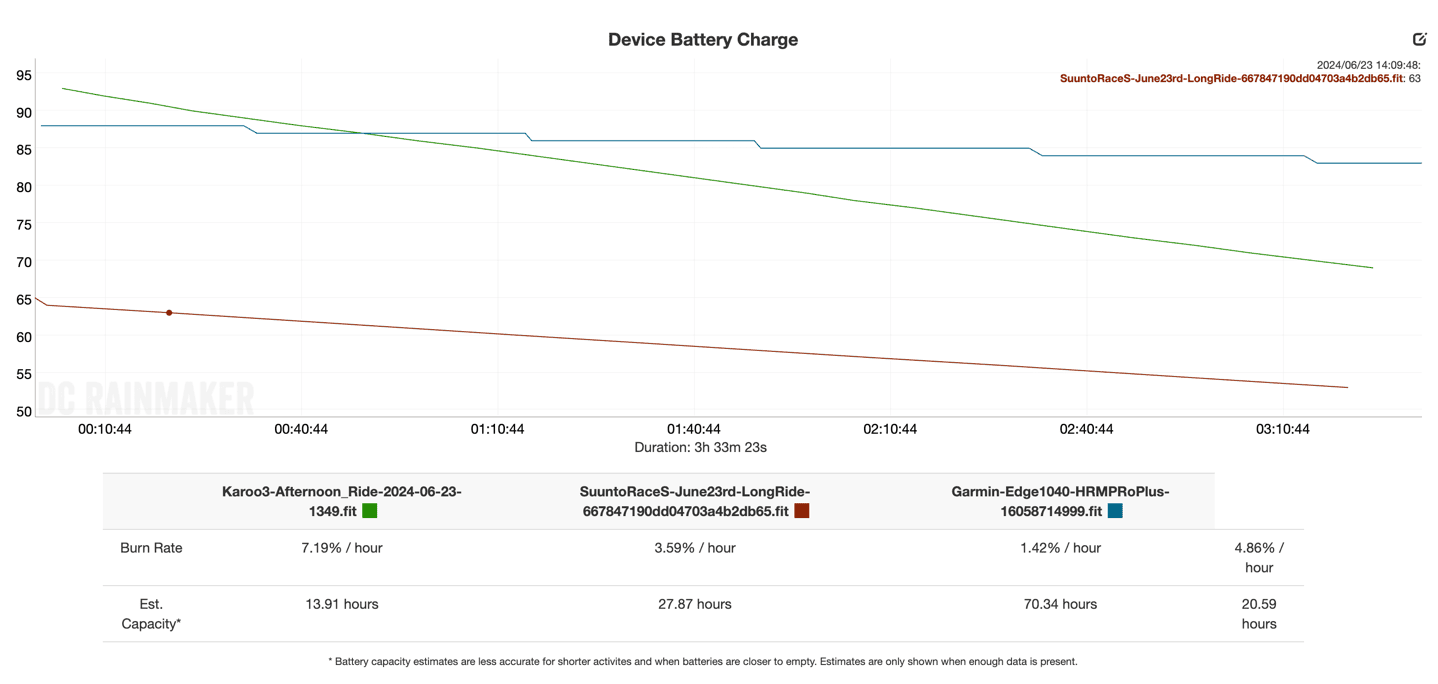
As noted above, in terms of non-GPS battery life (e.g. just daily smartwatch mode), I found the battery burned a bit faster than Suunto’s claims. Seeing roughly 3 days for always-on mode (with it in sleep mode at night), and then about 5 days for regular gesture-based display
Accuracy:
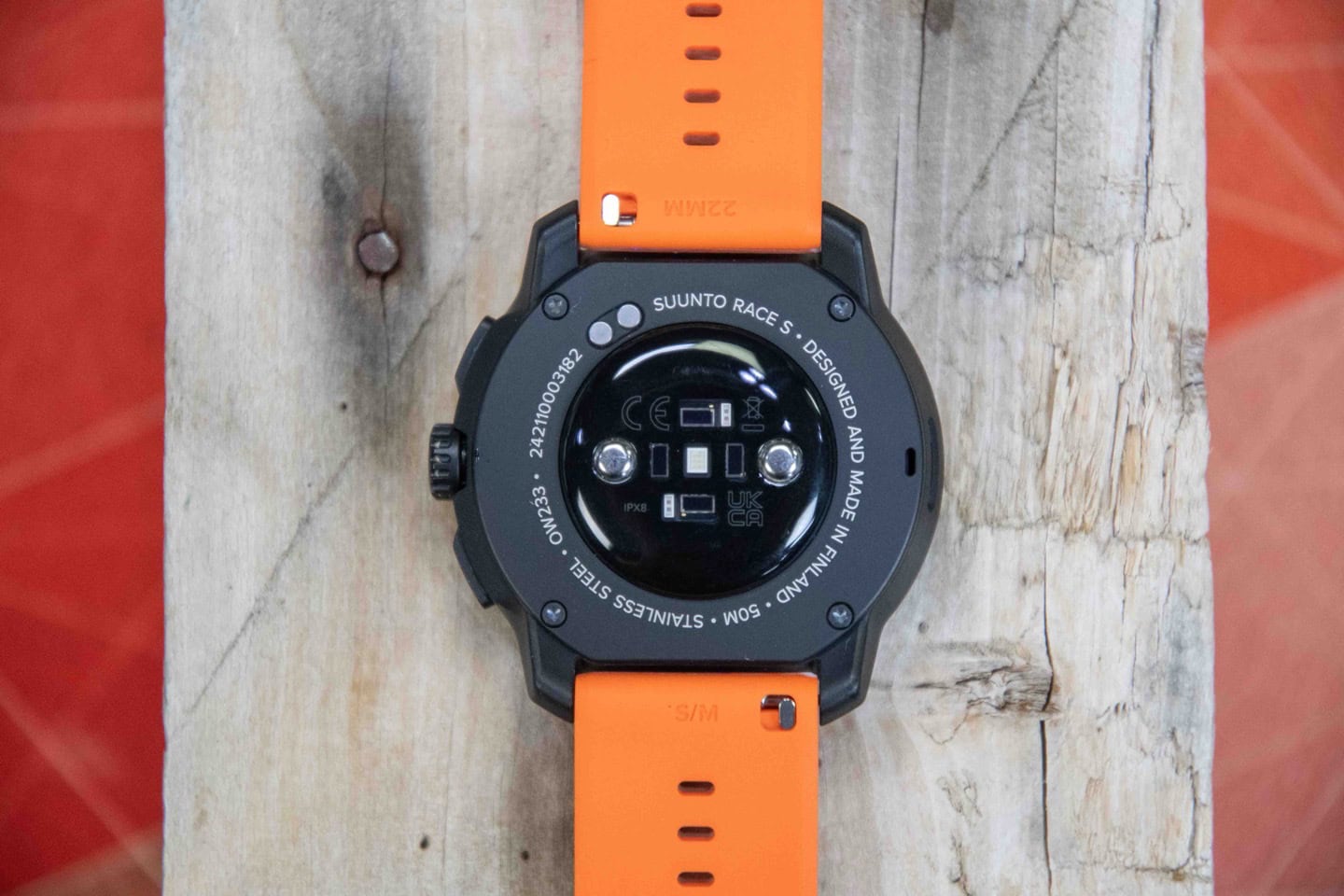
In my original Suunto Race review last year, I started off the heart rate accuracy section without any fanfare saying the “…optical heart rate sensor accuracy. It’s bad. There’s no two ways to slice it.”
Good news! Suunto clearly heard the feedback from myself and many other reviews about how bad the Suunto optical HR sensor was, and as a result, they doubled the number of LEDs, and revamped the algorithms. In turn, it went from “worst sensor in the endurance industry” to “damn, very strong”. It’s not quite Apple/Garmin good, but it nearly aced all my tests.
Here’s a run I did, relatively steady-state, and as you can see – after the first 90 seconds or so, it’s very much the same the entire time:
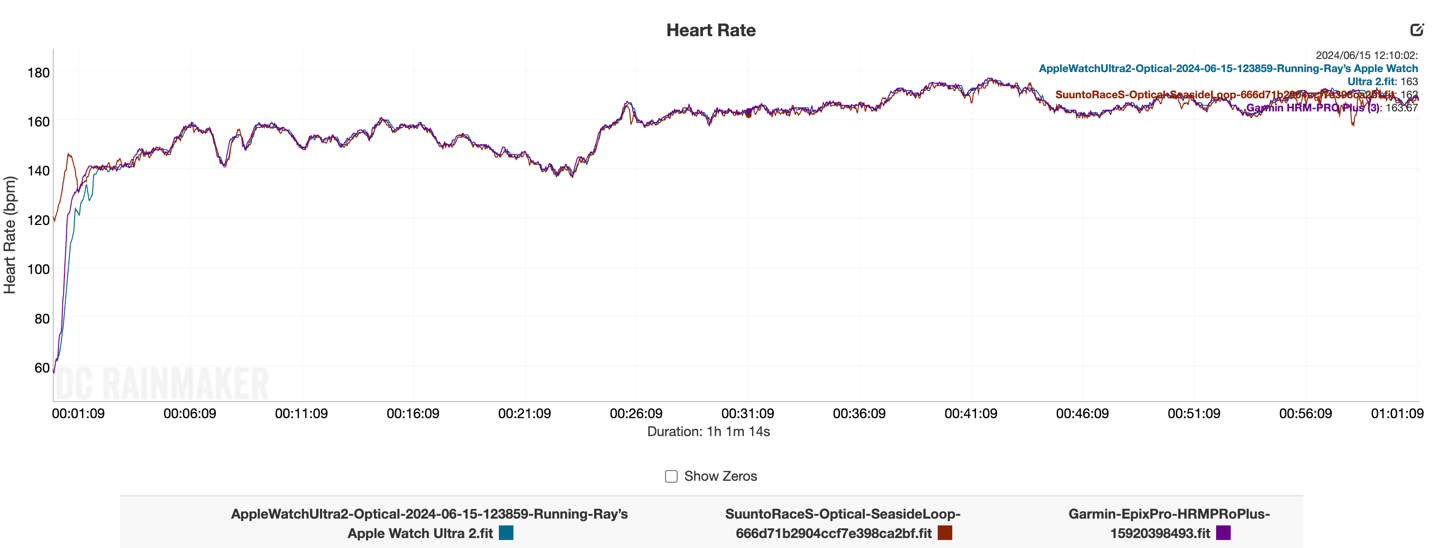
Next is a run that initially goes up a mountain nearly 1,000ft, and then eventually comes back down. An out and back of sorts, that ended up as an interval run. Everything is very solid here, minus one interesting blip at the 1hr 2min marker…when I stopped to drink water out of a faucet. It didn’t like that.
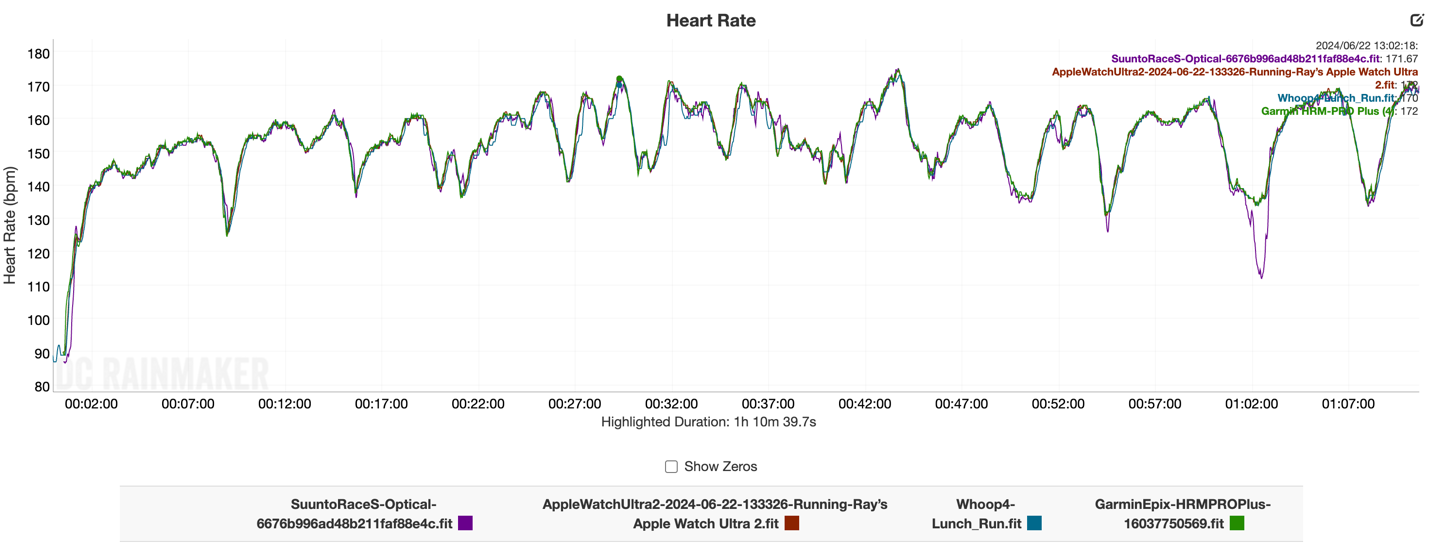
Next, we’ve got a route that includes a bunch of climbing, followed by a bunch of descending (running). This is notable because it’s these sorts of routes where you can get cadence lock while descending (where the unit will lock onto your footsteps, instead of your heart rate). However, no issues here:
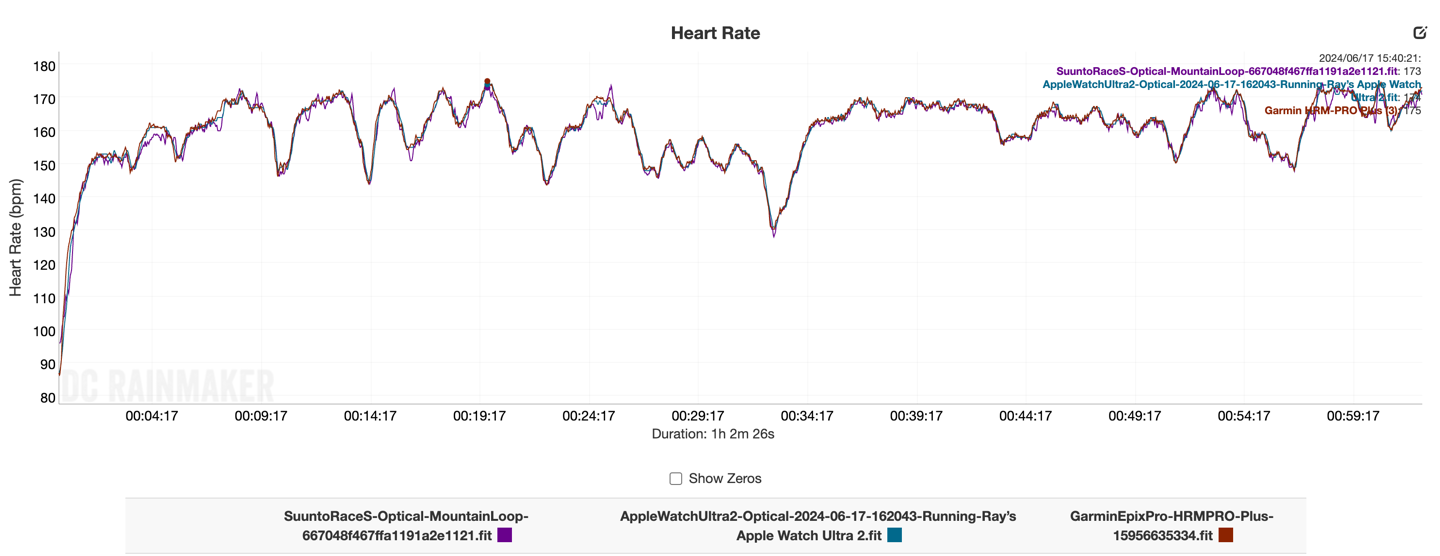
Next, looking at an interval run (800m repeats), it had no problems at all holding here. Again, we see a slight fumble in the first 90 seconds of the run, and then it’s all good. The slight fumble in the last interval is actually just me holding the camera, so I won’t hold that against it.
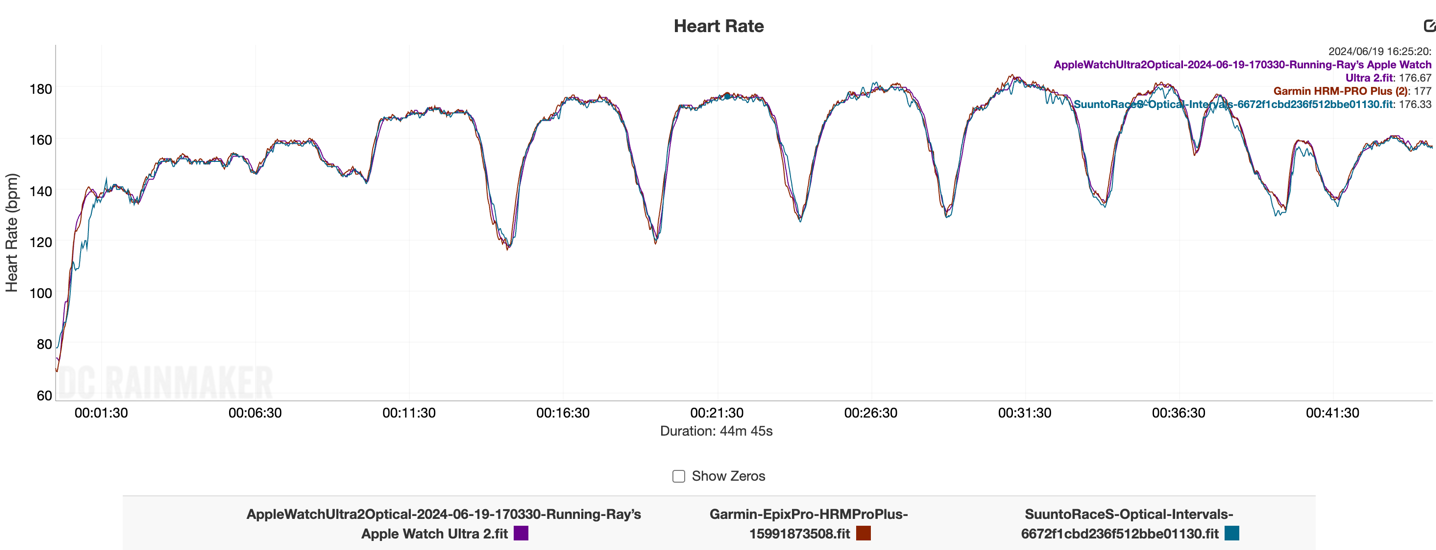
Now, when it came to cycling heart rate (outdoors), it was all just bad-bad. That’s not terribly surprising, given it’s one of the harder things for optical HR sensors to get right:
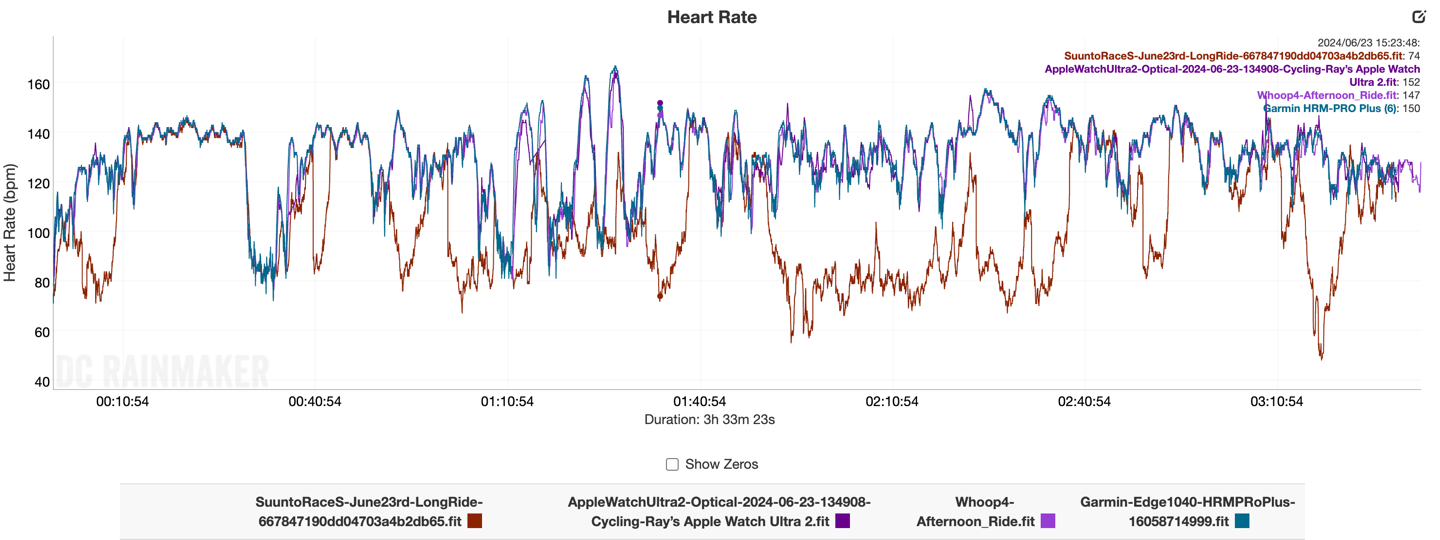
Same was true for another ride as well. In this case, the one labeled ‘Karoo3’ is the Garmin HRM-PRO chest strap source.
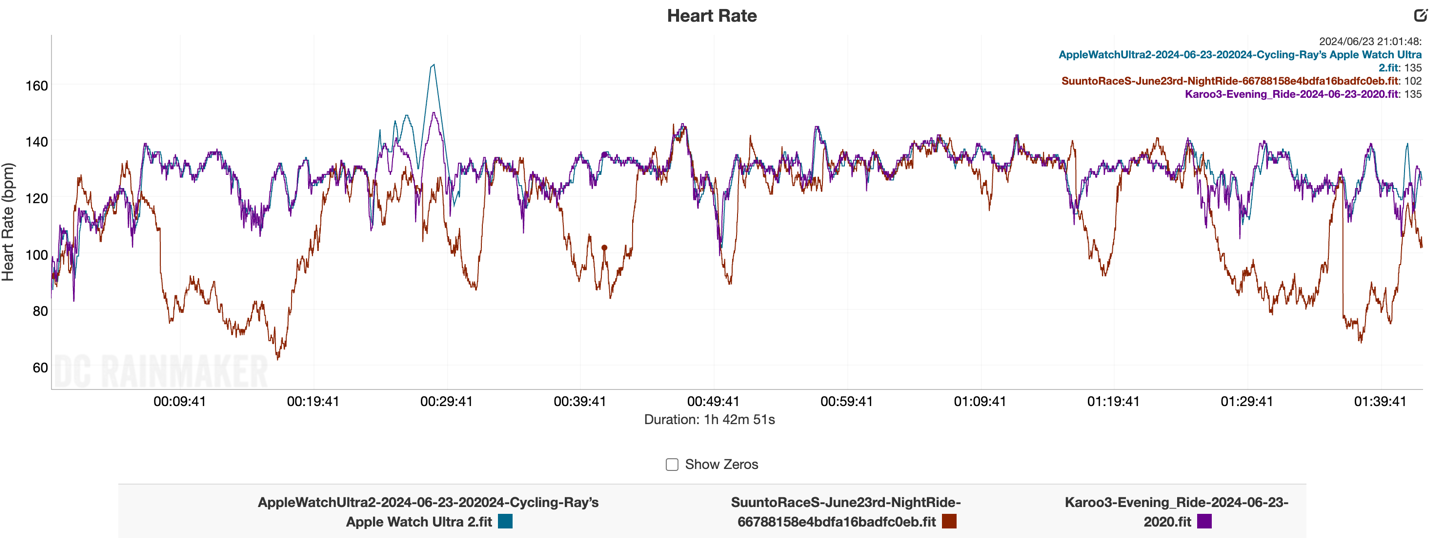
So, moving on to GPS. Suunto maintained the very strong land-based GPS accuracy, but also seemingly worked to fix the openwater swim accuracy (finally!). Even happier times. So, let’s dive into it.
First, some land stuff. Seriously, this is so boring because there’s nothing to look at. Not in the mountains, not in the trees, not in the city, it’s just…identical to the other top-end units I compared it with (Garmin Epix Pro, and Apple Watch Ultra 2), such as this run:
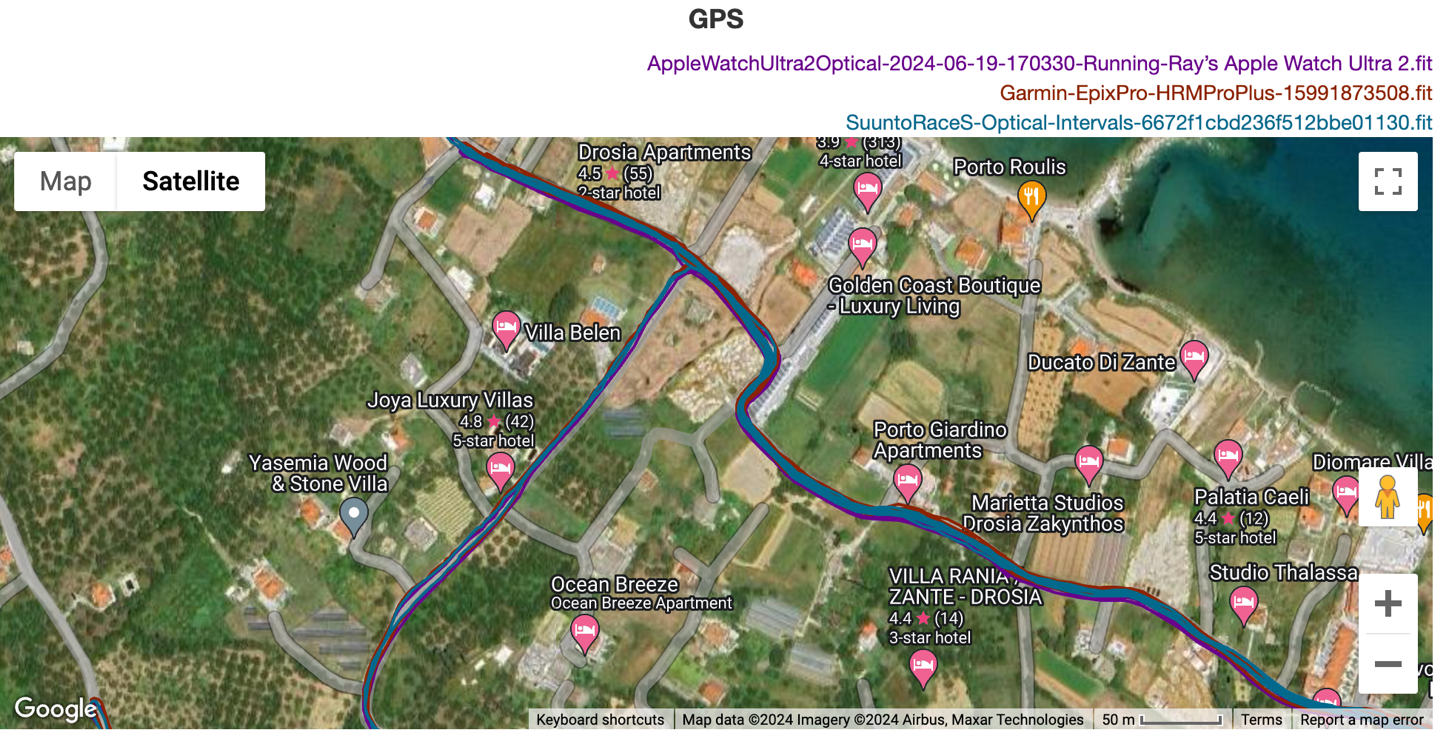
On a run in the mountains a bit, with some coverage and/or steeper sections, I had no issues with it holding lock just the same as the other units.
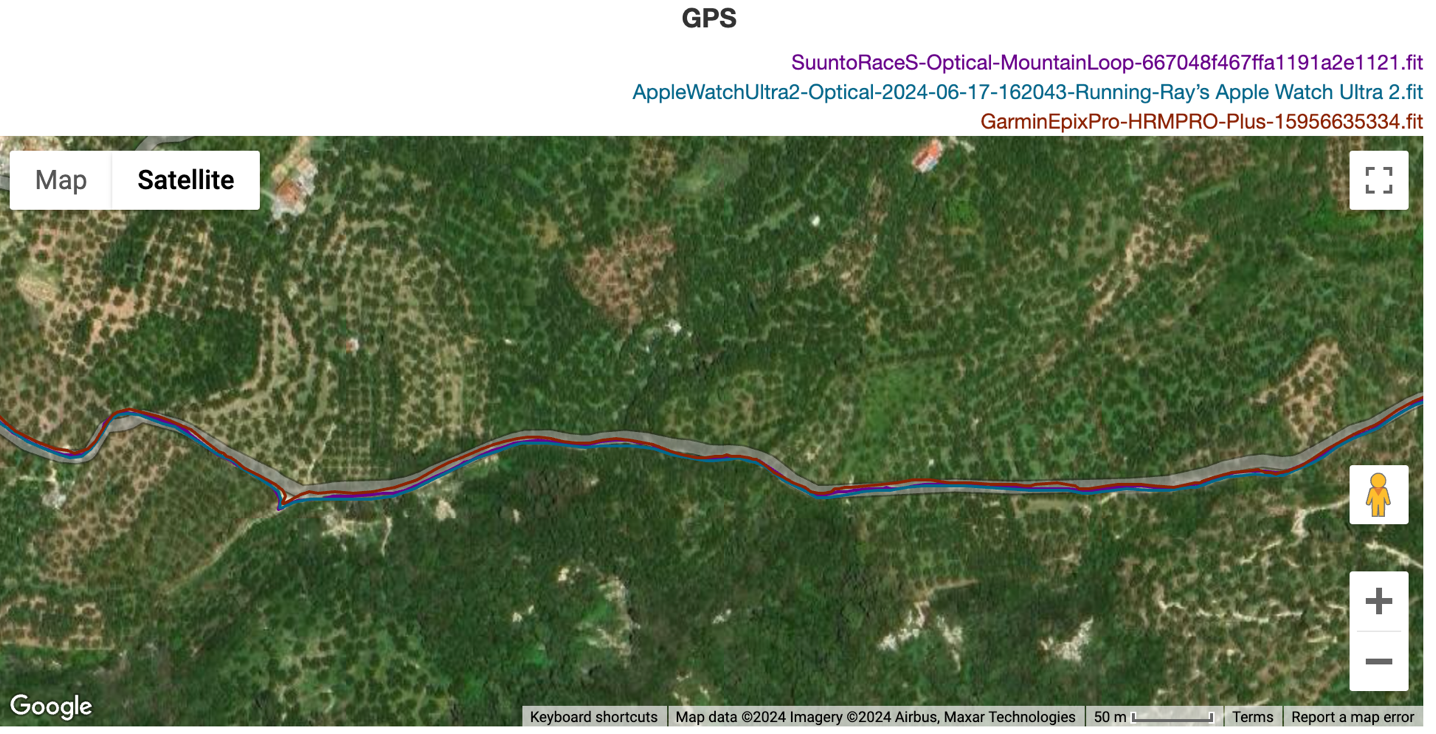
Same goes here on these small roads. This is actually a fairly steep section descending (12-15% grades), and didn’t see any meaningful differences here between units.
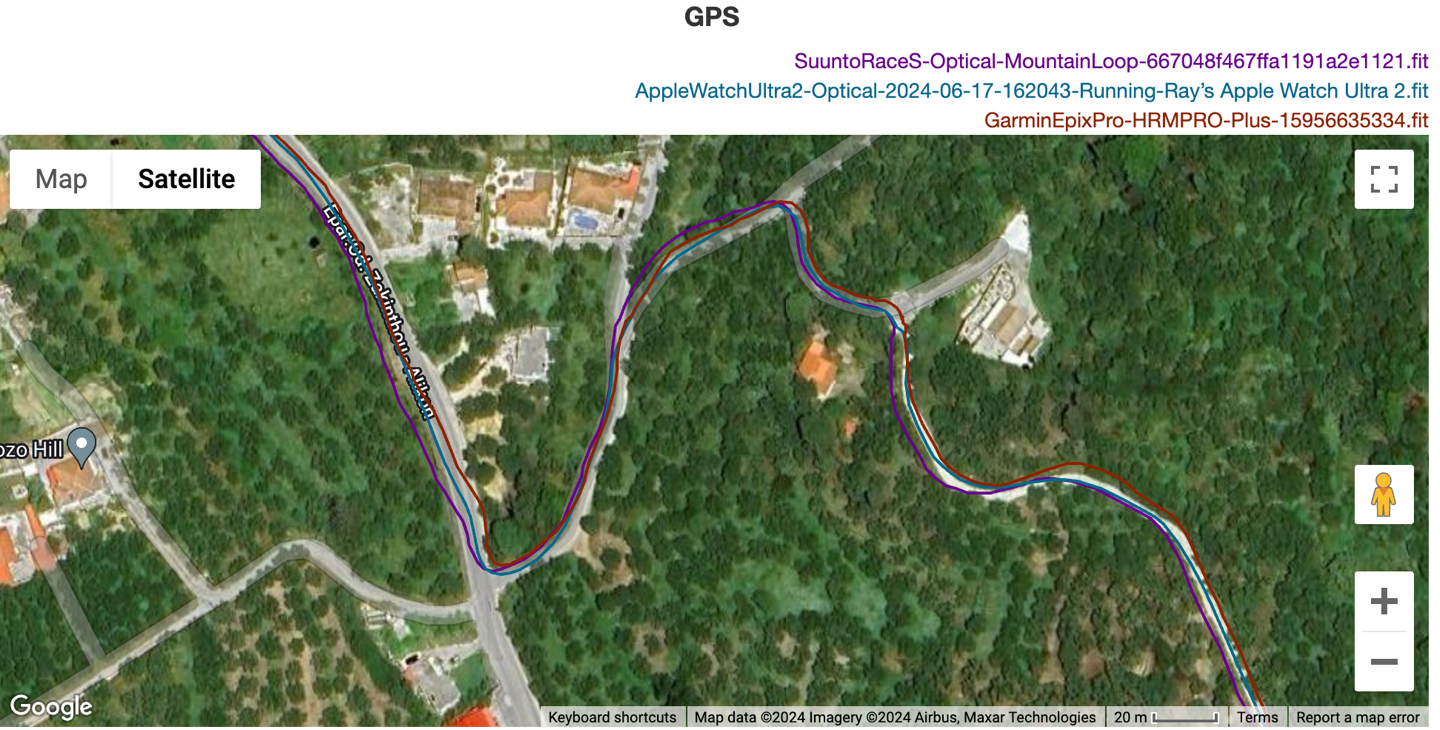
If we look at cycling routes, again, it’s all virtually identical to a heap of different bike computers:
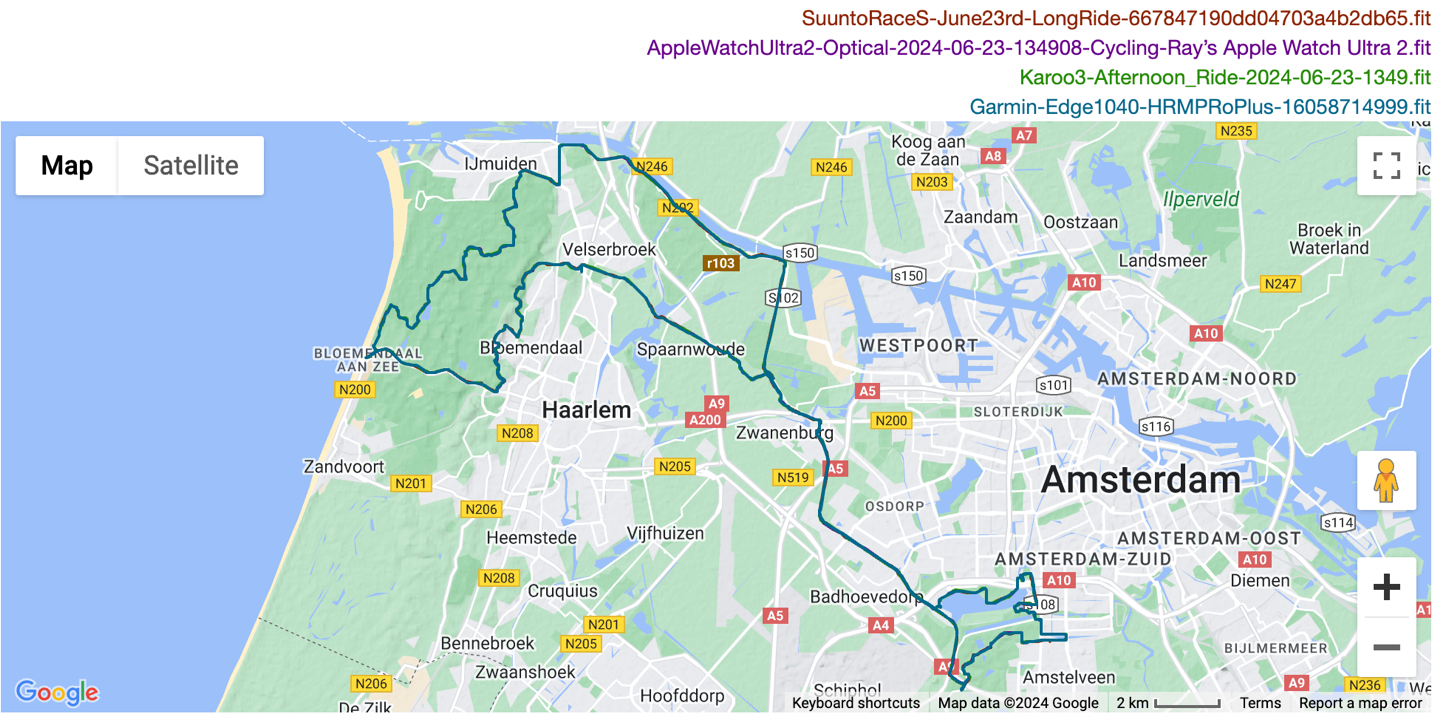
And no matter where on that entire line I zoom in, it’s all just like this, boringly the same:
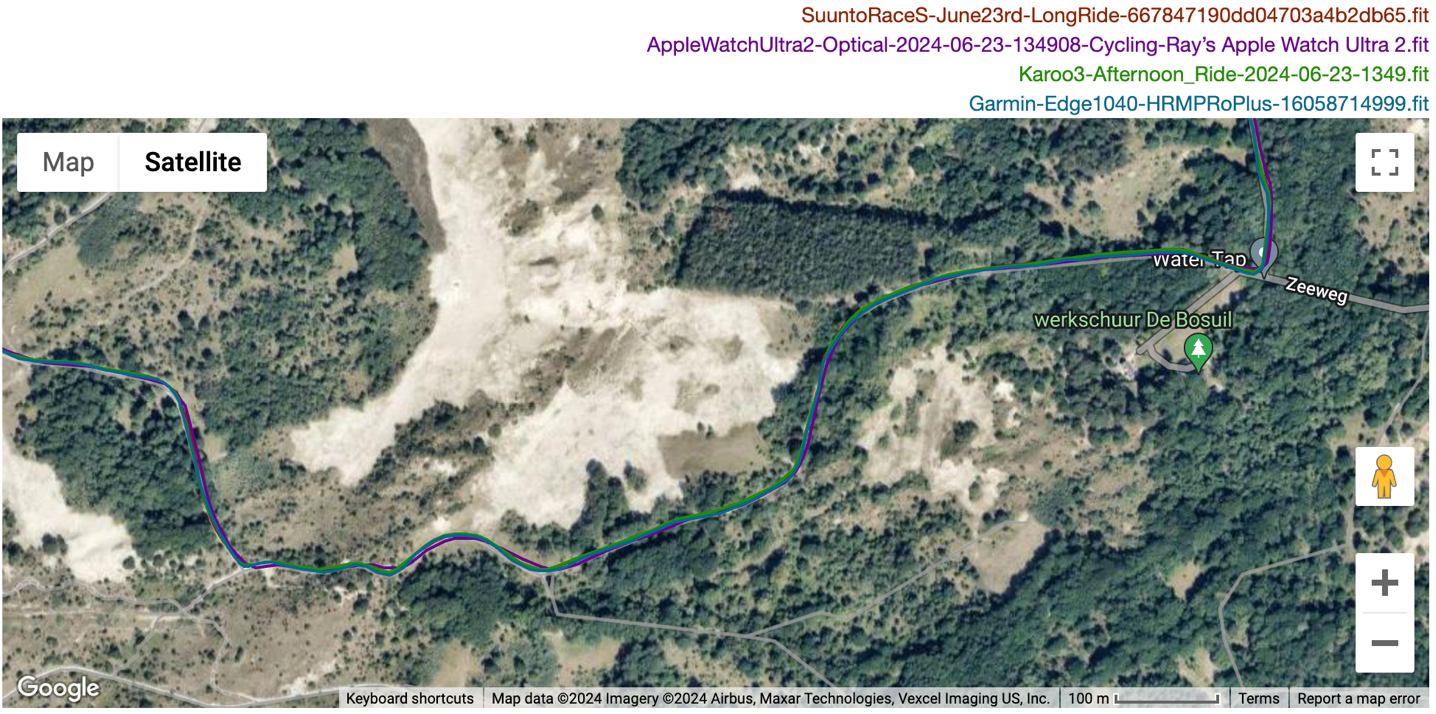
So last but not least – what about openwater swimming? After all, that’s long been the most challenging thing for Suunto to get right. Well, finally, they did:
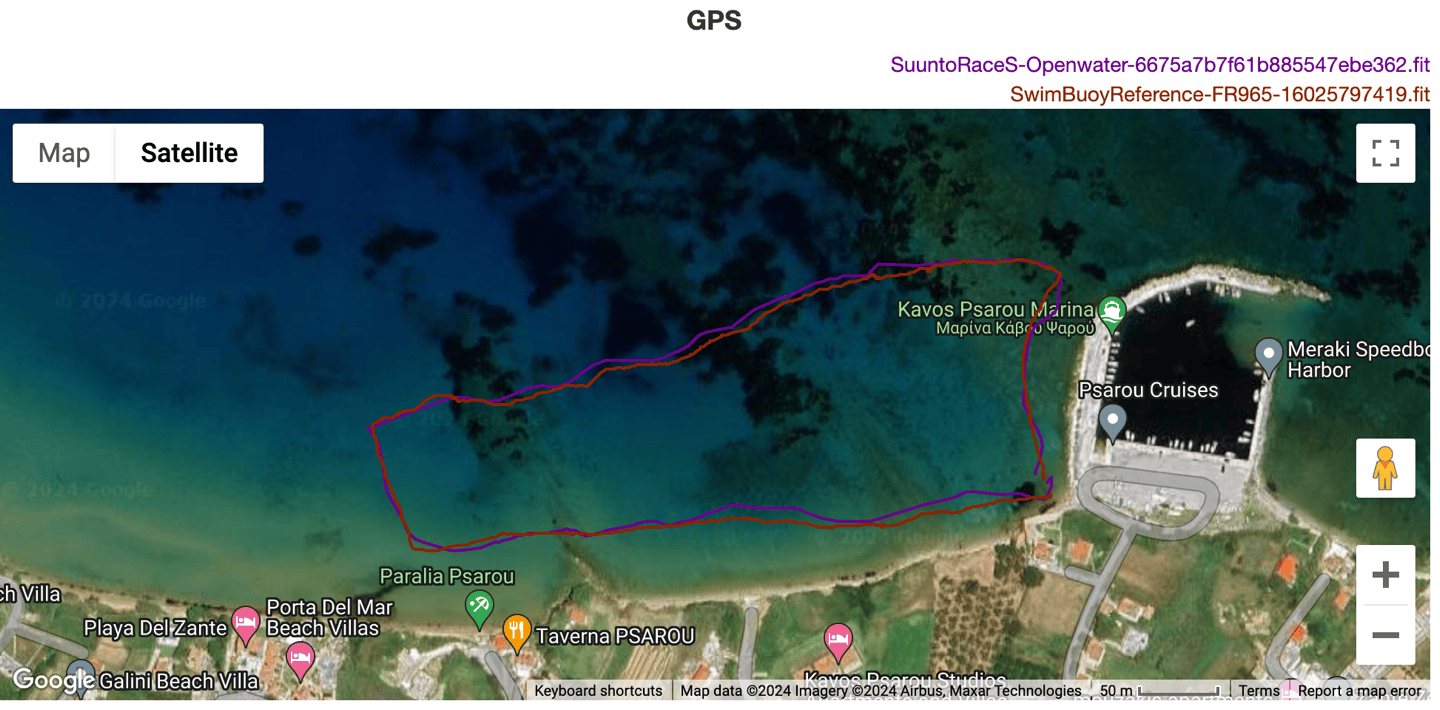
Or at least, pretty good. Sure, it’s not quite as perfect as you’d see from Garmin’s openwater swim tracks, but this is a massive improvement over the Suunto Race.
Ultimately, there’s some very solid improvements here. The biggest is clearly optical HR, which went from ‘very not good’ to ‘very solid’, at least for running. Meanwhile, for GPS, it maintained the accuracy I saw previously for land-based activities for the Suunto Vertical/Race, and improved upon it for openwater swimming.
(Note: All of the charts in these accuracy sections were created using the DCR Analyzer tool. It allows you to compare power meters/trainers, heart rate, cadence, speed/pace, GPS tracks, and plenty more. You can use it as well, more details here.)
Wrap-Up:
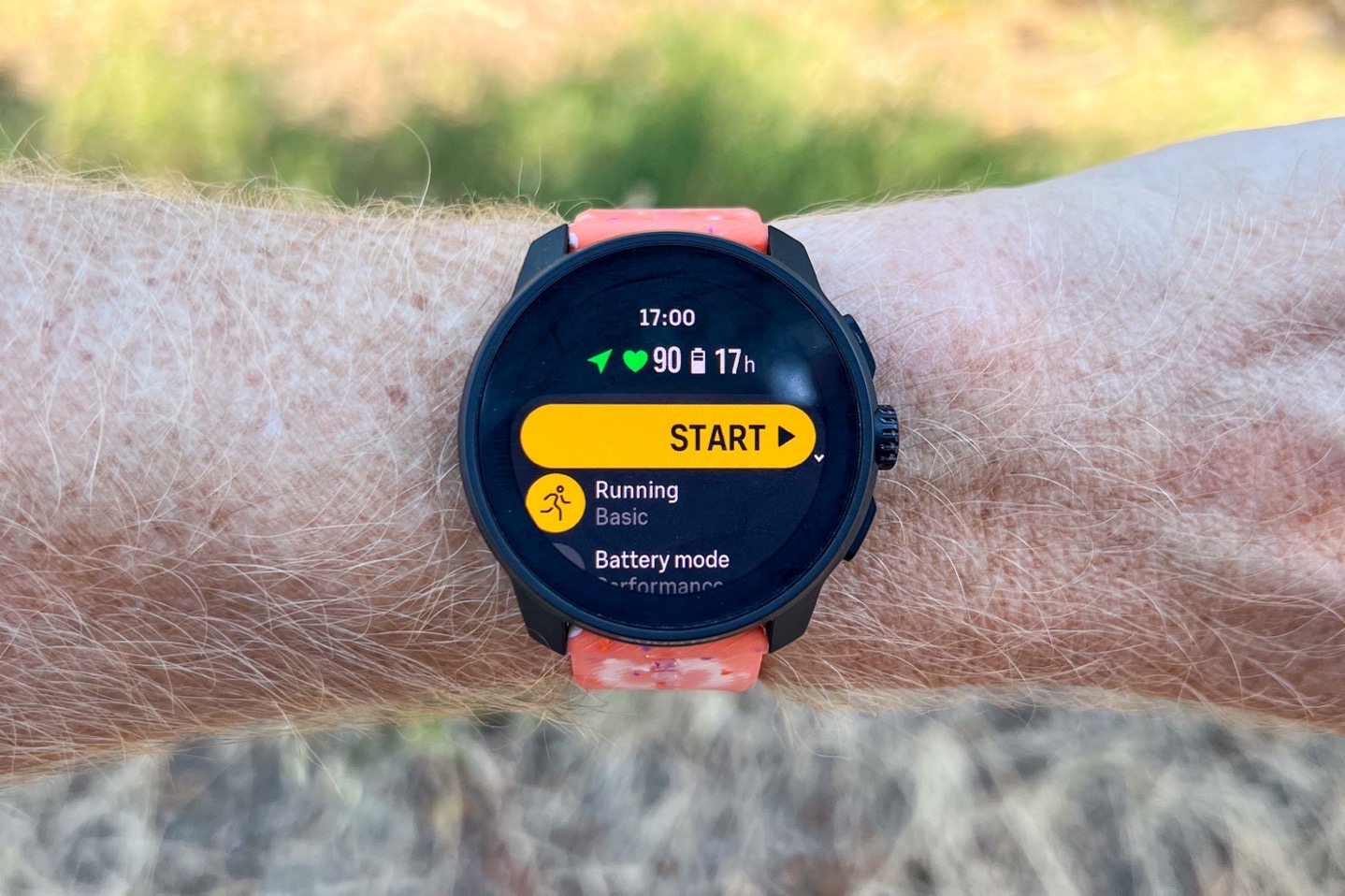
Just over a year ago, in Spring 2023, when Suunto released the Suunto Vertical, I commented that it appeared Suunto was turning the ship around on hardware – but needed to work on the price side. Then, last fall when they released AMOLED-based Suunto Race at $449, building upon the Vertical’s features, but dropping the price, I said in my review summary “this appears to be Suunto’s best watch ever.” I went further and noted that if Suunto wanted to be in the mix, they had to keep doing what they were doing in terms of pricing – but that they had to improve in accuracy.
Turns out, they did both. Strongly.
Bringing the Suunto Race S down to $349 is astonishing. All while increasing optical HR and openwater GPS accuracy, increasing responsiveness, and increasing a slate of features. They more than stuck the landing. One might argue they went for blood. Not Garmin’s blood, but COROS and Polar’s blood. The pricing here seems designed specifically to cause severe heartache for those two brands. Garmin can still lean on more features, deeper mapping/navigation, and other smartwatch stuffs (payments/music/etc…). But Polar and COROS? This significantly undercuts their pricing strategies, even more than the $449 Suunto Race did.
Now, that said, there’s still some areas Suunto really needs to work on. Everything and anything to do with paired sensors (e.g. cycling sensors), mostly sucks. Likewise, as awesome as the ever-growing collection of on-watch Suunto Apps are, these need to start being baked into the core watch functions, as opposed to being a ‘pick only two’ choice every time. Suunto is doing great work here, it just needs to be consolidated into the core product, else most people won’t bother to use it.
Still, Suunto is nailing it with the Suunto Race S. And like I said with the prior Suunto Race review – I hope people reward them for that. Their decisions illustrate that they not only have a plan, but are executing on it in a way that’s clearly aimed at increasing market share.
With that – thanks for reading!
Found This Post Useful? Support The Site!
Hopefully you found this review/post useful. At the end of the day, I’m an athlete just like you looking for the most detail possible on a new purchase – so my review is written from the standpoint of how I used the device. The reviews generally take a lot of hours to put together, so it’s a fair bit of work (and labor of love). As you probably noticed by looking below, I also take time to answer all the questions posted in the comments – and there’s quite a bit of detail in there as well.
If you're shopping for the Suunto Race S or any other accessory items, please consider using the affiliate links below! As an Amazon Associate I earn from qualifying purchases. It doesn’t cost you anything extra, but your purchases help support this website a lot.
And finally, here’s a handy list of accessories that work well with the Suunto watches. Given the unit pairs with standard Bluetooth Smart sensors, you can use just about anything though. I'd recommend the Garmin bike sensors over the Wahoo ones, merely because the Garmin have two concurrent Bluetooth channels versus one for the Wahoo RPM/SPEED sensors.
And of course – you can always sign-up to be a DCR Supporter! That gets you an ad-free DCR, access to the DCR Shed Talkin' video series packed with behind the scenes tidbits...and it also makes you awesome. And being awesome is what it’s all about!
Thanks for reading! And as always, feel free to post comments or questions in the comments section below, I’ll be happy to try and answer them as quickly as possible. And lastly, if you felt this review was useful – I always appreciate feedback in the comments below. Thanks!



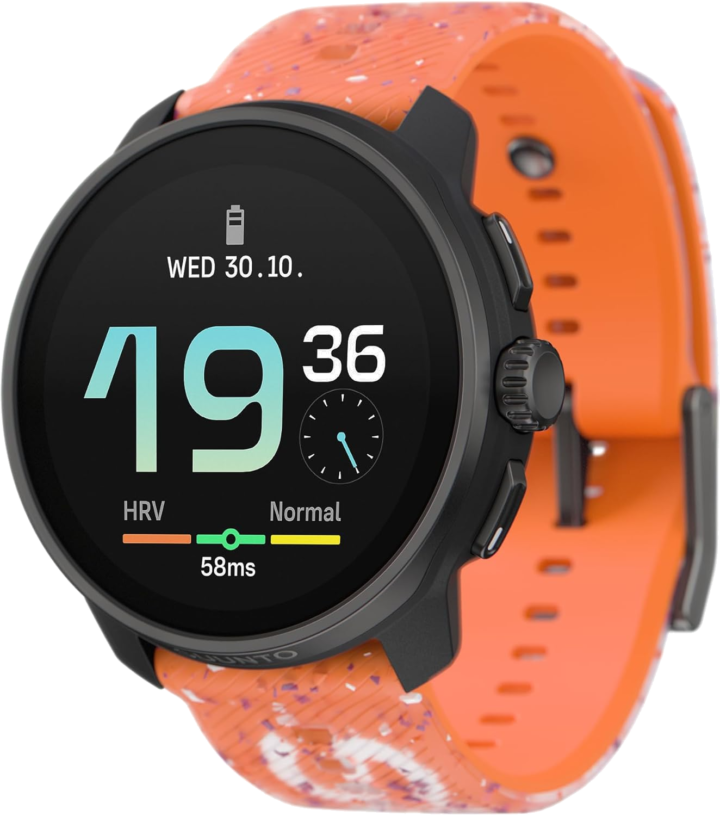
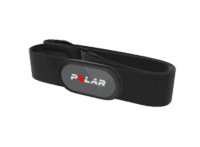
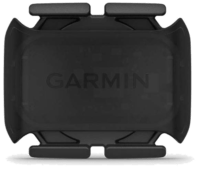
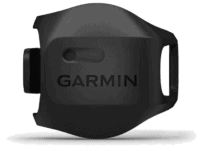
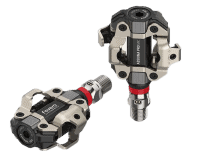
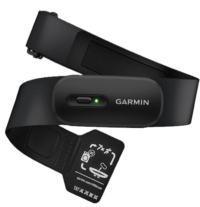

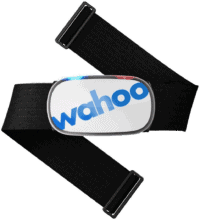





















Love it, but can’t live without the 2024’s smartwatch features (music, contactless payment, not having to carry a phone when I exercise).
I’ll love if some day you test Suunto’s Sport Tracker app, it is like the Suunto app for non-Suunto smartwatch users.
Yeah. Suunto, Polar, Coros, Wahoo, Amazfit, etc need to team up to form a company that produces a chip solution for contactless payments that they can add to their watches. This will solve the cost/scale issue.
The problem isn’t the tech side. That’s actually kinda the easy side.
The real problem is having enough clout to go to banks and get them to say ‘Yes’. Due to the way the payment processing industry works, this has to be done at the card issuing bank level. Thus, it’s the worst kind of house-to-house fire fighting, since you literally have to go to every bank in the world.
When you walk up to those banks, you have to have user big enough user numbers to make their effort worthwhile. Even the collection of all those companies, wouldn’t be known to 95% of bank IT managers that’d make those kind of decisions.
From a business standpoint, Garmin’s acquisition of one of the only independent payment solution providers back then was pretty brilliant.
In many ways, it’s the same exact story for Spotify, Amazon Music, etc…
At least for the contactless payments solutions goes, I noticed Polar is selling the NFC payment enabled wristband by Fidesmo. I don’t know how well it works, but it appears to be fairly simple and slick solution without having to worry about cost/IT resources/development/hassle of dealing with banks, etc.
Yeah, essentially the Fidesmo stuff is basically just a NFC tag tied to a prepaid card from a single bank. There’s actually zero integration with watches.
Nothing wrong with such a solution, but it’s very different than something actually tied to your bank.
That’s why I was thinking maybe it’s better if they got together and setup an independent third party company to do it. The third party creates the chip and works with the banks to approve the chip. The manufacturers then pay the third party to add the approved chip onto their watches. Kind of like how they used to license Firstbeat algorithms. Yes, Suunto, Coros, Polar and Wahoo combined might not be big enough, but if they can rope in Amazfit, that will give them the scale.
On the fcc site the suunto run ow234 appeared. looks a bit like a lighter and cheaper version of de race s, no wifi (and mapping support) only 4 GB storage. But there is a ‘music’ folder under that 4gb storage section in the manual, and nfc (at least an alipay widget in china).
Small comment. The race is 100m and the race s is 50m water resistant (according to the back of the watches, annyway)
But impressive watch!
Great review as always, although I have say I’m over hearing how good Apple Watch oHR is. I’ve had my AWU2 for 8 months now and it’s just awful. Usually 20 beats below my Polar H10 strap. I never use it now without a HR strap connected. So just putting that out there…
Suunto is back in a big way. Their pricing is ridiculously good here in Australia where Garmin are basically pricing themselves out of every market. Their watches, despite being good, are just way too expensive for almost everyone. So the timing is right for Suunto to regain some lost market share. The SRs looks great!
You wrote in the comparison:
“Maintains same 50m waterproofing”
but in the comparison picture from Suunto it says that the Race is waterproof to 100m?
But there media stuff seems to be a bit unlucky anyhow, if you read the battery one with the asterisk, it says “Great battery – without training”. Bit unfortunate ;-)
That battery disclaimer is the same as *all other brands.* They can’t given you all-day battery life estimates with training because they don’t know how much training you’ll be doing in the first place. As a result, they split out battery life into smartwatch/all-day and training/GPS activity modes.
Thanks – good catch on 50/100.
Apologies if I missed this, will the software features be coming to the Race?
Yes!
Thank you for your review. I almost bought an S Ocean. Race S looks very good but my old eyes want bigger screens. On the other hand, it probably has better HR and the price is less than half of Ocean.
Now I don’t know what to choose :(
Hi Ray,
cool review- thanks! :)
As many features are software based (Emojis, Turn-by-turn etc.) are these also coming to the original Race?
Also a question regarding turn-by-turn, are they still popping up randomly? I find myself mostly disabling the turn notifications due to the full screen (fixed now in Race S) but also because they are popping up at random distances and mostly at useless distances (e.g. turn left in 609m in trail running szenario).
Thanks!
Yes, all software to the Race.
I haven’t had TBT’s pop-up randomly, but perhaps that’s from bad insertion points?
Question: Can this watch be used for just navigation, meaning: starting navigation and then at some point stopping the activity and saving the route, instead of navigation linked to a sport or other activity?
hope this makes sense, similar to using the Garmin Inreach mini to start tracking a route and then later stop the tracking and save the gpx file? I’m hoping that somehow this can be done. thanks!
Hello,
Yes you can. Go to the Map widget/menu, choose a route. It’ll then ask you if you want to start an exercice, or just navigate.
Hi Jeremy,
but still, then it is linked to a route? I would like to navigate randomly and afterward save the “activity” as a new route. Not navigate along an existing route.
thanks!
to clarify… when tracking while busy with an activity, the route will be saved, but lots of other data as well. From time to time I would like to have the option of just saving a route and nothing else… for example, starting a trip from my home driving to a location and afterwards getting out and walking up a mountain and then saving the whole trip (driving and walking) as one gpx file. I suppose one can “hack” it by creating a new activity type eg “Route mapping” with HR etc disabled and then just logging everything… thanks.
Is the barometer hole located on the back against the wrist ? It seems so and from my experience in the past this will cause all sort of problems with altimeter/barometer readings because of sweat.
Hi Ray,
It is possible to elaborate a bit on recent news that Suunto lays off 76 out of 300 staff? Does it impact Suunto Race S production?
link to the5krunner.com
No impact there.
Great review, as always Ray! 👍🏻
This new Watch is such a Good Sign that Suunto is going in the right direction.
I have a small question: did they say if all the software updates will be available as well on the Suunto Race?
Yes, all to Suunto Race.
Do you think the software upgrades will also increase the accuracy of the Suunto Race? Because if I understood your other review correctly, it is not really the hardware that was bad in the Suunto Race but they made some strange choices here and there in software
It won’t increase the HR accuracy, as that’s dependent on the new sensor. But everything else it’ll get.
Hey :)
just a short question, will you test the Suunto ocean also?
Many thanks
Working on it. A unit was sent, and it’s basically gotten lost by UPS. And been pretty well lost now for a while. Suunto is untangling it.
But it unfortunately missed my trip to Greece, so I don’t quite know when I’ll be in diving realms again.
Would be nice if the Ocean puts some pressure on Descent pricing which is justifiably pretty high right now, or even pushes Garmin to add diving to the Fenix/Epix line once and for all
Yeah, though, the Descent G2 is priced very similarly.
The only downside to the Fenix/Epix getting diving, would be if that would significantly slow firmware updates, like it does today to the Descent lineup (due to added safety checks they do).
There’s no technical reason that takes more time, I suspect what’s happening is the Descent team pulling Fenix changes into their own repo, which could easily be done differently while maintaining safety. I worked in air traffic for a while and safety definitely doesn’t mean slow.
There’s nothing stopping them having two firmware streams on one hardware platform either, if divers are behind either way then it would be nice to be on the latest hardware with lagging firmware features rather than an often lagging hardware platform with lagging firmware 😂 The option to “upgrade” and lose dive temporarily would be acceptable too. I’d at least like to see snorkelling like some others have added using the standard baro sensor.
Descent G2 eh? ;) I assume you mean mk2 which I didn’t think was cheaper enough compared to the mk3 and the G1 isn’t comparable in my eyes.
Yeah, meant G1, versus MK3. G1 is only $400ish depending on where you buy it. MK2/MK3 are obviously a ton more.
As for firmware testing, we see the same thing in the aviation side. Garmin spends far more time doing QA on those firmware updates than others. It’s less about slow, and more about less versions to test/validate.
G1 I think will struggle against the Ocean unless people are in the ecosystem. I’d have bought one by now if it were more of a 265+dive rather than an Instinct+dive as I don’t dive often so can’t justify the Mk2/mk3 alongside an Epix/Fenix.
The Ocean looks a reasonable mix of everything though, and if nothing else it’s Suunto’s first dive watch for many years, I think since the algorithm debacle and lawsuit so I can imagine it selling like hotcakes to their existing users. For Dive I’m still using a Stinger as they’ve not really given any reason to upgrade in the intervening 20 years that I found worth it but this looks like a serious upgrade from that. If only I wasn’t so far in to Garmin for everything else!
Do you know if / when these new features will be avaiable to the RACE? Some of these features are very interesting, like watch faces, navigable pages into activity pause, and so on…
They’ll be available, of course.
Suunto usually keeps watches on the same generation on par from a FW/feature standpoint.
Why do you buy from those who lie to you?
The optical heart rate monitor will never show accurately!!!
Only if you are in a coma, in intensive care.
And yet…it shows it just fine during intervals and more up above.
Data doesn’t lie…
@Ray
It works for you.
Garmin made a change in their previous firmware to always have optical heart rate on. (that was a big mistake because gesture detection doesn’t work when the sensor doesn’t detect the watch is worn, so you cannot wear your watch over your cloths in winter time. So they quickly added the option to turn that off again)
But it was easy to compare optical heart rate and (garmin) cheststrap.
And for me, during intervals, it is absolute rubbish. Really, data doesn’t lie.
Hi comment was that “The optical heart rate monitor will never show accurately!!!”
I demonstrated, quite easily, that “never” was simply not true.
Some people absolutely want to say “never” so they assume you said “always”…
But it’s just because it doesn’t work for them.
I confirm that it can work, I get good results with OHR (Garmin 945 and 955, Coros Pace 2), and I compared it to the Polar OH1.
Great Review as always. But this has to mean Suunto has to have an update for both the regular Race und Vertical on hold or tba very soon.
Yes, both get firmware updates.
I meant hardware-wise :-) Like Vertical pro etc
I’ve been lucky to use for almost a month now, and it’s quite the perfect watch for me.
I did not anticipate that the smaller form factor would make such a difference in day to day usage. Thanks to AMOLED, the smaller screen is a non issue – at least for my 43y/o eyes.
Battery life is great, oHR is “generally” good (always with some times where it goes bananas) and the sole OWS I did during the Alpsman triathlon was astonishingly great – it clearly shows my poor navigation skills during this race.
Now, let’s hope they’ll work hard on the sensors part because it’s being almost laughably bad now. I still prefer using my Rival when I doing multi-activities with different sensors that should get connected during the activities…
Awesome review!
Does the Race S have the same GPS chipset as the race? I’m wondering if along with the optical heart rate sensor, if that was upgraded too? Thanks in advance!
Wow, Ray! You’ve been working hard, Coros Dura, Suunto RaceS, Wahoo Trackr, Garmin1050 (to come I’m assuming!) and everything else 🤫
It’s busy.
You’ll find the Edge 1050 review here: link to youtube.com
Written review coming up here in a few hours. I had to pick something to get done on time, and I thought the Suunto reviews (post+video) would take less time. Turns out I was wrong. Can’t win them all…
Looks nice. They need NFC contactless payments. I’d also forego the pretty screen for a MIP one for longer battery life. Surprised that AOD off only gets you an extra day.
Does the smaller screen makes navigation more difficult? Can you quantify it somehow? Is it annoying, or inconvenient, or just not noticeable? Compared to the Suunto Race.
No issues there for me. We’re only talking 1/10th of an inch smaller, so it’s not really something I noticed.
Thanks for being a supporter!
Is there even a Garmin that compares more or less to this? This thing is fantastic…
Not really.
At least, not directly. It’s sorta a wonky comparison. The closest in terms of features is the Instinct 2 series actually, which floats at $300 most of the time. From a non-screen/non-mapping features, I’d argue the Instinct 2 series has far more than Suunto does here in terms of sports/workout/24×7/etc…
However, where that gets all broken is when you look at the style of the watch, and the screen of course (AMOLED vs B/W). Let alone the lack of maps.
Thus, yeah, Suunto is really in a league of their own here.
The Epix Gen 2 is £375 in the UK
Hello Ray. I enjoy reading and watching your reviens.
I currently use my one year old SS9PP Titatium Slate. Will it receive some of the uprades? I seem to have read that somewhere in your article. …pretty sure I’l be ordering the new S Race S
Hello!
Yup, all the changes go to:
Suunto Race
Suunto Vertical
Suunto 9 Peak Pro
(and of course, Suunto Race S)
Thanks for being a supporter!
Hi Ray,
was your watch equipped with last fw available when you made the test?
Thanks
Yes, always the latest each time I did a workout (and each day, when prompted).
I got another new one sometime last night.
Thanks for your prompt reply!
I asked because of the discrepancies in battery life from what Suunto stated and also heard rumors that the latest fw would improve this aspect.
Thanks again!
Hi Ray,
Do I need an internet connection to sync a Suunto watch to the app? Can I use the app without internet? That’s the one thing I hate on my Garmin watch – the app is useless without an internet connection.
Thanks, Marcus
Hi!
Thanks for the review!
I don’t understand why they sell the watches with such a short wristband :(
I have a 18,5 cm wrist and it’s not big!
Will the wristband be enough for me? What’s your experience?
Thanks for the review!
Cláudio
PS: My Suunto 9 Baro as a 22 cm wristband
The wrist band dimensions they show are for the width, not the length. I’ve got a 17.5mm wrist and have zero issues with lots of room to spare on the included Race strap
9 Baro “fits wrists sizes 130-220 mm”.
Race, Race S, Vertical “fits wrists sizes 125-175 mm”
They say that “accessory strap” goes to 220 mm.
But it’s not included right?
If the standard wristband is enough for bigger wrists why they only mention 175? Don’t get it :-/
I’m trying to figure out what the discrepancy is. My only guess is when they are showing the dimensions, they just show the specs with the Small strap.
The band that came with my Race says underneath it S/M. While the accessories Suunto sells show two pieces for the S and M components. I don’t have a tape measure, but when I lay out my Race flat, it’s closer to 240-250mm long from end to end.
Maybe Ray can confirm.
Wearing the Race now…it even fits on my ankle! The included band is the most comfortable and easily fitted band I’ve seen…and they offer an array of optional colors for extra bands if you want something else or current one breaks. Overall, it’s been a great watch even if I don’t use all of its included functionality.
Thanks Ryan,
Your explanation makes perfect sense!
Thanks Asa,
If it fits on the ankle it’s much bigger than the17,5 cm.
Great! I feel relieved :)
Thank you Ryan and Asa for your comments
It looks that Race is coming with S/M, not S. A friend just bought one and it also comes with S/M
In the site it looks that it comes with S…
I imagine the same will happen with Race S.
Thanks for the hard work Ray… Appreciated as always.
Think this can really be a cool device that crossed the lines between a good build quality, practical sizing, sufficient specs, a budget sweet spot and a brand name that carries some heritage.
What held me back on the Vertical and regular Race was the overall comments on the HR accuracy. It’s good to read that they’ve made some progress on that front and updated the sensor. This might be an “add to basket” for me!
Nowadays we’re pretty used to having market availability on embargo so it’s a bit of a bummer that Suunto is not really clear on when we can actually make the purchase.
HR accuracy is probably not really a problem in practice, because you will be wearing a HR strap when HR readings are most important, right? Like when running intervals.
Available for purchase in the US now.
Great review and seems like a great product!
Planning to switch to a new watch later this year and I’m currently checking Forerunner 165 & 265 + Race S. I mostly cycle, run and xc ski, don’t really need the maps and can live with ~1 week battery life. AMOLED screen is a must.
What would be the reasons to go for the Garmin(s) instead of Race S?
I’ve had Garmins and a Polar before (and Polar is a no-go), but haven’t used Suunto watch / mobile app. Apparently the Suunto app is pretty good?
Just an advice. Amoled is a very bad idea if you ski and there are moments that can be dangerous when you are using the wrist gesture.
Read this:
link to forum.suunto.com
And this:
link to forum.suunto.com
Despite the market wants us to use Amoled (Amoled screens are cheaper and colors look more vibrante in “normal” conditions), Amoled dependa in using the wrist gesture. I had a bad experience while trail Running in an ultra with the wrist gesture in a difficult and technical path. The same can happen when you bike and you need to use the wrist gesture between traffic or when you ski fast downhill.
Or even if you live in a sunny country and you need to look very fast to your watch, like the 800 meter runs of that second link.
So for me, as a person that does multisport, it is clear that is better something like an Enduro or a Vertical rather an Epix or a Race.
And yes. With the Vertical as the best Suunto watch and the Enduro as the best Garmin one (both with MIP), the Race and the Epix (Amoled), the Fenix is probably dead.
“AMOLED displays of 2024 are very solid compared to AMOLED or LCD screens of just a few years ago”
Should that be “AMOLED displays of 2024 are very solid compared WITH AMOLED or LCD screens of just a few years ago”?
I believe you are contrasting modern displays against the old screens (not likening them).
Good job again Suunto. I’m mainly a runner with the occasional peloton ride and now with the new watch OS beta on my AW2 I have most of the features I personally value. Even though I’m not a buyer of this watch it really is impressive to see what Suunto has accomplished over the past 2 years.
My last Suunto was the Spartan, “unfished” compared to the Ambit3. I stopped using Suunto for a few years because Movescount closed and their watches were not finished. I think Suunto is back, but I still think they make the same mistakes. The Vertical was a good release. Then came the Race, and I was wondering why they didn’t informed us about it. The Race S has a new optical HR sensor. As a buyer of the Vertical or Race, I always wonder why they didn’t implement it in the previous models. It looks like they’re releasing “unfinished” products. With the Race S, Suunto removed the sapphire glass, which was one of the main reasons to go with Suunto. The Garmin 255/265 and the Suunto Race S are very similar. My Garmin 255 lasts about a week with 5 days of commuting, 3-4 runs, sleep tracking and 24-hour heart rate monitoring. Without saphire glas, why people should switch from Garmin to Suunto? On top Suunto promotes the Ocean as a new diving / sport watch. Everything really confusing as a buyer. As a user I would wait to see what will come next. Maybe there will be a better watch version released in some months.
Great watch and first class test!
With which software version did you do your test of the Race S?
The most recent firmware available each day.
Some internet people have spectated that battery life for daily usage might be improved in future updates, but the Suunto engineers/product managers I e-mail with daily haven’t made mention of that.
It is really great that Suunto has finally fixed the heart rate sensor. I think that this is biggest gripe most people will have with the original Suunto Race. It is also great to see the features also coming to he original Suunto Race.
I am still very happy with the Suunto Race, but I use a HR strap for all activities now and have turned off HR tracking for swimming.
For everybody who is wondering whether to get the S or the original, I think that the key trade off is between battery life (The original Suunto Race has absolutely amazing battery life. I can easily go for a week with an hour of training per day.) and the HR sensor (The original Suunto Race sensor is completely unusable for me, even for easy runs. This is easily resolved, if you use an HR strap, but this is not choice, but a necessity.). Sizewise, the original Suunto Race feels small for its screen size. It actually feels way smaller than the 51mm Epic Pro for example.
Finally, I wish Suunto would add some sort of recommendation similar to Garmin’s Daily Suggested Workout, which is essentially a week of suggested workouts based on your upcoming race, to their Suunto Coach tab in the app. If feels like they have all the ingredients there already, but missing the final step.
Thanks for a great review as always! Is there a track workout mode similar to what Garmin has (making perfect gps tracks on the track)? That is key for me when doing interval training, and I can not see that Suunto has it? Why not?
Sadly no running track mode . :(
Thanks for replying. Hm, to bad. But if someone living on this earth could make them add it that would be you correct? Potentially by mentioning it in your next Suunto review!? :D
Yup, it’s definitely a good one for them to add. Had there been a track workout on my calendar during the review, I’d probably have remembered to give them a hard time on it.
Hi Ray. The altimeter of the Race S is also new. Not only the ubication but the hardware with even a hole at the bottom for water / wind evacuation. I think is missing a graph showing how It does perform compared to the old one and other brands.
Btw. I have a Vertical but I’m buying a Race S for the everyday use. Fantastic watch and fantastic review, as always.
Thanks!!
Thanks Ray for your in-depth review on the race S. does the watch allow you to switch the dial/ buttons to the other side? example, coros allows you to choose left or right to prevent accidental press onto the buttons during activity.
and can i disable the customizable watch face so that i do not accidentally double tap on the watch face?
Thanks again.
Thank You for reviewing Suunto Race S. So, I wanted to buy Forerunner 955 (it’s cheaper that 965), but Race S looks very good (better HRV monitor). Can you help me to choice between Race S and FR 955 ?
Thanks as always for the great review! Any data on how the OHR does indoors for cycling (trainer) or running (treadmill)? And I second the unfortunate absence of an outdoor track workout mode. I’m also curious to see how this price compares to the 265S on sale (Prime days, Thanksgiving). Nice to see a good Garmin alternative.
Is the improved step counting accuracy software based? Did you find the step counting more realistic a d similar toGarmin watches? If so I assume the other Suunto models get the improved accuracy with a future update.
I’ve had real issues with every Garmin I’ve owned. After a few months the altimeter always gives out. I went through 4 Fenix 3 HRs, 2 Vivoactives (downgraded in despair). I then switched to a disappointing Apple Watch S6 for a few years (at least it never failed) and with the Fenix 7, I figured Garmin would have worked their altimeter issues out so bought one. 4 months in it failed as well.
I’m not in any way an outlier from a usage perspective being a masters swimmer training 3-4 times a week with walking hiking and strength training the remaining 2-3 days a week most weeks.
How many on this blog have had the same issue?
There seem to be quite few mentions about Garmin altimeter failure but it rarely shows up in reviews. From a sample of one (me), the TCO for a Garmin is just too high even though their swimming functionality is excellent. Though I’ve replaced them all under warranty, selling and switching is always a losing proposition.
Garmin’s business model of just replacing regularly failing watches is not a good one. I can’t afford it and hate being out of a watch a few weeks every few months due to poor quality kit.
So I’m really pleased to hear that Suunto has upped their game and thanks for this review. I’ll give the Race or Race S a go. I do hope their kit doesn’t fail as often.
Is it possible to set specific heart rate alerts?
Français… Nobody is perfect…
When is this watch launching in international markets? Specifically Asia.
Ray, Once again a nice test report. Thank you.
It looks really good and so do the bracelets to choose from!
If this watch had been available when I was looking at the FR265 it would have been a difficult decision.
But 2 things would have made me go for the FR 265 again:
– contactless payment
(Just experienced here on vacation in Croatia how practical it is!)
– Garmin’s training readiness
Does Suunto actually have a counterpart to Garmin’s Training Readiness?
Great Review !
Do you think there will come a Suunto Race S in Titanium ?
Great & thorough review.
I bought the Suunto Race S. In general it does what I need it to do and in many ways thrilled to be disconnected from many of the smart watch distractions out there today. During the day it’s a watch only and tracks activities when I need it to.
From a swimmers perspective it’s pretty good. It would be better if the lap button would serve as start/stop to have full manual control and more accurate intervals (I’d love a 13 second breast stroke 25m lap). Also, measuring interval turn-around times would be helpful so that I’ve I’m working off of a 1’40”, I know when to go. Not the end of the world but something my Garmin Fenix 7 can do.
The real issue for me, however, is that steps are not accurate at all. The watch is regularly 30-50% behind my applewatch and Garmin (for example the Suunto will show 7’000 steps and the other devices more than 10’000).
This applies to general steps as well as steps when doing a “walk”. I don’t run due to knee issues.
Accelerotmeter problem? Alogrithim issue?
Has any one else experienced this?
I may need to return it :-(
I always want to help an underdog but the pairing sensor stuff and no broadcast hr are dealbreakers for me.
Hello,
Great review!!!
I see they also added Climb Guidance to the original Race, and now I’m not sure which one to choose.
Do you think there will be a Race 2.0 this fall?
Kind Regards,
Will
Again a great review Ray.
An update to my previous post after wearing the Suunto Race S non-stop for just over a week. I can echo the review and add a bit of detail for my use cases (swimming and walking).
A. Step Counting Accuracy:
It seems that the the Suunto Race only accurately counts steps when the arm is in specific positions:
-When my arm is bent at 90 degrees with the watch face horizontal (e.g., checking pace or heart rate), steps aren’t counted during walking or hiking. It resumes counting during running, but it still misses a few steps.
-While walking around the office or at home with my arm bent at 90 degrees and holding something like a phone or cup of coffee, steps are only counted if there’s noticeable arm movement. Unfortunately, this doesn’t happen when holding something.
-When running with a 90-degree arm bend and a proper swing, steps are counted as expected.
-This results in almost all my indoor walking—whether in the office or at home—being missed, amounting to around 2-2.5k steps per day. While this might not be crucial to everyone, it’s disappointing for someone like me who tries to stay active during office hours when a proper walk isn’t feasible.
B. Swimming Performance:
Lap counting is is accurate, and the watch provides decent metrics for tracking progress in the pool. The amoled screen is easy to read even with 7 fields up.
However, as a competitive Masters Swimmer with well-practiced strokes, I encountered a significant issue: the Suunto Race S struggles with stroke recognition. Despite my technique being consistently recognized by Apple and Garmin, the Race S often misclassifies my breaststroke as either freestyle or butterfly.
This is a major drawback for me since I track performance across multiple stroke, not just freestyle.
I hope this additional information is helpful!
Any clear preference between the Coros Apex 2 and the Race S?
I’m not getting very good HR accuracy with the Race S. It is typically 20-30 bpm higher than my chest strap. I like the watch, but I feel that I must use it with a chest strap to be accurate with any insights. I don’t know if anyone else is having the same issue. Ray seemed to have good results on his runs.
I have the same issues. HR measurement is BAD.
Thanks for this review. Talking to the guys in Suunto the emojis actually increased to 1400! (vs 1000 in your description). They probably continued the good work after your testing ;) (they presented us the Race S on July 4th).
Hi Ray, I have owned a coros apex 2pro for about a year but I am not fully satisfied with how the platform and the app return the results of the workouts: there are many graphs, a lot of data but they are not analyzed to provide feedback to the end user on how he is performing or what should be improved. Does it make sense to change it for a suunto race s or a polar vantage v3?
Good review. I bought one recently and it was great for the few days it worked. After 2 days I kept getting 1403 errors and the watch was resetting itself once or twice a day, losing all the settings. Retailer replaced it for a new one and this one had major screen issues after a few days. The screen kept glitching and flickering, getting brighter and brighter, ultimately ending up in a completely white screen. After hard reset it would do the same again. Sent it back for a refund this week.
My Spartan HR lasted 3 or 4 years before it died, but then my Peak 5 only lasted two years before the battery started dying and a button completely stopped working. Now this. Can’t say I’m impressed. Really don’t know what to do as Garmin don’t sound much more reliable either.
Did you find something yet? I never had those experiences with Suunto or Garmin
Unfortunately it looks like they were lying to you about manufacturing and selling watches made in Finland. Here in Latvia Suunto Race S model is made in China.
I’ve asked Suunto support to provide any shop where I can purchase watch made in Finland and received response that they are unable to do so, because they cannot guarantee that any particular watch will be made in Finland or China.
Please delete my comment, apparently there are watches made in Finland, I just have to find the right store.
@Nauris Were you able to identify country of manufacturing from the box? It would be great to find piece from Finland without unpacking.
Good point!
Mine also says: Designed in Finland. Nothing else.
Suunto says: EU and US is made in Finland and for the Asian market production is China.
Mine, bought in Europe, is labeled: “Made in China”. So Europe is officially China now, according to Suunto.
On the website, products->Race S: production is China.
It is easy, If the watch is Made in Finland, there should be printed “Made in Finland” on the box, while on Made in China version there is text in Chinese which says that country of origin is China.
All Suunto Race S watches are made in China, according to Suunto’s website.
On their Suunto Race S webpage the “country of manufacture” is given. You have to enter the country you are in the first time you visit the Suunto site but you can of course change it later. I have played around with different countries, over all continents and the given “country of manufacture” is always CN, for all countries. CN is the ISO code for China, thus: made in China. Even for Finland (Suomi), the given country of manufacture is CN.
This is thus different from Ray’s statement: “The Suunto Race S though will eventually be manufactured in two different places, depending on where shipments are going. For the Americas, Europe, and likely South Africa distribution, it’ll be units from Finland. Whereas for Asia, it’ll be units made in China.”
I don’t know which is true of course: Suunto’s website or Ray’s source.
@Ray: who was your source?
@Eugene Mine, bought in Europe is China made.
@Ray: who was your source?
The head of Suunto’s watches. Keep in mind, that it’s only been three months since announcements, as noted, ramping up of those factories was going to take some time, and they said it wasn’t a hard and fast rule on which shipments go where initially.
I’ll find out where the distribution stands right now, but just because a person in Europe got a China-made watch, doesn’t mean all people in Europe are (or vice versa). Or for that matter, they may have temporarily stopped in Finland for some reason or such.
In any event, I’ll shoot a note over.
Mine bought from German store says “Designed AND made in Finnland”
Ray, you wrote: “I’ll find out where the distribution stands right now”.
Thanks for that. It is important for me for the strategy of Suunto, not just where the production is done.
I am seriously thinking about buying a Suunto Race (S), but what is holding me back is that I am a bit afraid that in, say, 2 years time it will be a Chinese operated company doing things ‘ the Chinese way’. I don’t think I want to be in a Suunto environment led by a Chinese company doing things ‘the Chinese way’. I want Suunto to do things the Suunto way.
When Suunto was taken over by China, the big question was how Suunto would change. Seeing the Race and Race S makes me think Suunto just got stronger, by now having investors with money who don’t interfere too much. But I also see other indicators. That the production moves to China is in itself not that bad, but the fact that there is confusion, perhaps even misinformation about this, is a red flag for me that something ‘strange’ is going on.
I got clarity back today, here’s the official answer:
“Suunto remains committed to developing the most durable and reliable outdoor sports watches on the market. While our watches are designed in Finland, production has shifted to China as of late 2024. The manufacturing of mechanical and dive devices will continue in Finland. Regardless of the production location, we stay committed to high quality and keeping our customers happy.”
In short, the initial batches were made in Finland, and then, after the organizational changes made (layoffs), the company has decided to shift production of the Suunto Race S to China for the foreseeable future.
@Ray It would be also great to understand why they have such short battery life in watch mode and if that is going to get better, at lesst in low power mode. My measurement + extrapolation shows 6-7 days in low power mode. 30 hour on GPS is useless with this current consumption in smart watch.
Imagine this scenario. I charge the watch on Friday afternoon/evening and leave to outdoors. I record 8 hour of activity on both weekend days. And then I return back home. My current Fenix 7s can survive that on the highest settings even with “only” 26 hour of full GPS battery life.
But aren’t those the battery specs? At least, they are as far as the charts I have?
I mean, the Race S is an AMOLED screen, so iti’s going to burn far more battery than a Fenix 7S, which is a MIP-based display.
Also, off-hand, the default mode of the Suunto Race S is multi-band GPS/GNSS (dual-freq), whereas the default mode of the Fenix 7S is very much not. That’s a huge difference right there.
Ok. Let’s compare apples to apples. Fenix 8s AMOLED has up to 15 days in power save mode while it has up to 21 hours in dual freq GPS. That is twice more in power save mode and 30% less in GPS. So it seams that Fenix is way more efficient without GPS and Suunto has huge room to improvement there.
But I was writing all that because it seams that Suunto has some bug there. They clain 13 days without HR and training, but it was something like 6-7 days according to my measurement. But this seams already outdated as they relesed new firmware 2 days ago (2.37.48) and it seams that they addressed this issue: Fixed a case where power consumption remained high after navigation. So I have to retest it before I return my unit for refund and maybe I will change my decesion regarding return.
I have done another low-power mode test with updated firmware. Watches were laying on my table for 4 days and battery lowered just by 9%.
My projected battery life in low-power mode with sparse usage is 44 days.
Much better now and I believe that it can survive my weekend now 😀
Suunto race or race s which do you think I should buy
I have to say I’m a big fan of the focus on the important bits – sleek design, good battery life, good GPS and mapping and I applaud Suunto for not trying to compete with a million pointless extra features that rarely get used. I can never get anything remotely useful out of a watch based HR monitor and it seems that I’m not alone – who is going to be brave enough to ditch that from their watch, and take the cost / weight / thickness saving?!
That would be great – modern sport watches without wrist HR monitor. I was also looking for some recently and I ended looking for some where the monitor would annoy me the least.
I just recently bought Polar Verity Sense and I found it precise enough for my needs and less annoying for my sports than chest HR.
I use the verity sense too. Really reliable for me – much more so than chest straps or watch monitors.
Ray,
Any plans to take a look at the new Suunto ZoneSense collaboration with MoniCardi?
link to suunto.com
link to suunto.com
Mine is bought in USA and says designed and made in Finland. Would also love to see a take on the new zone estimation feature.
I have had some trial runs with it but haven’t gotten major revelations from it.
Hi everyone,
I was wondering if someone can share some further experience regarding the new optical heart rate sensor accuracy on Race S when running. Being aware of all the possible variable influencing it, nevertheless my own experience is pretty bad. Under the same conditions, sometime it is giving correct values for a couple of KM at the same pace and then getting crazly high for the rest of the run, or it starts bad, then stays right for some km and then get again bad in the end.
I’m of course not expecting the precision of a Polar H10 chest heart rate sensor, but coming from a Garmin Instinct Solar 2, the Sunto Race S wrist optical heart rate sensor in comparison is a mess, at least for me.
Cheers
BTW: mine was bought in Germany, Designed in Finland but Made in China
Unfortunately i must confirm that the HR meaurements are really bad. Really bad. My Suunto Race S is made in Finland. Anyway i do not see any reason why those made in China should be worse
Do you know if something like Race Screen or GRun (Garmin connect data fields that allow you to manually adjust the distance during a race) is available for Suunto?
I’m totally dependent on them for my competitions.
Thanks!
Does this watch have tracking to send to a family member and also incident detection?
Great review, thank you DCRainmaker!
Love my new Suunto Race S, but I was very surprised to discover that after my first completion of a multisport session (in my case cycling-running-cycling), the data was recorded as a single entry, which means you won’t see individual breakdowns for each sport directly on the watch or in the app.
Then…what’s the sense of a multisport-mode that is recorded as a single sport entry??
I contacted Suunto support who answered me quite fast and effective:
‘It sounds like you’re experiencing a common concern… This feature is indeed something that users have expressed interest in, and improvements may come in future firmware updates. Suunto is always working on enhancing user experience, so your feedback is valuable! In the meantime, you can manually track your individual sessions by recording each sport separately if you want detailed data for each activity.’
Hope Suunto will enhance this particular user experience soon!
Maybe with a little help / demands directed to Suunto of yet more Suunto users?
Hmm, not to ask what I hope doesn’t sound like a silly question, but… Did you change the sport profiles (within triathlon) each time you did a transition?
Hi Ray, silly questions do not exist, do they ;-)
But yes, at the start of each new ´sub´session I changed to specific sportmode…
A friend told me that Suunto changed the privacy policy, especially regarding the sharing of data with third parties. Can anyone confirm this?
Hi Ray,
Thanks for the review. I may be late to the game on this question, but has the new Race S HR sensor been added to the newer versions of the Race? Ones manufactured more recently?
Thanks again,
Ben
Not that I’m aware of.
Hey Ray,
Thanks as always for the excellent and in depth reviews! Question on the new optical heart rate sensor on the Race S. You said in the review they “doubled the number of LEDs” to improve the accuracy. In the picture of the back of the watch above that section which LEDs should be active during normal daily HR tracking? Is it only the white rectangle in the middle of the array or should the four rectangles surrounding it also be lighting up green? I’ve found the daily HR tracking of the Race S significantly below that of the Garmin Elevate 4 sensor at least for my wrist. I have to wear the Race S so tight it leaves marks just to track daily HR for recovery purposes and even then it’s reading 20-30 bpm above my actual HR, so I’m thinking about going back to Garmin.
Cheers,
Risto
My understanding is those are only lit-up for workouts. Roughly akin to how other companies also only light up with full power the sensor in workout mode.
Treadmill Calibration and app mile splits.
Has anyone else noticed that the treadmill tracker has gone worse after the update? Today I ran at 8:30 pace, the watch logged at 12:30 ish pace! This is the day after another treadmill run and calibration.
On top of that, after you calibrate the run/miles. The Suunto app doesn’t adjust the mile splits, which drives me crazy……
Suunto race s
I just have to say that the watch I bought is downright bad. Those who use it can look at VO2 Max.
If the vo2 max is not correct, the entire training cycle will be wrong with recovery and training suggestions. In my case, I had as good a condition as a 22-year-old man. I am 66. So there you have to ask yourself if Suunto has rolled back the band to 2017 when I last had a Suunto and it was downright bad, about the same as the Race S.
Then the question for those who get watches to test how prepared they are against reality.
Suunto support informed me Race S supports free maps which has street names, trails, place names, POIs etc.
link to suunto.com
quick question: how easy would it be to use a Suunto watch (e.g. Race S) together with a Wahoo bike computer?
I don’t want to ride with the watch but obviously I want my bike activities in the Suunto App and analysis. Is this possible? If third party tools required, are they easy to use or even able to automate?
Thanks!
Hi Ray, thank you for the review.
In a few posts (mainly on Reddit) I’ve found people having a hard time with Rase S displaying the structured/interval workouts sent to the watch from Suunto App. They also mentioned using different apps for creating these workouts made some difference.
Have you noticed anything like that? Or were interval runs displayed correctly and you’ve got all sufficient data fields? Also there’s a chance that Suunto has improved these with software updates after a year.
Thanks!
Hell froze over, they now support more than 1 sensor of the same type. Maybe my next watch will be a Suunto…
If you had one choice, would it be the Garmin Instinct 3 or the Suunto Race S?
If you’re mainly a pool swimmer, I’d lean towards the Suunto.
The Instinct 3 does have one key advantage: it can log drills (kicking etc.), which Suunto still can’t. But in day-to-day pool use I find the Suunto marginally better overall for tracking.
The bigger issue for me with Garmin is the open barometric port. With regular chlorinated-pool use I’ve had multiple Fenix units suffer corrosion and baro failure. The Suunto uses a sealed design, so in theory it should cope better and last longer for heavy pool swimmers.
For running, cycling and everything else, I’m not the best person to compare the two.
Thank you for your reply. I am mostly interested in cycling and trail running.